Chang'e-4 Far Side Moon-landing Mission of China
Non-EO
CNSA
Exploration
Quick facts
Overview
| Mission type | Non-EO |
| Agency | CNSA |
| Launch date | 07 Dec 2018 |
Chang'e-4 Far Side Moon-landing Mission of China
Spacecraft Launch Mission Status Sensor Complement Queqiao Mission References
China plans to send the Chang'e-4 lunar probe to land in the south pole region of the far side of the moon in 2018, according to CNSA (China National Space Administration). This lunar exploration mission will incorporate an orbiter, a robotic lander and rover. Chang'e-4 will be China's second lunar lander and rover. The Chang'e-4 lander was a backup to the Chang'e-3 mission, so it will have the same basic structure, but a different scientific payload, holding 11 instruments. 1) 2)
With its special environment and complex geological history, the far side of the moon is a hot spot for scientific and space exploration. However, landing and roving there requires the relay satellite to transmit signals. Hence, the project plans to send a relay satellite for Chang'e-4 to the halo orbit of the Earth-Moon Lagrange Point L2 in late May or early June 2018, and then launch the Chang'e-4 lunar lander and rover to the Aitken Basin of the south pole region about half a year later, said Tongjie Liu, deputy director of the CNSA's Lunar Exploration and Space Program Center. 3) 4)
The lander of Chang'e-4 will be equipped with descent and terrain cameras, and the rover will be equipped with a panoramic camera. Like China's first lunar rover Yutu, or Jade Rabbit, carried by Chang'e-3, the rover of Chang'e-4 will carry subsurface penetrating radar to detect the near surface structure of the moon, and an infrared spectrometer to analyze the chemical composition of lunar samples.
But unlike Chang'e-3, the new lander will be equipped with an important scientific payload especially designed for the far side of the moon: a low-frequency radio spectrometer.
"Since the far side of the moon is shielded from electromagnetic interference from the Earth, it's an ideal place to research the space environment and solar bursts, and the probe can 'listen' to the deeper reaches of the cosmos," Liu said.
The Chang'e-4 probe will also carry three scientific payloads, respectively, developed by the Netherlands, Sweden and Germany, according to Liu.
The low-frequency radio spectrometer, developed in the Netherlands, will be installed on the Chang'e-4 relay satellite. The Dutch and Chinese low-frequency radio instruments will conduct unique scientific studies such as measuring auroral radio emissions from the large planets in the solar system, determining the radio background spectrum at the Earth-Moon L2 points, creating a new low-frequency map of the radio sky, and detecting bright pulsars and other radio transient phenomena.
"The Chinese and Dutch low-frequency radio spectrometers on the lander and relay satellite of Chang'e-4 might help us detect the 21 cm hydrogen line radiation and study how the earliest stars were ignited and how our cosmos emerged from darkness after the Big Bang," said Xuelei Chen, an astronomer with the National Astronomical Observatories of the Chinese Academy of Sciences.
The rover will also carry an advanced small analyzer for neutrals, developed in Sweden, to study the interaction between solar winds and the moon surface.
And a neutron dosimeter, developed in Germany, will be installed on the lander to measure radiation at the landing site. Scientists say it is essential to investigate the radiation environment on the lunar surface, in preparation for human missions to the moon.
Background
The Chang'e-4 mission will also be the first time that a satellite is sent to an unexplored region on the far side of the Moon. This region is none other than the South Pole-Aitken Basin, a vast impact region in the southern hemisphere. Measuring roughly 2,500 km in diameter and 13 km deep, it is the single-largest impact basin on the Moon and one of the largest in the Solar System. 5)
This basin is also source of great interest to scientists, and not just because of its size. In recent years, it has been discovered that the region also contains vast amounts of water ice. These are thought to be the results of impacts by meteors and asteroids which left water ice that survived because of how the region is permanently shadowed. Without direct sunlight, water ice in these craters has not been subject to sublimation and chemical dissociation.
Since the 1960s, several missions have explored this region from orbit, including the Apollo 15, 16 and 17 missions, the LRO (Lunar Reconnaissance Orbiter) and India’s Chandrayaan-1 orbiter. This last mission (which was launched in 2008) also involved sending the Moon Impact Probe to the surface to trigger the release of material, which was then analyzed by the orbiter.
The significance of soft landing exploration on the Lunar farside (Ref. 9).
At Lunar farside, numerous highland terrains are distributed all over, including the highest peak, which is up to 10.9 km. In the highland area, craters and mountains are widely spread. The well-known South-Pole Aitken Basin (SPA) is located in the southern part of the farside, with the central area at latitude 40°–60°S, longitude around 180° and the diameter ranging from 2000–600 km. This is the largest-scaled and eldest impacted basin in the solar system and of high scientific interest. 6)
The farside of the Moon, for its special location, is of unique peculiarity that the nearside cannot match. On one hand, the farside shields all kinds of radio waves emitted from the Earth, thus becomes the best place for cosmic radio spectrum detection. On the other hand, the original information of the Moon is hidden in the largest, deepest and eldest SPA. It is crucial for the study of the history, evolution, composition and components of the deep-layer of both the Moon and the Earth system. Besides, how SPA is formed remains controversial and deserves further research. Soft landing on the SPA as well as rovering exploration of it are of great scientific significance mainly in the following two aspects.
Planetary formation and evolution:
1) The study of SPA may benefit the discovery of material composition of Lunar crust and mantle. So it opens an important window to the study of the deep-layer material composition of the Moon.
2) SPA is a basin (its altitude is 13 km lower than its surrounding highlands) and of thin crust. Whether in the passive or active modes that bring out the Lunar mare basalt, there should have emerged large amount of basalt in SPA. However, currently obtained data cannot effectively prove that the basin has abundant basalt. On the other hand, absence of basalt may indicate something happened in the process of Lunar thermal evolution and differentiation in early times.
3) Comparing the craters in SPA with the Lunar mare we can see that the degradation situation of SPA is not obvious. Also no crater with Lunar rays has been discovered. Therefore the formation, evolution, topography and chemical characteristics of craters in the SPA are apparently different from those of other terrains.

Ideal observation site for low-frequency radio (Ref. 9)
The astronomical observation of radio waves is one of the most effective methods to study and understand the universe. At present, most portion of the spectrum has been detected, such as ultraviolet wave (in 1890s), radio wave (wavelength less than meters, in 1930s), X-ray (in 1940s), infrared and millimeter wave (in 1950s), Gamma-ray (in 1960s). But no myriametric wave (<30 MHz) has been detected yet. The detection of myriametric wave is of much importance for all-sky imaging obtained by continuous sky scanning of discrete radio source, cosmic dark times study (21 cm radiation in dark times), solar physics, space weather, extreme-high-energy cosmic ray and neutrino study. 7)
Interfered by ionosphere and Earth radio waves, it is impossible to detect myriametric wave on the Earth. In earlier times, wave detection satellites are RAE-A/B (NASA). RAE-A was launched in 1968 and operated in near-Earth orbit. Its scientific objective was to detect the intensity of cosmic ray (0.2–20 MHz). But it was interfered by radio waves in Earth orbit. RAE-B was launched in 1973 and was injected into the lunar orbit, whose scientific objective was to detect the long-wavelength radio waves (working frequency 25 kHz–13.1 MHz). It demonstrated that the lunar farside is ideal for myriametric wave detection. 8)
At present, low-frequency radio detection was mainly achieved via spacecraft operating in circumlunar orbit by foreign countries but none of them has done this on the Lunar surface.
The exploration of Change’4 will further promote people’s understanding of the farside of the Moon. With comprehensive analysis and study on the nearside exploration data, more general understanding about the Moon will be obtained and the reliability of a theoretical system will be increased.
Engineering Difficulties
To land on the farside and carry on in-situ exploration has become one of the great targets for lunar exploration of all nations. Nevertheless, no country had success in landing on that side. One of the major reasons is that landing on the farside of the moon needs to meet more technical challenges. Compared with the nearside, the technical difficulties of landing on the farside involve the following three aspects.
Safe landing under complex landform situation (Ref. 2):
To ensure the landing safety, guidance, navigation and control method should be optimized to adapt to the complex terrain. On the other hand, with careful orbit design and control, the distribution of landing sites is reduced for landing safety.
1) Influence of the topographic relief. In the descent process, the length of path of the lander is almost 450 km on the Lunar surface. During this process, the distance and velocity should be measured for navigation of the descent. At the farside of the Moon, the topographic relief is more apparent than that at the nearside, with the topographic elevation difference increased from 3 km to 7 km. The difference brings out the jump of navigation information and extreme difficulties for control strategy. Therefore, the sectional control target and navigation information utilization time as well as navigation algorithm should be optimized to decrease the influence of the great topographic relief.
2) Decrease of the backscattering coefficient. Research results show that the site on which Change’3 has landed at the nearside of the Moon is opposite to the SPA(South-Pole Aiken) basin at the farside of the Moon, and the contents of FeO and TiO2 are 15%–25% and 0%–15%, while the average value of them on the nearside of the Moon are 15%–20% more than that on the farside. The low contents of FeO and TiO2 decrease backscattering coefficient of microwaves and directly influence the echo characteristics of range and velocity microwave sensor (RVS). Therefore, the signal emission energy and signal-noise-ratio should be increased to obtain useful measuring data.
3) Reducing the distribution of landing sites. Due to the complex terrain of the farside, it is difficult to find out a large flat area. For different launch windows, the landing sites may be widely distributed without precise orbit control and descent process control. Different from Change’3, the circumlunar orbits with various inclination angles for different launch windows are designed for Change’4 specific requirements. Meanwhile, the orbit is carefully regulated in the circumlunar phase. With in-orbit calibration of the 7500 N thrust-variance engine, the powered descent process path is precisely controlled and the landing sites are reduced to a flat and small area.
RTG (Radioisotope Thermoelectric Generator) and Thermoelectric Technology
For data collection of the temperature of the Lunar soil in moon night, the temperature sensor has to have a power supply. Currently, the most realistic method is to utilize the RTG, which is based on the Seebeck principle to transform the heat energy into the electric energy. When generating electric power, the RTG can also supply great heat energy to regulate temperature. Generally Pu-238 is used as the RTG source (Ref. 2).
Compared with the RTG used in Change’3, the thermoelectric module should be increased in the RTG of Change’4, which may mean various technical difficulties, including high-performance thermoelectric material manufacture, high-performance thermoelectric components design and assembly, high-efficiency heat transformation, etc.
1) High-performance thermoelectric material manufacture technology. Thermoelectric material is the core material in the RTG. The electric and mechanical performance and the thermal stability directly determine the reliability and stability of the RTG. Currently, PbTe and CoSb3 are used, while PbTe is well developed but with lesser performance. For further design, the chemical dose ratio adjustment, the doping impurity selection and manufacture process should be optimized to make the material meet the engineering requirement.
2) High-performance thermoelectric components design and assembly technology. The thermoelectric components are comprised of π type pairs of the P-type and N-type materials and directly determine key parameters such as the output voltage, the inner resistor and the output power of the RTG. The design and assembly of the energy transfer components determine the reliability, including the components joint process design, the matching design for the thermal expansion coefficient of the electrode material and substrate material and the shelter layer and transition layer optimization. For future improvements, the different temperatures in both nighttime and daytime on the Moon should be considered. Calculation, simulation, test and verification should be done to satisfy engineering requirements.
3) High-efficiency thermoelectric transformation technology. The thermoelectric transformation efficiency and decay rate of the RTG directly determines the lifetime and the performance of the RTG and is a vital segment for the success of the mission in moon night. The key technology is thermal flow design of the RTG, which aims to maximize the heat transformation from thermoelectric components to heat collector. Meanwhile, the RTG shell should have the layer of high emission ratio and low-absorption ratio to ensure the safe of RTG under the high temperature at Lunar daytime.
For decades, this basin has been a source of fascination for scientists; and in recent years, multiple missions have confirmed the existence of water ice in the region. Determining the extent of the water ice is one of the main focuses of the rover mission component. However, the lander will also to be equipped with an aluminum case filled with insects and plants that will test the effects of lunar gravity on terrestrial organisms.
These studies will play a key role in China’s long-term plans to mount crewed missions to the Moon, and the possible construction of a lunar outpost. In recent years, China has indicated that it may be working with ESA (European Space Agency) to create this outpost, which ESA has described as an “international Moon village” that will be the spiritual successor to the ISS.

Spacecraft
The Chang'e-4 mission will consist of a relay orbiter, a lander and a rover, the primary purpose of which will be to explore the geology of the South Pole-Aitken Basin. Chang’e-4 is the backup to the Chang’e-3 mission which put a lander and rover on Mare Imbrium in late 2013. Following that success, the lunar craft have been repurposed for a pioneering landing on the moon’s far side s to communicate via the Chang'e-4 Relay (Queqiao) satellite. 9)

The launch mass of Chang'e-4 spacecraft is ~ 3780 kg; the lander has a mass of ~1200 kg, while the rover has a mass of 140 kg.
Development Status
• January 4, 2022: China has approved the fourth phase of its lunar exploration program, including a basic model of a research station built on the moon over the coming decade, according to the China National Space Administration. 10)
- Wu Yanhua, deputy director of the administration, said China would carry out lunar exploration in the future Chang'e-6, Chang'e-7 and Chang'e-8 missions.
- As planned, Chang'e-7 probe will be launched to the south pole of the moon first. Since Chang'e-6 is a backup of Chang'e-5 sample-return mission, it will be launched after Chang'e-7 to bring back samples on the lunar south pole. Chang'e-6 mission will be followed by Chang'e-8, a step toward building a model of a lunar scientific research station.
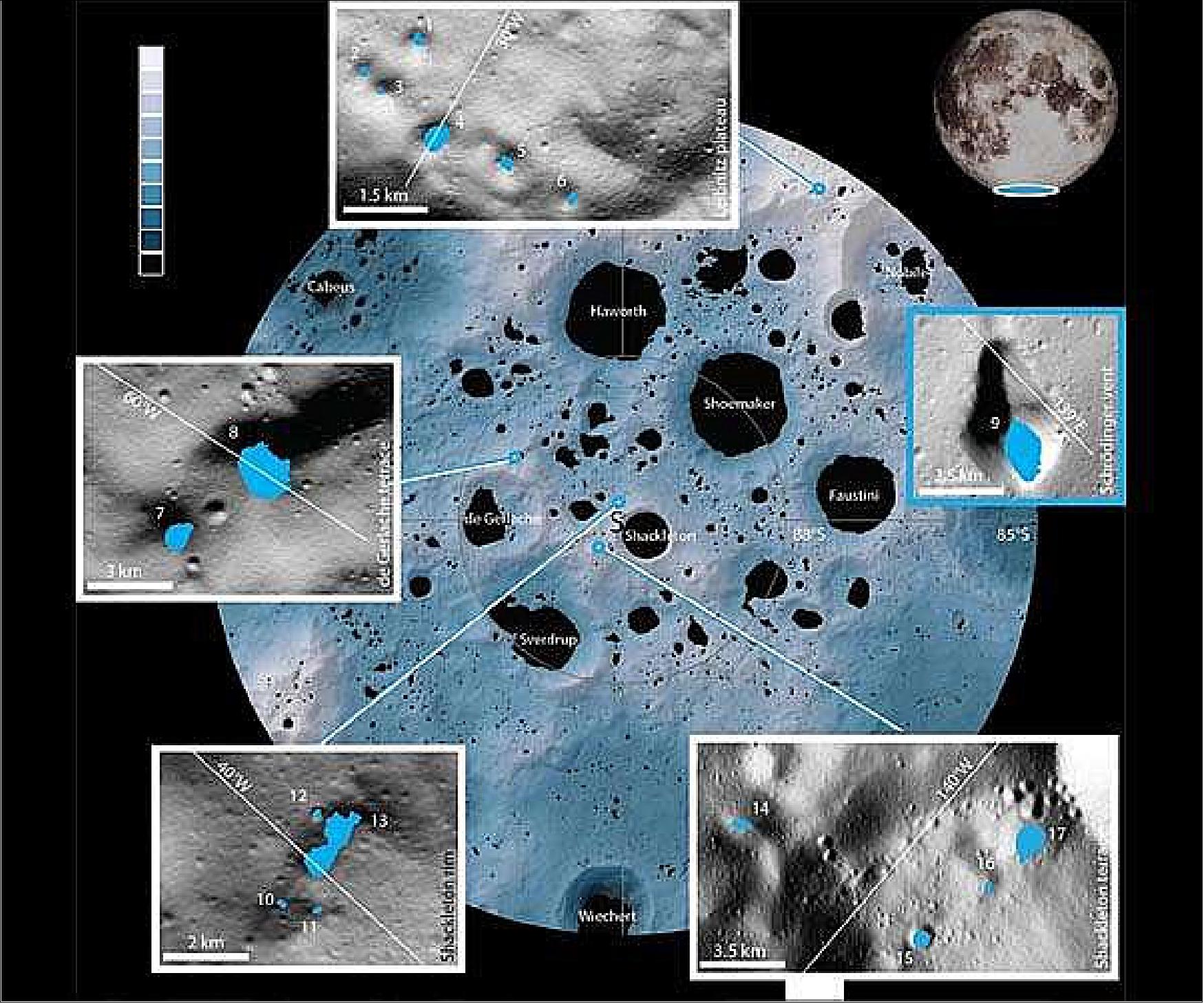
- "We also prepare to work with Russia to build the basic model of the lunar research station," Wu said in a recent interview. "The construction of the station will lay a solid foundation for us to better explore the lunar environment and resources, including how to use and develop lunar resources peacefully."
- The Chang'e-5 probe was launched in 2020, having retrieved a total of 1,731 grams of lunar samples. China is currently operating Chang'e-4 lander and the Yutu 2 rover on the far side of the moon. They made the first-ever soft landing on the Von Karman Crater in the South Pole-Aitken Basin on the lunar far side in 2019.
• November 2018: The image of Figure 5 was provided by Ref. 12) showing the preparations for the Chang'e-4 mission.
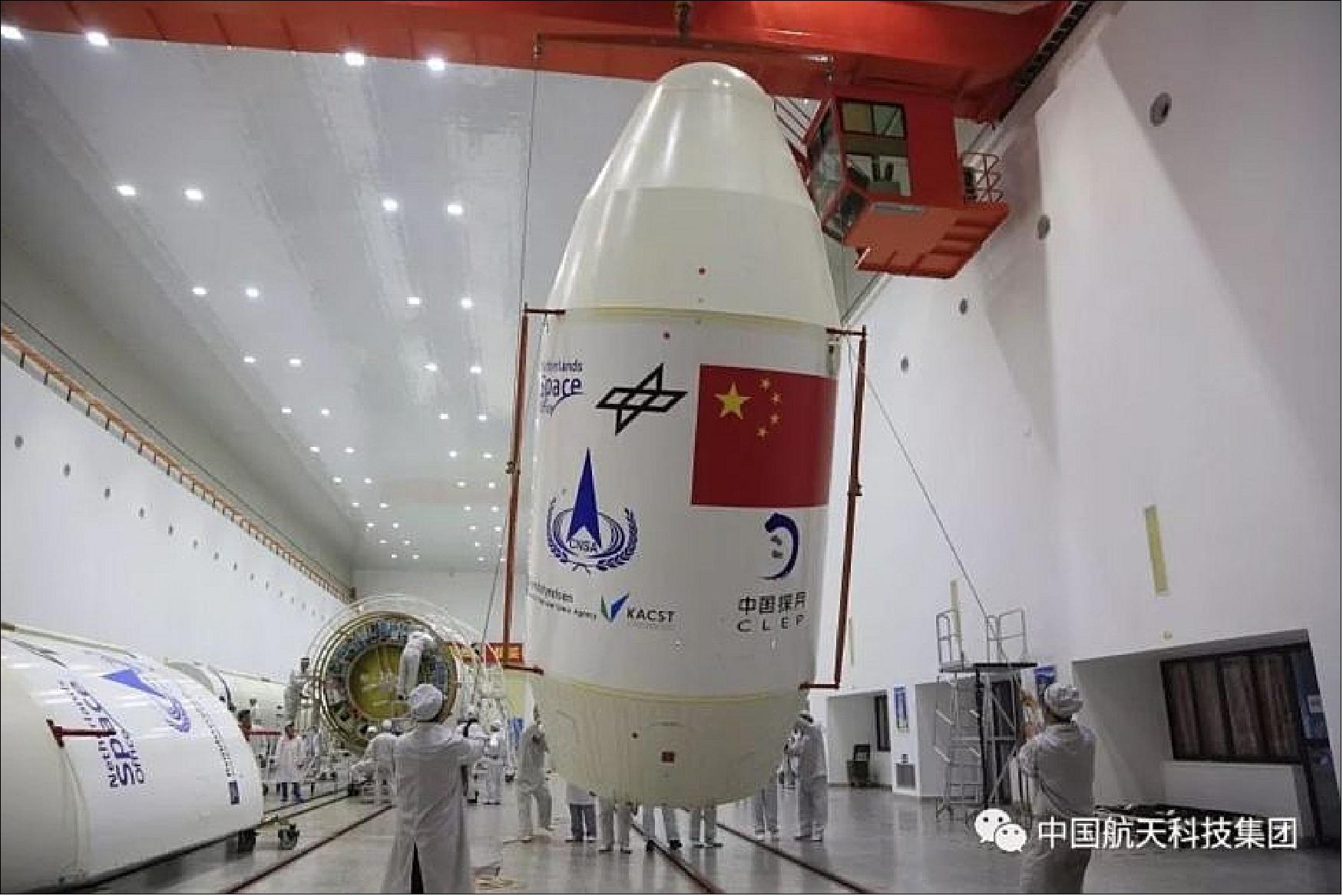
• On 16 August 2018, Chinese scientists unveiled their Chang'e 4 lander and rover mission, saying it will be launched in December 2018 on a mission to land on the far side of the moon. 11)
- The announcement was made at a news conference in Beijing, held by SASTIND (State Administration of Science, Technology and Industry for National Defense), which oversees China’s space activities. The configuration of the spacecraft and a contest to name the mission rover were also unveiled.
- The Chang’e-4 spacecraft will target a landing region within the South Pole-Aitken Basin, a vast impact crater of immense scientific interest, with potential landing areas previously identified in and around the Von Kármán crater. The final landing site is understood to have been selected but has not been revealed.

Legend to Figure 6: Visible on the newly released image of the lander are the antennas for the LFS (Low Frequency Spectrometer), which will take advantage of the uniquely quiet electromagnetic environment offered by the far side of the moon.
- Images displayed displayed at the press conference showed the rover was a rectangular box with two foldable solar panels and six wheels. It is 1.5 meters long, 1 meter wide and 1.1 meters high.
- Wu Weiren, chief engineer of China's lunar exploration program, said the Chang'e 4 consists of two parts - a lander and a rover, and both carry multiple scientific instruments. The probe's design is based on its predecessor, the Chang'e-3 (Yutu), but with some modifications.
Launch
The Chang'e-4 lander and rover mission was launched on 7 December 2018 (18:24 UTC, local time 02:24 on 8 December) from the XSLC (Xichang Satellite Launch Center) in the southwest of the country atop a Long March 3B/E launch vehicle (Ref. 11). 12) 13)
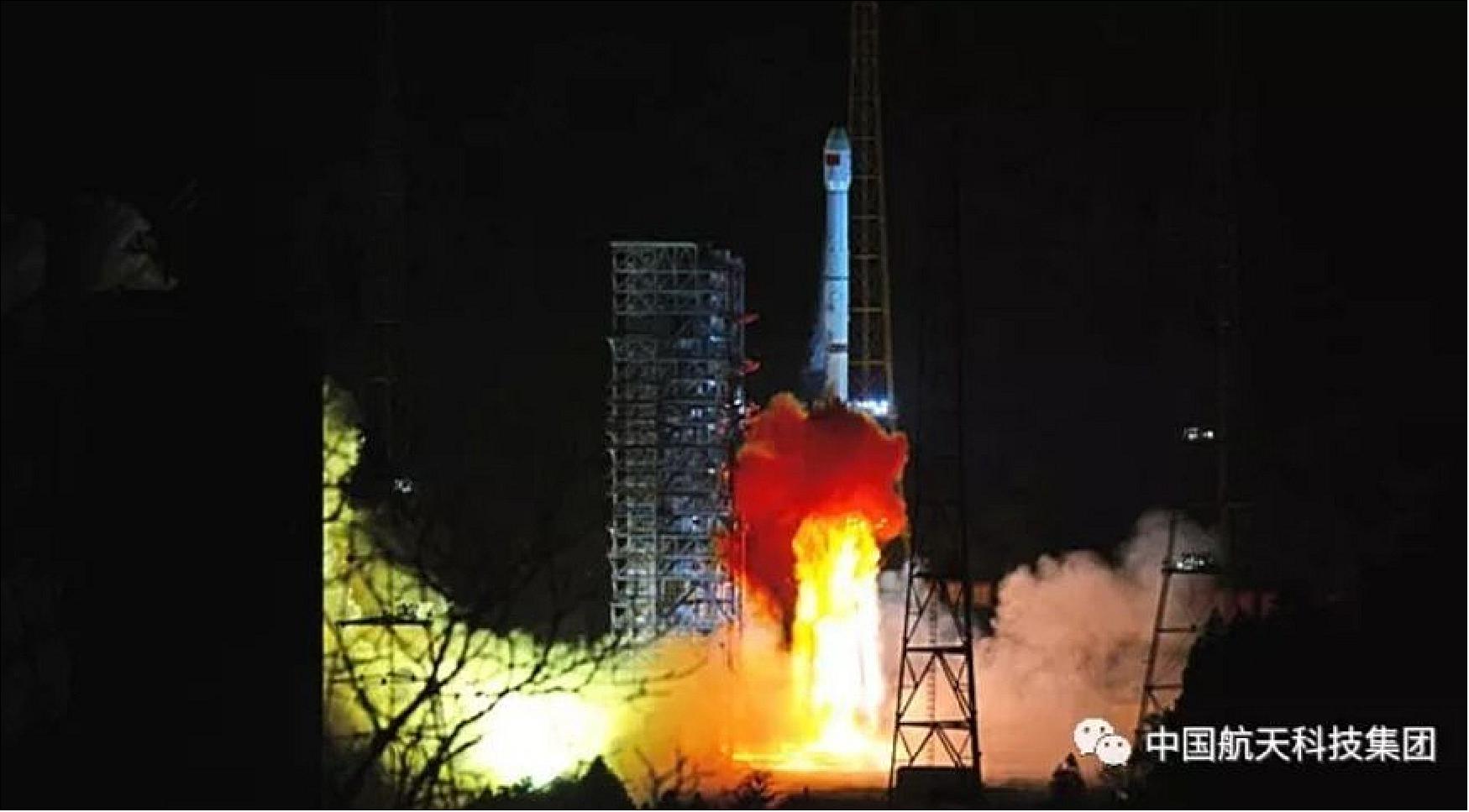
CASC (China Aerospace Science and Technology Corporation), the main contractor for China’s space program, officially announced success of the launch following trans-lunar injection, just under an hour after launch. The spacecraft now enters a five-day voyage to the moon before lunar orbit injection.
No official date has been released for the landing attempt, but CASC announced shortly after launch that the landing will take place in the first days of January 2019, following sunrise over the main candidate landing within the Von Kármán crater in late December.
As the far side of the moon never faces the Earth, communications with the spacecraft will be facilitated by the ‘Queqiao’ relay satellite launched in May and inserted into a halo orbit around the second Earth-moon Lagrange point in June 2018. - From this vantage point between 65,000-85,000 kilometers beyond the moon the Queqiao satellite will have constant line-of-sight with both the Chang’e-4 spacecraft and Chinese ground stations in China, at Kashi and Jiamusi, Namibia and Argentina.
Possible Landing Sites
The South Pole-Aitken Basin (SPA) is large—roughly 2,500 km in diameter. A number of teams, including some scientists from outside China, are looking at possible landing areas around Von Kármán crater and the Apollo basin. Phil Stooke, who produced a fascinating post on how China decides where to land its upcoming Moon missions, has listed and mapped the areas noted in papers on potential landing sites in the SPA, listed S1 through S5 (Ref. 90).
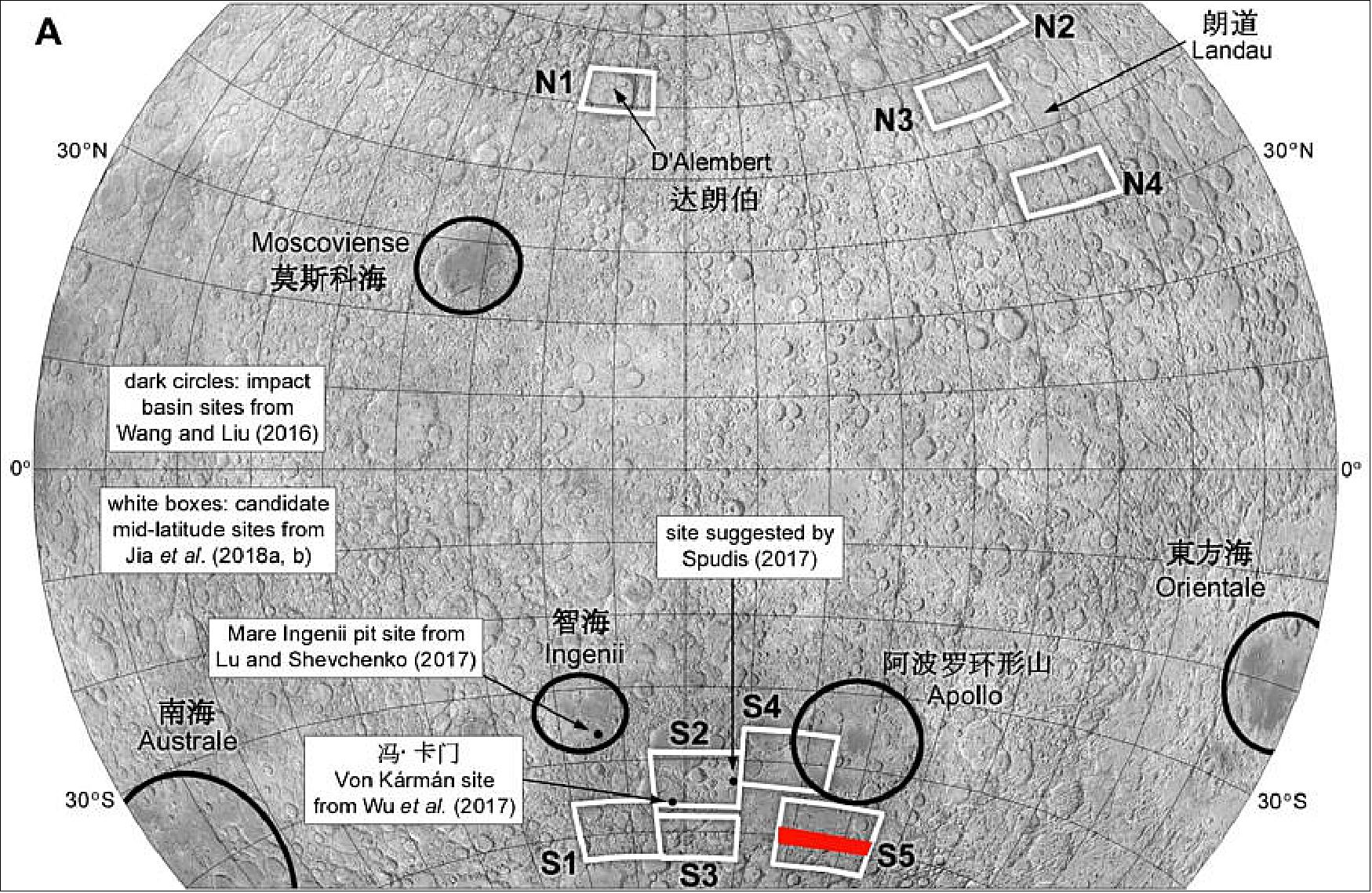
The candidate landing region is 45°S-46°S and 176.4°E-178.8°E, which is in the southern floor of the Von Kármán crater, within the SPA basin (Figure 9a). Von Kármán is a pre-Nectarian crater of 180 km in diameter. Mare basalt flows filled the crater floor subsequently at ~3.35 Ga, but a portion of possible central peak remains near the center of the crater (Figure 9 b). NRC (National Research Council) has previously identified goals for future sample return mission in Von Kármán crater, including the possibility to study the existence and extent of differentiation of the SPA melt sheet and possible exposed upper mantle materials. 14)
The Chang'e-4 project analyzed the topography of the candidate landing region using the LRO (Lunar Reconnaissance Orbiter) LOLA (Lunar Orbiter Laser Altimeter) and Kaguya (Selene mission of JAXA) TC (Terrain Camera) merged DEM (Digital Elevation Model), the spatial sampling is 512 ppd (59 m/pixel). Spectral analyses were performed using the Kaguya Multiband Imager (MI) and Chandrayaan-1 M3 (Moon Mineralogy Mapper) data. Geomorphologic characteristics were studied with LRO WAC (Wide Angle Camera), NAC (Narrow Angle Camera), and TC images.
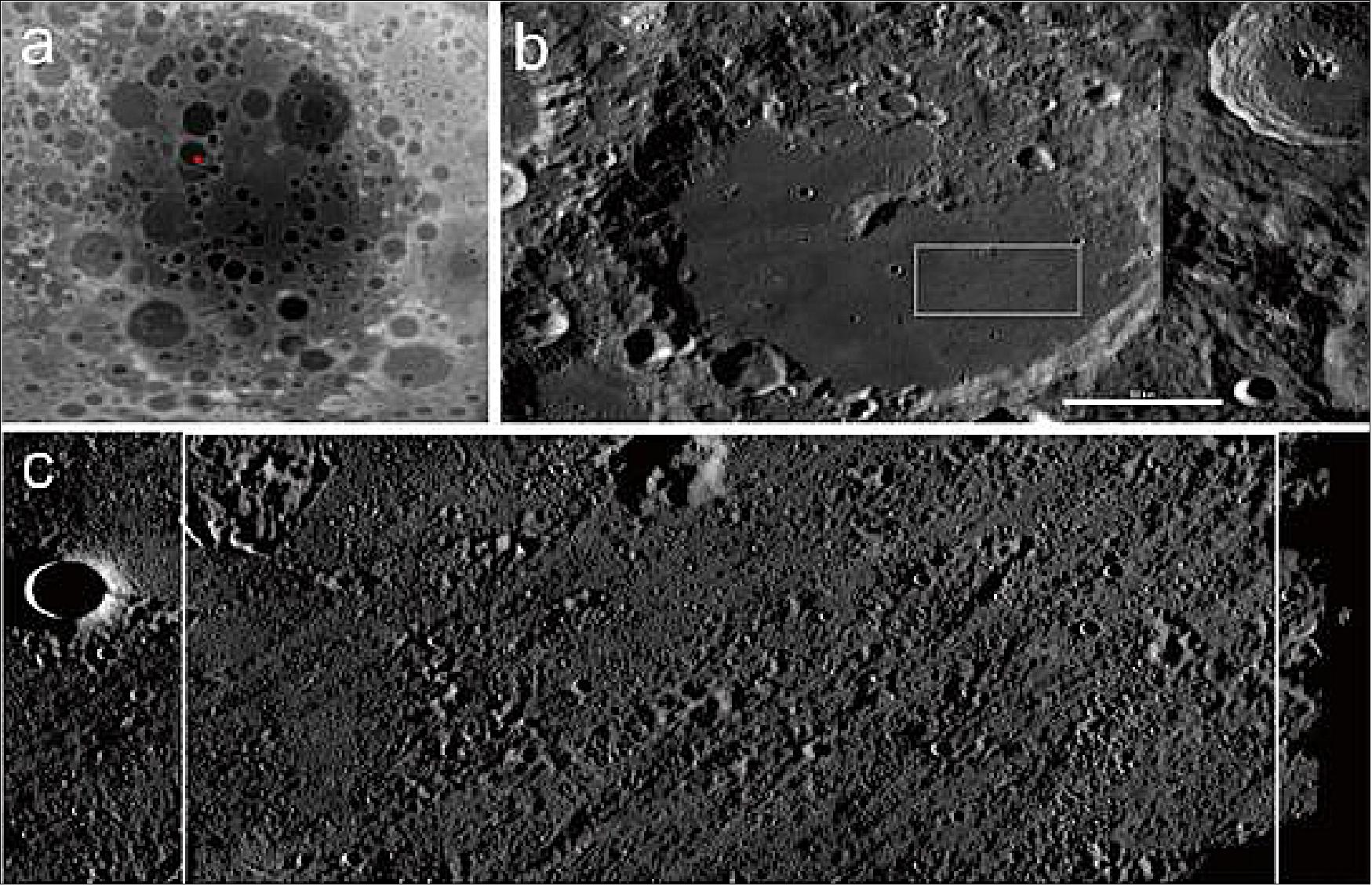
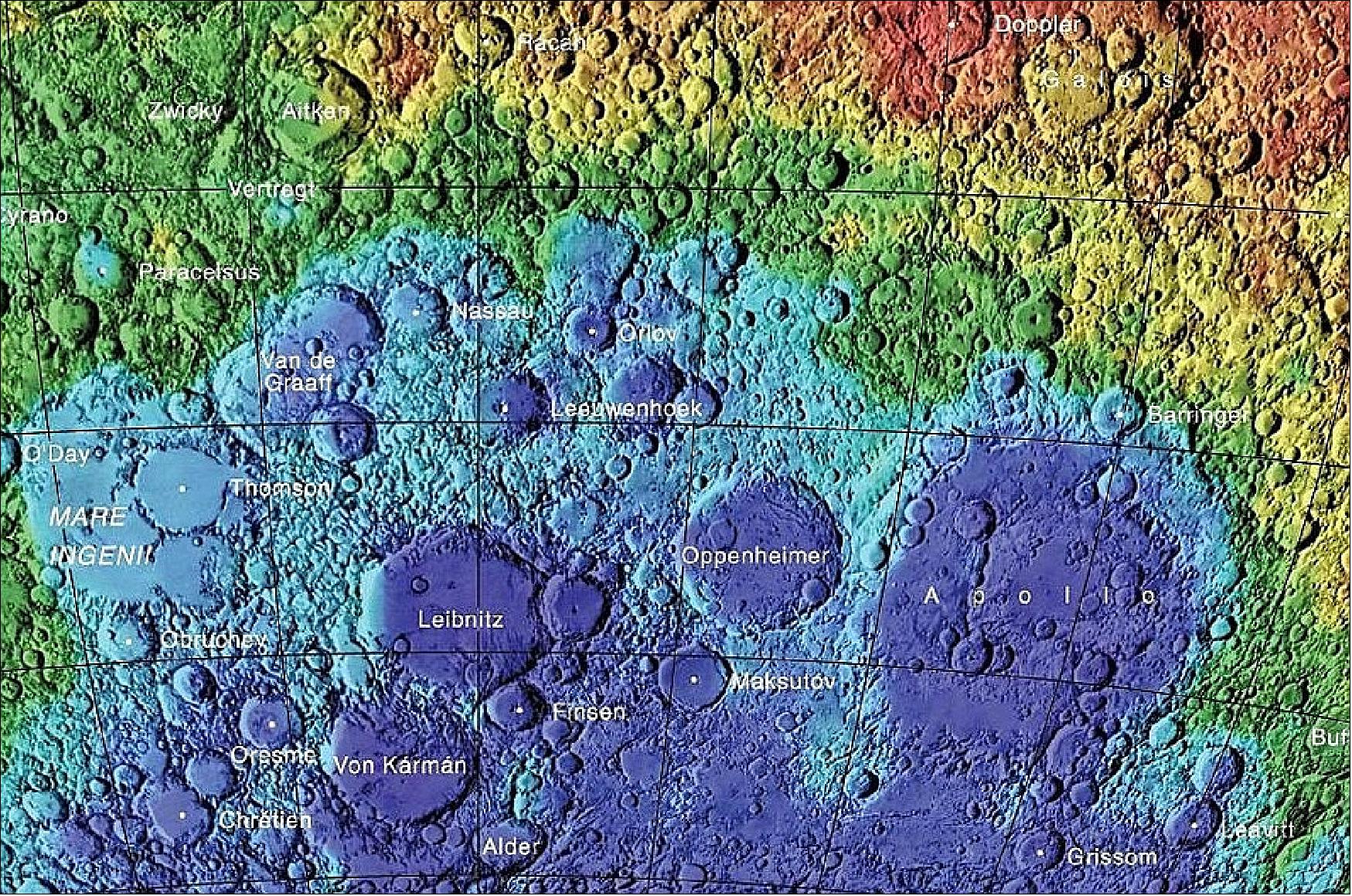
Power Descent
The following two aspects are carried out during the power descent phase: first, the oblique forward motion trajectory is changed to the vertical down trajectory after the main deceleration phase. Furthermore, the pointing of ranging is consistent with the location of the landing point. Second, in order to ensure the correctness of navigation results in altitude, the range sensor is introduced to modify the navigation filtering algorithm. The power descent of Chang'E-4 is shown in Figure 11. 15)

Mission Status
• December 08, 2021: The cube-like object spotted recently by China's lunar rover on the far side of the moon aroused wild curiosity in cyberspace worldwide this week. 16)
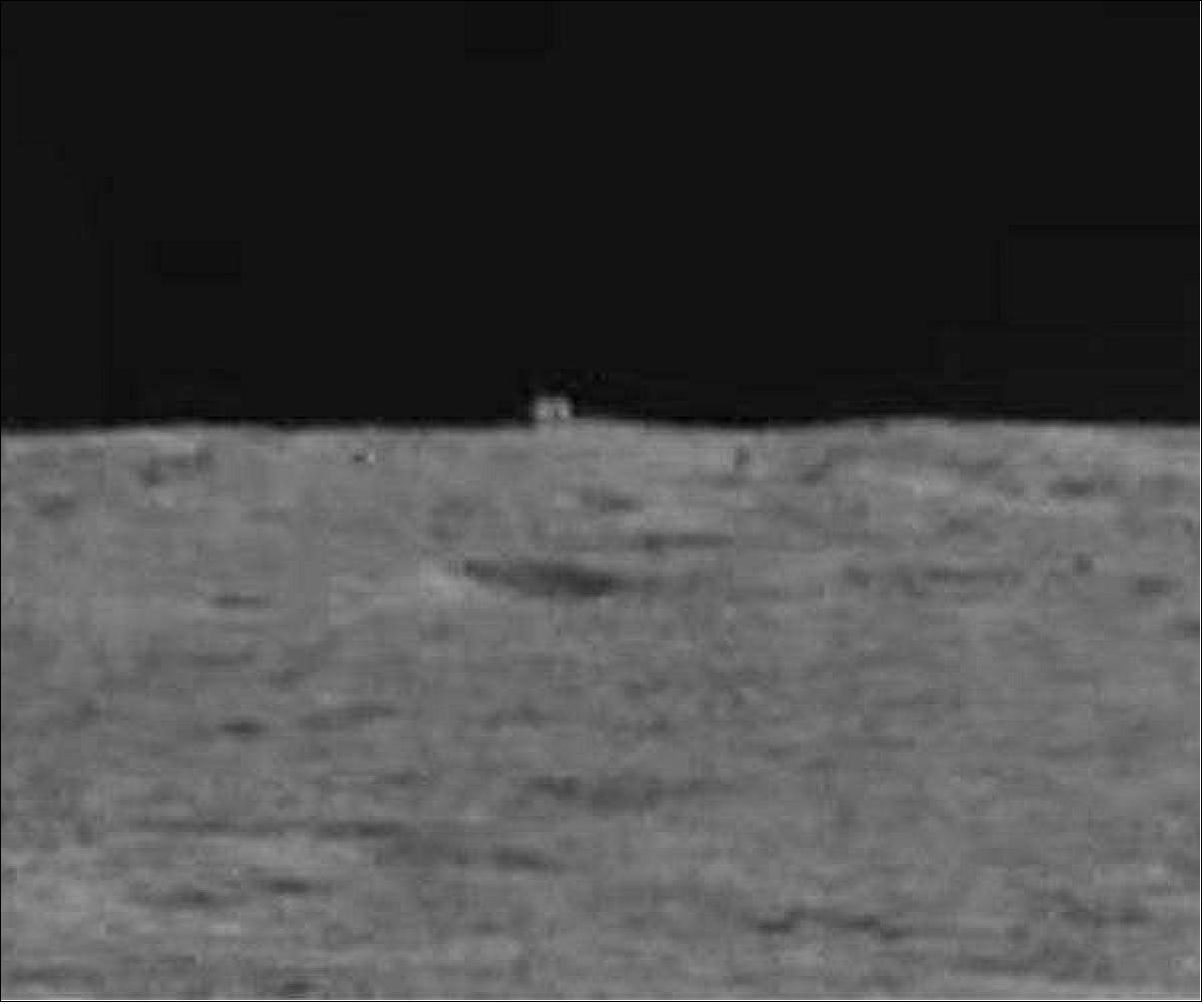
- Something cubic loomed on the horizon to the north, sitting next to a young impact crater, said the rover's log. The image sparked heated debates on social media platforms.
- Some described it as the remains of one of the smaller rocks that has collided with the moon. This was echoed by space journalist Andrew Jones, who considered it as a large boulder.
- There is no shortage of sensational explanations, however. "There seems to be a lot of straight lines in this feature, that's very uncommon in nature, which is normally fractal-based," tweeted "Viu Mobile," an astronomical amateur from Texas, on Monday.
- It might be "some structure from an ancient civilization on the Moon," tweeted David Michaels.
- More people tend to make fun of it. It has been imagined as Arc de Triomphe in Paris, the Marble Arch in London, the barbette of naval guns and a handle of the moon like that of a kettle-bell.
- A Chinese online user at weibo.com compared it to the Guanghan Palace, where the goddess of the moon lives in ancient Chinese mythology.
- Now the blurry cube image has become a cyberspace meme. Some even used computer graphics to enhance the picture, jokingly, into a Minecraft portal or a Nissan minicar.
- Other netizens dealt with it seriously. "The photo is a rock formation that, due to lighting and angle, looks vaguely like something humans could have made," tweeted "SkepticalSinik." "(It is) Pareidolia effect; we want to see something, so we do."
- "It's not an obelisk or aliens, but certainly something to check out," said Jones.
- Yutu 2 will spend the next two to three months getting a closer look at the object, according to Our Space.
- The Chang'e 4 probe, launched on Dec 8, 2018, made the first-ever soft landing on the Von Karman Crater in the South Pole-Aitken Basin on the far side of the moon on Jan 3, 2019.
• April 08, 2021: The lander and rover of the Chang'e-4 probe have resumed work for a 29th lunar day on the far side of the moon. 17)
- The lander woke up at 9:43 pm Tuesday (Beijing Time), and the rover, Yutu-2 (Jade Rabbit-2), awoke at 3:54 am Tuesday (6 April), according to the Lunar Exploration and Space Program Center of the China National Space Administration.
- The Chang'e 4 probe, switching to dormant mode during the lunar night due to the lack of solar power, has survived about 825 Earth days on the moon. A lunar day is equal to 14 days on Earth, and a lunar night is the same length.
- Located in the northwest of Chang'e 4's landing site, the rover has traveled about 682.8 meters. The linear distance between the rover and the landing site is about 455 meters.
- During its 29th lunar day, the rover will continue to move northwest toward the basalt distribution area located about 1.2 km away from the rover.
- The equipment aboard the rover, including a panoramic camera, an infrared imaging spectrometer, a neutral atom detector and a lunar radar, will continue to carry out scientific explorations.
• January 11, 2021: The lander and rover of the Chang'e-4 probe have resumed work for the 26th lunar day on the far side of the moon. 18)
- The lander woke up at 3:13 a.m. on Friday (Beijing time, 8 January), and the rover Yutu-2, or Jade Rabbit-2, woke up at 10:29 a.m. on Thursday (7 January), according to the Lunar Exploration and Space Program Center of the China National Space Administration.
- Landing on the moon on Jan. 3, 2019, the Chang'e-4 probe has survived 736 Earth days on the moon.
- During the 26th lunar day, Yutu-2 will move northwest toward the basalt area or the impact craters with high reflectivity.
- Yutu-2 will take panoramic photos, and its infrared imaging spectrometer, neutral atom detector and lunar radar will continue to carry out scientific explorations. Research teams will analyze the detection data and release the scientific results.
• December 25, 2020: China's lunar rover Yutu-2, or Jade Rabbit-2, has survived 719 Earth days and traveled 600.55 meters on the far side of the moon as of Tuesday. 19)
- Both the lander and the rover of the Chang'e-4 probe have ended their work for the 25th lunar day, and switched to the dormant mode for the lunar night due to the lack of solar power, according to the Lunar Exploration and Space Program Center of the China National Space Administration.
- Next lunar mission to sample pole or far side: China plans to use its next moon mission, Chang'e-6, to collect samples from the moon's south pole or possibly the celestial body's far side, according to a key figure in the nation's lunar exploration program.
- Yanhua Wu, deputy head of China National Space Administration, told China Daily on Thursday after a news conference in Beijing that project managers' current plans call for the Chang'e-6 robotic probe to land on the lunar south pole.
- "But if the Queqiao (relay satellite) still functions well by the time we launch Chang'e-6, we may also consider sending it to the far side to take some samples there," he said. "This is because there has never been a mission to return samples from the far side, and if we do so ...that will be very meaningful to scientists around the world."
- The official said that deploying a mission to return samples from the far side, which always faces away from the Earth, would incur some risk, but it would be worth it for the sake of advancing knowledge about a little-known area.
- In December 2018, China launched its fourth lunar probe, Chang'e-4, with the far side as its destination. The spacecraft made a soft landing in January 2019 at the Von Karman Crater in the South Pole-Aitken Basin of the far side, inaugurating mankind's first close observation of what is also known as the "dark side of the moon".
- Queqiao, the satellite responsible for relaying signals between Chang'e-4 and ground control, was launched in May 2018.
- Chang'e-4, which remains operational, has enabled scientists to learn things about the moon, deepening knowledge of the early history of the extraterrestrial body and the solar system. The mission's Yutu 2 rover, the second of its kind made by China and the world's first to reach the far side, has become the second-longest operational rover on the moon.
- Wu also mentioned the planned Chang'e-7 and -8 missions at the news conference, saying that among their many goals, a major one will be to explore the technological feasibility of international cooperation on jointly building a robotic scientific research outpost on the moon.
- He did not reveal detailed schedules for those missions, saying only that they will be conducted in the coming 15 years.
- The space administration has previously disclosed that Chang'e-7 is set to conduct a specific investigation of the lunar south pole's environment and resources while Chang'e-8 will be tasked with testing and verifying cutting-edge technologies that may be applied in future moon expeditions.
- As to whether China will undertake manned lunar missions, Wu said the decision will be made after the nation puts its manned space station into service, which is scheduled to take place in 2022.
• November 25, 2020: China's Yutu 2 rover has been operating on the lunar surface for 692 Earth days, cementing its status as the second-longest-working rover on the moon, the China National Space Administration (CNSA) said. 20)
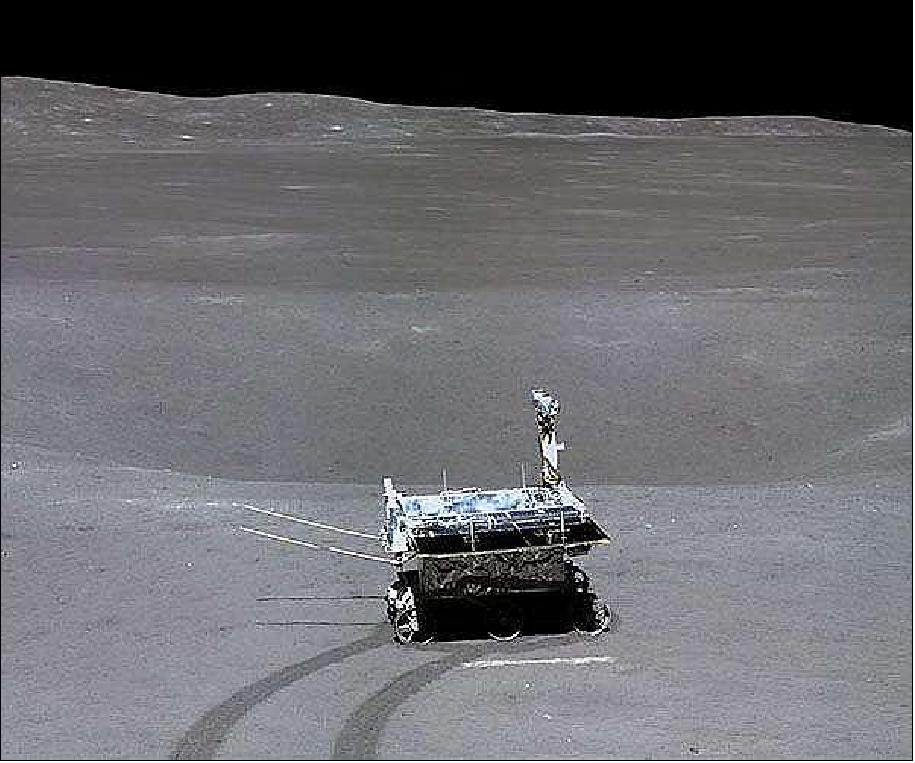
- The second Chinese lunar rover, Yutu 2 is part of the ongoing Chang'e-4 mission, humanity's first endeavor to land on and closely observe the far side of the moon. The rover has traveled nearly 590 meters since it was deployed on January 3 last year.
- The administration said Chang'e-4's lander and the rover have finished their 24th lunar-day working session and are now in a dormant state for the lunar night.
- A lunar day equals 14 days on Earth, as does a lunar night. During the lunar night, the temperature falls below -180º C, and there is no sunlight to provide power to the probe.
- During the most recent lunar day, which started on Nov. 9, Yutu 2 continued moving to the northwest of Chang'e-4's landing site in the South Pole-Aitken Basin, one of the largest and deepest known basins in the solar system.
- The four scientific instruments mounted on the vehicle - a panoramic camera, a lunar penetrating radar, a visible and near-infrared imaging spectrometer and the Swedish-developed Advanced Small Analyzer for Neutrals - were activated to conduct scientific investigations.
- Their findings during the working session will be used to help scientists reveal the origins of substances beneath the South Pole-Aitken Basin, the space administration said.
- Designed and built by China Aerospace Science and Technology Corp (CAST), Yutu 2 has six wheels, two solar panels and a radar dish and weighs 140 kg.
- The record for the longest-working rover on the moon is held by Yutu, China's first lunar rover, which worked on the moon for 972 days, far outliving its designed life span of three months.
- It was deployed by the lander of the Chang'e-3 probe, the first Chinese spacecraft to touch down on the moon, in December 2013. Several scientific devices on the lander are still producing data after more than 2,500 days on the near side of the moon, the space administration said.
• October 27, 2020: The lander and the rover of the Chang'e-4 probe have been switched to the dormant mode for the lunar night after working stably for the 23rd lunar day, according to the Lunar Exploration and Space Program Center of the China National Space Administration. 21)
- The lander was switched to dormant mode at 9:40 pm Friday (Beijing Time) as scheduled, and the rover, Yutu 2 (Jade Rabbit-2), at 12 noon Friday, said the center.
- A lunar day is equal to 14 days on Earth, and a lunar night is the same length. The Chang'e-4 probe, which switched to dormant mode during the lunar night due to the lack of solar power, had been on the far side of the moon for 660 Earth days as of Saturday, and the rover has traveled 565.9 meters.
- During the 23rd lunar day, Yutu 2 went northwest, traveling toward an area with basalt and an impact crater area with high reflectivity. En route to the destination, the near-infrared spectrometer on the rover was used to detect a rock about 30 cm in diameter. The research team is analyzing the transmitted data.
- Scientists carried out the first systematically documented measurements of radiation on the moon with data acquired by the neutron radiation detector onboard. According to the study published in the journal Science Advances, the moon's surface is highly radioactive, approximately two to three times the International Space Station, five to ten times a civil flight, and 300 times the surface of the earth of Beijing.
- The study provided a reference for the estimation of the lunar surface radiation hazards and the design of radiation protection for future lunar astronauts.
• October 13, 2020: The lander and rover of the Chang'e-4 probe have resumed work for the 23rd lunar day on the far side of the moon. 22)
- The lander woke up at 11:56 a.m. Sunday, Beijing Time, and the rover Yutu-2, or Jade Rabbit-2, woke up at 6:57 p.m. Saturday, said sources with the Lunar Exploration and Space Program Center of the China National Space Administration.
- A lunar day is equal to 14 days on Earth, and a lunar night is of the same length. The solar-powered probe switches to dormant mode during the lunar night.
- Landing on the moon on Jan. 3, 2019, the Chang'e-4 probe has survived about 647 Earth days on the moon.
- During the 23rd lunar day, Yutu-2 will move northwest toward the basalt area or the impact craters with high reflectivity. It will also use an infrared imaging spectrometer onboard to carry out the scientific detection of a lunar rock, which has a diameter of 30 cm, according to the center.
- The rover has far exceeded its three-month design lifespan, becoming the longest-working lunar rover on the moon.
• September 25, 2020: The Chang'e-4 lunar lander touched down on the far side of the Moon on 3 January 2019, with a German instrument for measuring space radiation on board. Since then, the Lunar Lander Neutron and Dosimetry (LND) instrument has been measuring temporally resolved cosmic radiation for the first time. Earlier devices could only record the entire 'mission dose'. In its current issue, the scientific journal Science Advances reports on the work of the international group of scientists involved with the LND, including researchers from the German Aerospace Center (Deutsches Zentrum für Luft- und Raumfahrt; DLR). Their investigations have involved more precise radiation measurements on the Moon. 23) 24)
- "Over the coming years and decades, various nations are planning to send crewed missions to explore the Moon. Space radiation poses a significant risk to the health of humans. The Apollo astronauts carried radiation measuring devices, referred to as dosimeters, on their bodies. But these only determined the radiation exposure over the course of the entire mission," says Oliver Angerer, LND Project Manager at the DLR Space Administration. With the LND instrument it is possible to measure the various characteristics of the radiation field over time intervals of one, 10 or 60 minutes. This enables researchers to calculate the 'equivalent dose', which is important for estimating biological effects.
High Radiation Exposure in a Spacesuit
- DLR radiation physicist Thomas Berger from the DLR Institute of Aerospace Medicine, who participated in the publication explains: "The radiation exposure we measured is a good indication of the radiation inside a spacesuit. The measurements give us an equivalent dose rate – the biologically weighted radiation dose per unit of time – of around 60 microsieverts per hour. For comparison, during a long-haul flight from Frankfurt to New York, the dose rate is five to 10 times lower than this. On Earth's surface, it is some 200 times lower. In other words, a long-term stay on the Moon will expose astronauts' bodies to high doses of radiation."
- "Human bodies are simply not made to be exposed to space radiation," adds Robert Wimmer-Schweingruber of the Christian-Albrecht University (CAU) in Kiel, whose team developed and built the LND instrument. "On longer missions to the Moon, astronauts will have to protect themselves from it – by covering their habitat with a thick layer of lunar rock, for example. This could reduce the risk of cancer and other illnesses caused by long periods of time spent on the Moon."
- The instrument developed in Kiel conducts measurements throughout the lunar day, but like all other scientific devices on the lander, remains switched off throughout the extremely cold, approximately two-week lunar night, to save power. The instrument and lander were designed to conduct their measurements for at least one year – a target they have already surpassed. The data from the LND and the lander are transmitted to Earth via the relay satellite Queqiao ('Magpie Bridge'), which is located above the far side of the Moon.
Astronautical Space Exploration on the Moon and Beyond
- The radiation data are also relevant for future interplanetary missions. Since the Moon has neither a protective magnetic field nor an atmosphere, the radiation field on the Moon's surface is similar to that in interplanetary space. "With that in mind, the LND measurements are also used to develop computer models to calculate the expected radiation exposure, refine our models and thus contribute towards our work on radiation protection for astronauts on future missions. It is vital that the detector also allows conclusions to be drawn about the composition of the radiation field, such as how many neutrons and high energy-charged particles are present," explains Berger.
Funding
- The Lunar Lander Neutron and Dosimetry (LND) instrument was developed and built at the Christian-Albrecht University of Kiel on behalf of the DLR Space Administration with funding from the German Federal Ministry of Economic Affairs and Energy (Bundesministerium für Wirtschaft und Energie; BMWi). The research conducted by the DLR Institute of Aerospace Medicine is supported by the Moon and Mars Exploration Studies (MoSES) project, which is part of DLR's Space Exploration Program.
• September 14, 2020: The lander and rover of the Chang'e-4 probe have resumed work for the 22nd lunar day on the far side of the moon. 25)
- The lander woke up at 5:15 a.m. on Saturday (Beijing time, 12 Sept.), and the rover Yutu-2, or Jade Rabbit-2, woke up at 11:54 a.m. on Friday (11 Sept.), sources with the Lunar Exploration and Space Program Center of the China National Space Administration said.
- According to the center, Yutu-2 will move northwest toward the basalt area or the impact craters with high reflectivity during the 22nd lunar day. Scientific instruments such as a panoramic camera, infrared imaging spectrometer, neutral atom detector, as well as lunar radar on the rover will carry out scientific detection.
- The solar-powered rover has far exceeded its three-month design lifespan, becoming the longest-working lunar rover on the moon.
• September 10, 2020: Based on data from China's Chang'e-4 probe, Chinese scientists have determined the thickness of the regolith and revealed the fine subsurface structures and evolutionary history of the probe's landing site on the moon's far side. 26)
- The study revealed that the landing area of the probe, located within the largest and oldest impact basin on the moon, had experienced multiple impact events and basalt magma eruptions.
- Carrying scientific instruments including a lunar penetrating radar, the rover Yutu-2 has conducted scientific detection on the compositions of lunar surface materials and the subsurface structures.
- Scientists from the Institute of Geology and Geophysics (IGG) under the Chinese Academy of Sciences (CAS), the Aerospace Information Research Institute under the CAS, the Macao University of Science and Technology and other institutes have carried out research on the lunar penetrating radar onboard Yutu-2 during the first three lunar days and obtained important findings on the subsurface structure of the landing area.
- The results showed that the materials detected by Yutu-2 come from the nearby Finsen impact crater rather than the basalt erupted from the lunar mantle, which filled the bottom of the Von Karman Crater. It was also revealed that the landing area had experienced multiple impact events and basalt magma eruptions.
- The new discoveries are of great significance to understanding the evolutionary history of the South Pole-Aitken basin of the moon, as well as to the following exploration and research on the composition and structure of the lunar interior, said Yangting Lin , a researcher with the IGG.
- Asteroid impacts are an important driving force for the early evolution of the Earth. However, the long-term geological tectonic activities have erased most of the traces of the impact cratering events on Earth, experts said.
- The internal evolution of the moon has long ceased due to its small mass. Therefore, impact craters and the deposit profile of crater ejecta on the lunar surface have recorded the impact history of asteroids in the earth-moon system.
- According to Lin, the subsurface structure of the moon recorded the number and scale of large-scale impact events and magma eruptions, as well as their temporal and spatial relationships. However, the fine structure of the moon's shallow layers remains a mystery to humans.
- The modification of lunar surface materials by asteroid impacts has a direct influence on the results obtained from orbital observations and landing site reconnaissance, and affects how scientists will implement the lunar sample return missions in the future, Lin said.
- The study was published in the latest issue of Nature Astronomy. 27)
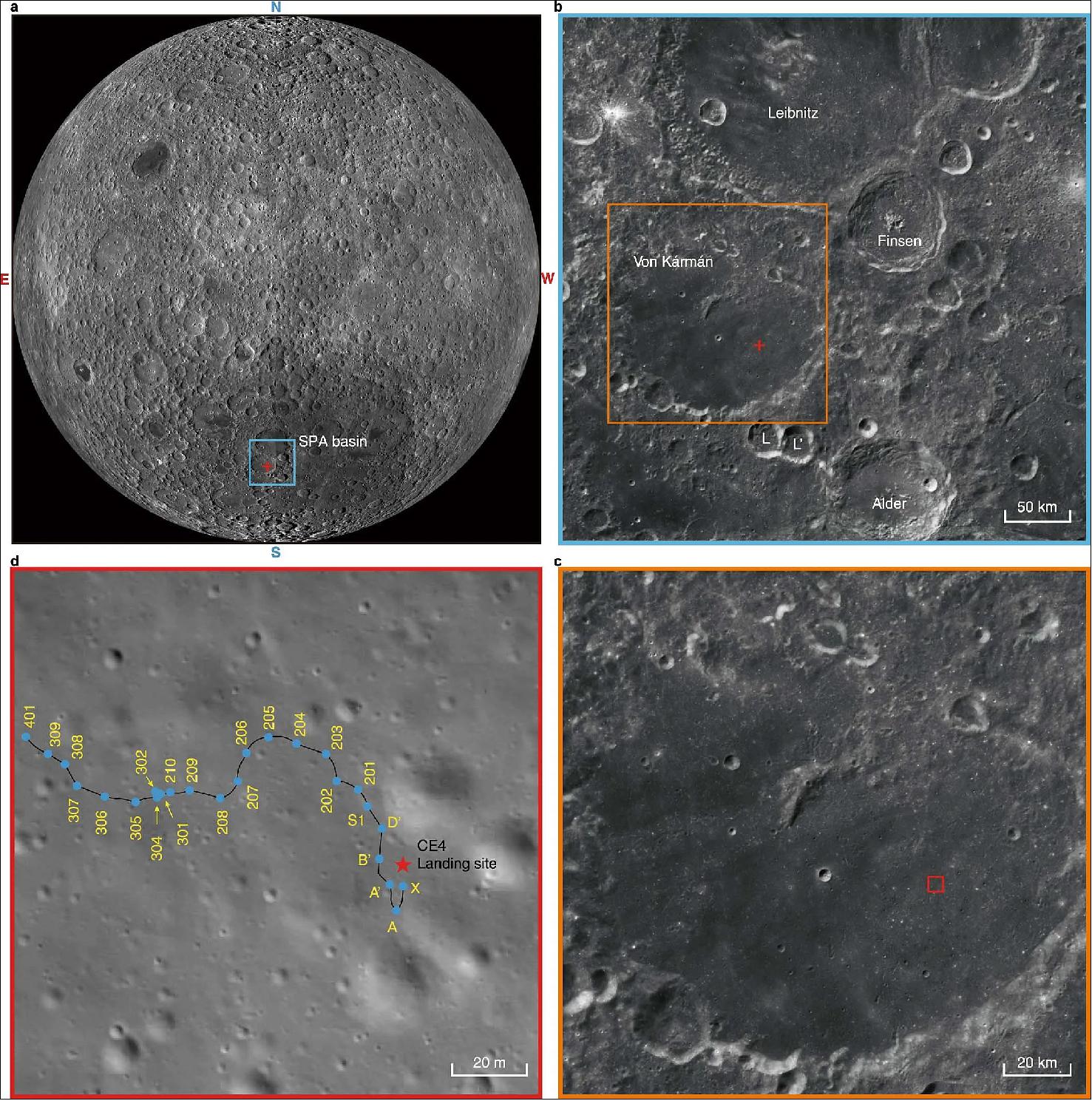
• September 1, 2020: China's Chang'e-4 probe has survived more than 600 Earth days on the far side of the moon while conducting scientific explorations. 29)
- With a variety of scientific gear on board, the Chinese lunar probe observed and measured the exotic land, offering unprecedented views and understanding of the far side of the moon and beyond.
- As of August 26, the lander and the rover of the Chang'e-4 probe have completed work for the 21st lunar day on the far side of the moon and is currently in dormant mode during the lunar night due to lack of solar power, according to the Lunar Exploration and Space Program Center of the China National Space Administration.
- On August 25 was the 600th day of Chang'e-4 on the moon and the rover had traveled 519.29 meters.
- The rover Yutu-2 (Jade Rabbit-2), has far exceeded its three-month design lifespan, becoming the longest-working lunar rover on the moon.
- With the help of data transmitted to Earth, Chinese researchers have made progress in vital research such as the moon's geological evolution, radiation and low-frequency radio environment.
• August 16, 2020: The lander and rover of the Chang'e-4 probe have resumed work for the 21st lunar day on the far side of the moon. 30)
- The lander woke up at 14:54 Thursday (13 August, Beijing Time) while the rover awoke at 20:34 Wednesday. Both are in normal working order, according to the Lunar Exploration and Space Program Center of the China National Space Administration.
- The rover will continue to move northwest toward the basalt area or the impact craters with high reflectivity, according to the center.
- The panoramic camera, near-infrared spectrometer, neutral atom detector and lunar radar of the rover will continue to carry out planned scientific exploration.
• July 21, 2020: The unusual dark greenish and glistening 'gel-like' substance in a crater on the far side of the moon has attracted widespread interest following its discovery by the Chang'e-4 rover in July 2019. 31)
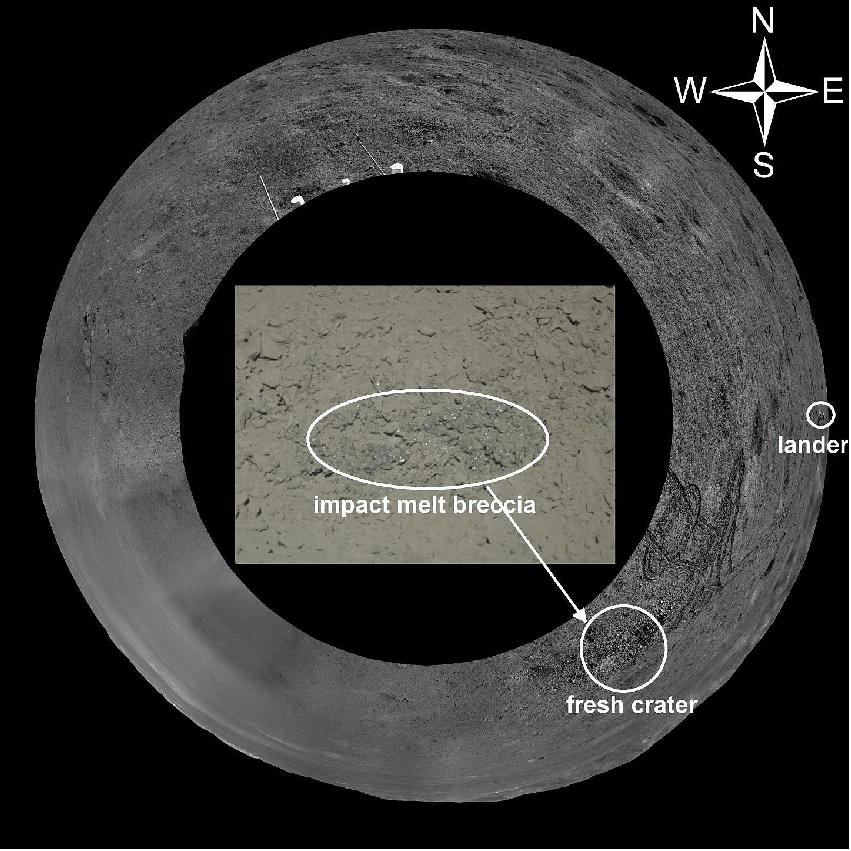
- A research team led by Prof. Di Kaichang from the Aerospace Information Research Institute (AIR) of the Chinese Academy of Sciences and their collaborators analyzed the substance in detail by using multiple datasets from the rover's panoramic camera (Pancam), hazard avoidance camera (Hazcam), and VNIS (Visible and Near-Infrared Spectrometer).
- The researchers found that the unusual substance is actually an impact melt breccia, and the provenance of the rover measured surrounding regolith might originate from a differentiated melt pool or from a suite of igneous rocks. Their findings were published in Earth and Planetary Science Letters. 32)
- China's Chang'e-4 probe, including a lander and a rover, successfully touched down within the 185-km-wide Von Kármán crater inside the South Pole-Aitken (SPA) basin on January 3, 2019, making the first-ever soft landing on the lunar far side.
- The gel-like substance was discovered in a crater during the eighth lunar day of the rover's mission. Detailed measurements on the breccia and surrounding regolith were conducted during the ninth lunar day.
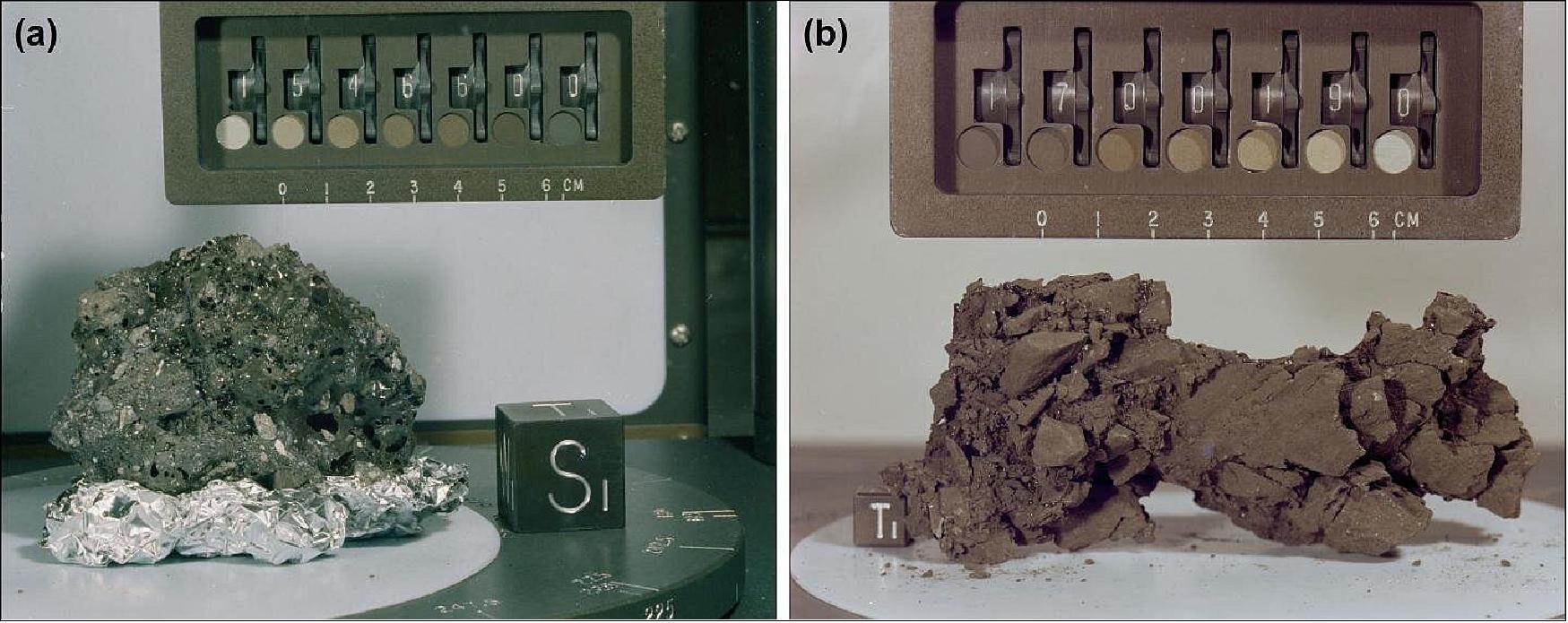
- The discovered breccia, measuring 52 by 16 centimeters, resembles the lunar impact melt breccia samples 15466 and 70019 returned by the Apollo missions. It was formed by impact-generated welding, cementing and agglutinating of lunar regolith and breccia.
- Clods surrounding the breccia-hosting crater were crushed into regolith powders by the rover's wheels, indicating the regolith may be compacted slightly and becomes blocky and friable. Hapke model-based spectral unmixing results showed that plagioclase was abundant, and pyroxene and olivine had almost equal fractions, indicating the regolith was likely the weathering products of noritic rocks.
- The regolith measured by Chang'e-4 rover was actually a mixture of multiple sources, with ejecta from Finsen crater being primary and possible contributions from Alder crater. Finsen and Alder craters are on the margin of the proposed impact melt pool produced by the SPA basin-forming event. Therefore, the provenance of the regolith might originate from a differentiated melt pool or from a suite of igneous rocks.
• July 09, 2020: Scientists have identified the 'gel-like' substance the Yutu-2 rover mission discovered on the far side of the moon a year ago, according to a study published this week in Earth and Planetary Science Letters. 33) 34)
- Through an analysis of the images and comparison with Apollo samples on earth, researchers found that the substance was rock — and more specifically, rock that likely melted together from a meteorite impact.
- "Chang'e-4 rover discovered a dark greenish and glistening impact melt breccia in a crater during its traverse on the floor of Von Karman crater within the South Pole Aitken (SPA) basin on the lunar farside," researchers wrote in the study. "It was formed by impact-generated welding, cementing and agglutinating of lunar regolith and breccia."
- The Chinese Yutu-2 rover team made the discovery in a small crater on a Chang'e-4 mission to explore the far side of the moon on July 2019.
- The next month, in a study about the finding, researchers described the substance as dark greenish and glistening "gel-like" material, measuring 20 inches by 6 inches (52 x 16 cm), possibly indicating the presence of glass from impact melt or volcanic eruptions.
- The substance was similar to samples retrieved by Apollo 15 and Apollo 17 missions, the researchers said. Those samples were retrieved from impact craters and classified as breccia, chunks of rock cemented together by finer material to form larger rocks.
- The cement for lunar regolith was black glass in both cases, researchers said.
• May 01, 2020: China's lunar rover Yutu-2, or Jade Rabbit-2, has driven 447.68 meters on the far side of the moon to conduct scientific exploration of the virgin territory. 35)
• April 17, 2020: The lander and rover of the Chang'e-4 probe have resumed work for the 17th lunar day on the far side of the moon after "sleeping" during the extremely cold night. 36)
• April 2, 2020: China's lunar rover Yutu-2, or Jade Rabbit-2, has driven 424.455 meters on the far side of the moon to conduct scientific exploration of the virgin territory. 37)
- Both the lander and the rover of the Chang'e-4 probe have ended their work for the 16th lunar day, and switched to dormant mode for the lunar night due to the lack of solar power, according to the Lunar Exploration and Space Program Center of the China National Space Administration.
- China's Chang'e-4 probe, launched on Dec. 8, 2018, made the first-ever soft landing on the Von Karman Crater in the South Pole-Aitken Basin on the far side of the moon on Jan. 3, 2019.
- Yutu-2 has worked much longer than its three-month design life, becoming the longest-working lunar rover on the moon.
- The rover has helped scientists unveil the secrets buried deep under the surface on the far side of the moon, enriching human's understanding about the history of celestial collision and volcanic activities and shedding new light on the geological evolution on the moon.
- The scientific tasks of the Chang'e-4 mission include conducting low-frequency radio astronomical observations, surveying the terrain and landforms, detecting the mineral composition and shallow lunar surface structure and measuring neutron radiation and neutral atoms.
- The Chang'e-4 mission embodies China's hope to combine wisdom in space exploration with four payloads developed by the Netherlands, Germany, Sweden and Saudi Arabia.
- China plans to launch its first Mars probe and the Chang'e-5 probe to bring lunar samples back to Earth later this year. CNSA said it was making all-out efforts to carry out the missions amid the coronavirus pandemic.
• February 27, 2020: A little over a year after landing, China's spacecraft Chang'E-4 is continuing to unveil secrets from the far side of the Moon. The latest study, published on Feb.26 in Science Advances, reveals what lurks below the surface. 38) 39)
- Chang'E-4 (CE-4) landed on the eastern floor of the Van Karman crater, near the Moon's south pole, on Jan. 3, 2019. The spacecraft immediately deployed its Yutu-2 rover, which uses Lunar Penetrating Radar (LPR) to investigate the underground it roams.
- "We found that the signal penetration at the CE-4 site is much greater than that measured by the previous spacecraft, Chang'E-3, at its near-side landing site," said paper author LI Chunlai, a research professor and deputy director-general of the National Astronomical Observatories of the Chinese Academy of Sciences (NAOC). "The subsurface at the CE-4 landing site is much more transparent to radio waves, and this qualitative observation suggests a totally different geological context for the two landing sites."
- LI and his team used the LPR to send radio signals deep into the surface of the moon, reaching a depth of 40 meters by the high frequency channel of 500 MHz - more than three times the depth previously reached by CE-3. This data allowed the researchers to develop an approximate image of the subsurface stratigraphy.
- "Despite the good quality of the radar image along the rover route at the distance of about 106 meters, the complexity of the spatial distribution and shape of the radar features make identification of the geological structures and events that generated such features quite difficult," said SU Yan, a corresponding author who is also affiliated with NAOC.
- The researchers combined the radar image with tomographic data and quantitative analysis of the subsurface. They concluded that the subsurface is essentially made by highly porous granular materials embedding boulders of different sizes. The content is likely the result of a turbulent early galaxy, when meteors and other space debris frequently struck the Moon. The impact site would eject material to other areas, creating a cratered surface atop a subsurface with varying layers.
- The results of the radar data collected by the LPR during the first 2 days of lunar operation provide the first electromagnetic image of the far side subsurface structure and the first 'ground truth' of the stratigraphic architecture of an ejecta deposit.
- "The results illustrate, in an unprecedented way, the spatial distribution of the different products that contribute to from the ejecta sequence and their geometrical characteristics," LI said, referring to the material ejected at each impact. "This work shows the extensive use of the LPR could greatly improve our understanding of the history of lunar impact and volcanism and could shed new light on the comprehension of the geological evolution of the Moon's far side."
- This work was a collaboration with the Key Laboratory of Lunar and Deep Space Exploration at NAOC, the University of the Chinese Academy of Sciences, the Mathematics and Physics Department of Roma Tre University in Italy, the School of Atmospheric Sciences at the Sun Yat-sen University, and the Insituto per il Rilevamento Elettromagnetico dell’Ambiente IREA-CNR in Italy.
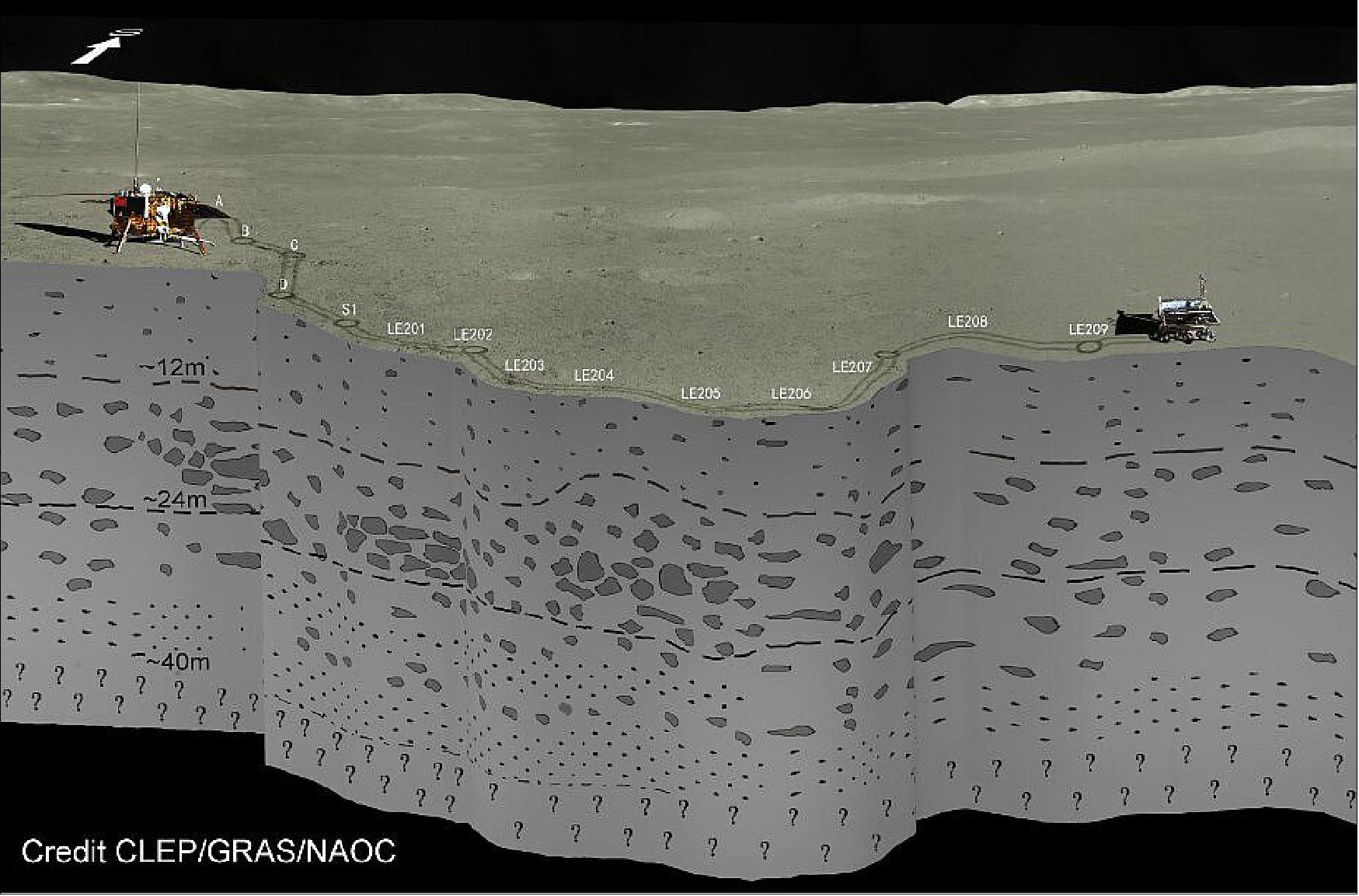
• February 19, 2020: The lander and rover of the Chang'e-4 probe have resumed work for the 15th lunar day on the far side of the moon after "sleeping" during the extremely cold night. 40)
- The lander woke up at 6:57 a.m. Tuesday (Beijing time), and the rover awoke at 5:55 p.m. Monday. Both are in normal working order, according to the Lunar Exploration and Space Program Center of CNSA (China National Space Administration).
• February 5, 2020: China's lunar rover Yutu-2 (Jade Rabbit-2) has driven 367.25 meters on the far side of the moon to conduct scientific exploration. Both the lander and the rover of the Chang'e-4 probe ended their work for the 14th lunar day on Saturday (Beijing Time), and switched to dormant mode for the lunar night, according to the Lunar Exploration and Space Program Center of the China National Space Administration (CNSA). 41)
- During the 14th lunar day, Yutu-2 continued to move along the planned route. The scientific instruments on the lander and rover worked as planned.
- The neutron radiation detector and low-frequency radio spectrometer on the lander worked normally and acquired first-hand scientific data. On the rover, the near-infrared spectrometer, panoramic camera, neutral atom detector and lunar radar carried out scientific exploration as planned.
- The rover Yutu-2 has worked much longer than its three-month design life, becoming the longest-working lunar rover on the moon.
- A lunar day equals 14 days on Earth, and a lunar night is the same length. The Chang'e-4 probe switched to dormant mode during the lunar night due to the lack of solar power.
- China plans to launch the Chang'e-5 probe in 2020 to bring lunar samples back to Earth.
- The Chang'e-5 probe includes a lander, an orbiter, an ascender and a returner. The key tasks of the mission will be lunar sample collection, takeoff from the moon, rendezvous and docking in lunar orbit and high-speed reentry into Earth's atmosphere.
• January 6, 2020: Chinese officials marked the one-year anniversary of the Chang’e-4 mission’s historic first soft landing on the far side of the moon Friday with the public release of data collected by scientific instruments and cameras on the lunar lander and rover. 42)
- The Chang’e-4 lander and Yutu-2 rover landed together on the lunar surface Jan. 3, 2019, marking the first time a spacecraft has ever safely touched down on the far side of the moon.
- Around 12 hours after touchdown, the Yutu-2 rover drove down a ramp to disembark from the Chang’e-4 mission’s stationary landing platform to begin exploring the barren lunar landscape.
- Scientific instruments and cameras aboard the Chang’e- 4 lander and Yutu-2 rover have downlinked measurements and numerous images in the past year. The Chang’e-4 mission relays data through a dedicated Chinese communications satellite positioned beyond the far side of the moon, with a line of sight to both Chang’e-4 and Earth-based receiving stations.
- On Friday, the one-year anniversary of the mission’s successful landing, China National Space Administration and the Chinese Academy of Sciences published scientific data collected by five instruments on the Chang’e-4 lander and Yutu-2 rover.
- The data catalog is available for download on a public website, and is open for analysis by the global science community, Chinese officials said.
- Since landing last January, the Yutu 2 rover has driven 1,173 feet (nearly 358 meters) to survey the Chang’e-4 landing site, collecting data on rock formations, taking pictures and studying the structure of the lunar crust using a ground-penetrating radar.
- The mission continues operating after exceeding its planned three-month design lifetime.
- The rover is powered down and put into sleep mode during each two-week-long lunar night, when the solar-powered craft can no longer generate enough electricity to power its instruments and radio transmitter.
- Chang’e-4 landed in Von Kármán crater, a bowl-shaped depression measuring around 110 miles (180 km) in diameter located in the southern hemisphere of the far side of the moon.
• December 5, 2019: Both the lander and the rover of the Chang'e-4 probe have ended their work for the 12th lunar day, and switched to dormant mode for the lunar night, the Lunar Exploration and Space Program Center of CNSA (China National Space Administration) said Wednesday. 43)
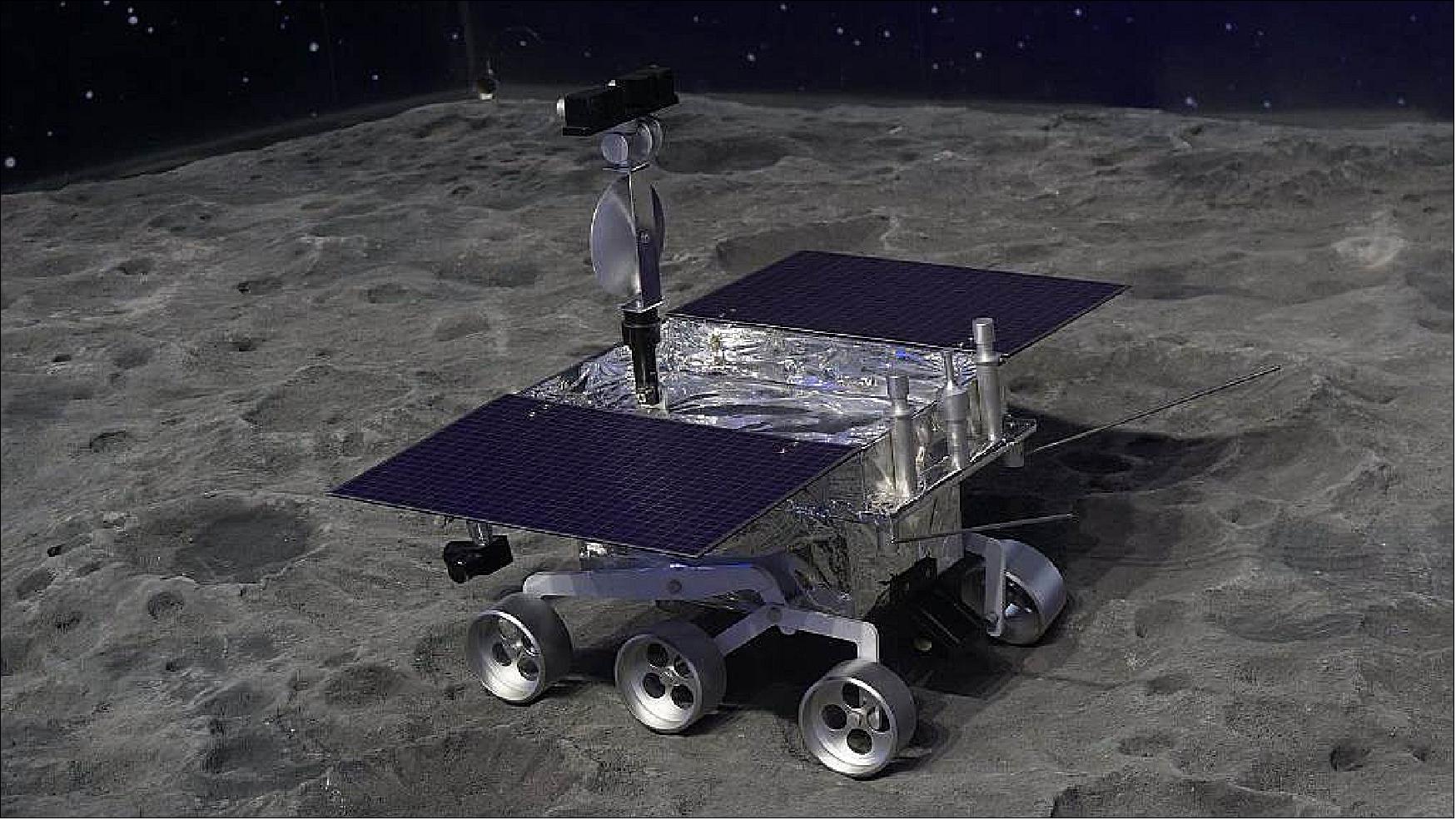
- The rover Yutu-2 has driven 345 meters on the far side of the Moon to conduct scientific exploration of the virgin territory.
- Due to the complicated geological environment and the rugged and heavily cratered terrain on the far side of the Moon, Chinese space engineers carefully planned the driving routes of the rover to ensure its safety.
- Driving slowly but steadily, the Yutu-2 is expected to continue traveling on the Moon and make more scientific discoveries, said the CNSA.
- China's Chang'e-4 probe, launched on December 8, 2018, made the first-ever soft landing on the Von Karman Crater in the South Pole-Aitken Basin on the far side of the Moon on January 3, 2019.
• November 25, 2019: The lander and rover of the Chang'e-4 probe have resumed work for the 12th lunar day on the far side of the moon after "sleeping" during the extremely cold night. 44)
- The lander woke up at 5:03 p.m. Thursday (Beijing Time), and the rover, Yutu-2 (Jade Rabbit-2), awoke at 0:51 a.m. the same day. Both are in normal working order, according to the Lunar Exploration and Space Program Center of the China National Space Administration.
- The rover has traveled about 319 meters on the moon to conduct scientific exploration of the virgin territory.
- The Chang'e-4 probe, launched on 8 December 2018, made the first-ever soft landing on the Von Karman Crater in the South Pole-Aitken Basin on the far side of the moon on 3 January 2019.
• September24, 2019: In January of this year, China's Chang'e-4 — the fourth version of a lunar spacecraft named for the Chinese goddess of the Moon—landed on the far side of the Moon. Due to the location of the landing, Chang'e-4 had to navigate autonomously, without the guidance of scientists on Earth. 45)
- Now, a research team, headed by Chunlai Li, corresponding author of this results and a professor of the National Astronomical Observatories of Chinese Academy of Sciences (NAOC), has published a full reconstruction of the Chang'e-4's landing. The results appeared on September 24 in Nature Communications. 46)
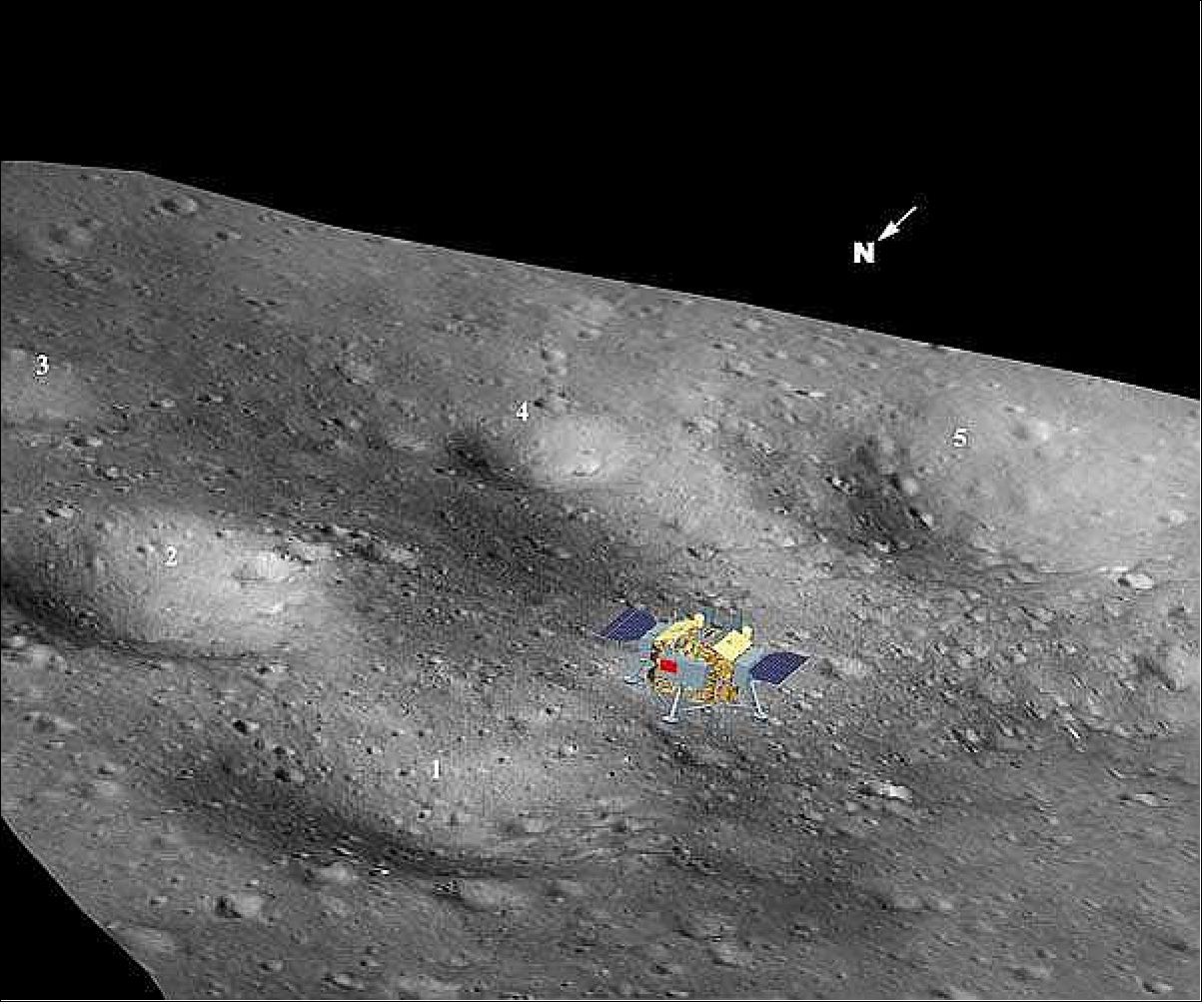
- "This mission had the major challenge of landing on the lunar farside without traditional radio signal techniques due to the missing line-of-sight," said Jianjun Liu, paper author and professor at the Key Laboratory of Lunar and Deep Space Exploration of NAOC.
- "The landing was successful, and we have now reconstructed the landing trajectory and positioning techniques to better understand the process."
- Chang'e-4, which has spent 2019 collecting information about the geology of the Moon's mantle, launched from Earth on December 8, 2018. Once it left Earth's orbit, it circled the Moon before orchestrating a powered descent to the lunar surface, where it navigated itself to the Von Karman crater, which sits in the South-Pole-Aitken (SPA) basin.
- The SPA basin stretches about 2,500 km, or about half the width of China. It's the largest known crater in the solar system.
- The researchers planned for Chang'e-4 to land in the SPA basin because they're specifically interested in studying the geological composition of the Moon. This is easier to do in areas where impacts may have penetrated past the lunar crust.
- The problem was that the SPA basin contains several craters and is surrounded by even more. Previous versions of Chang'e had scouted out the location to a certain extent, so the researchers knew their ultimate landing site goal. However, it was up to Chang'e-4 to navigate around the steeper craters to land in the correct location.
- After Chang'e-4 landed, images from the craft's landing camera and navigation camera were transmitted to Earth via the Queqiao satellite. The satellite was launched in 2018 specifically to relay information from Chang'e-4 to Earth.
- Li and his team used the images and terrain data from Chang'e-2 to identify the specific location of Chang'e-4, including the elevation down to the meter (-5,935 meters). They also fully reconstructed the path the lander took during its powered descent to the surface, during which it clearly navigated away from steeper craters to areas with flatter terrain.
- "It's of great significance to accurately reconstruct the landing trajectory and determine the location of the landing site after a safe landing," Liu said. "We can use this information as landmarks and to service the study of lunar farside control points, high-precision lunar mapping, and future lunar missions."
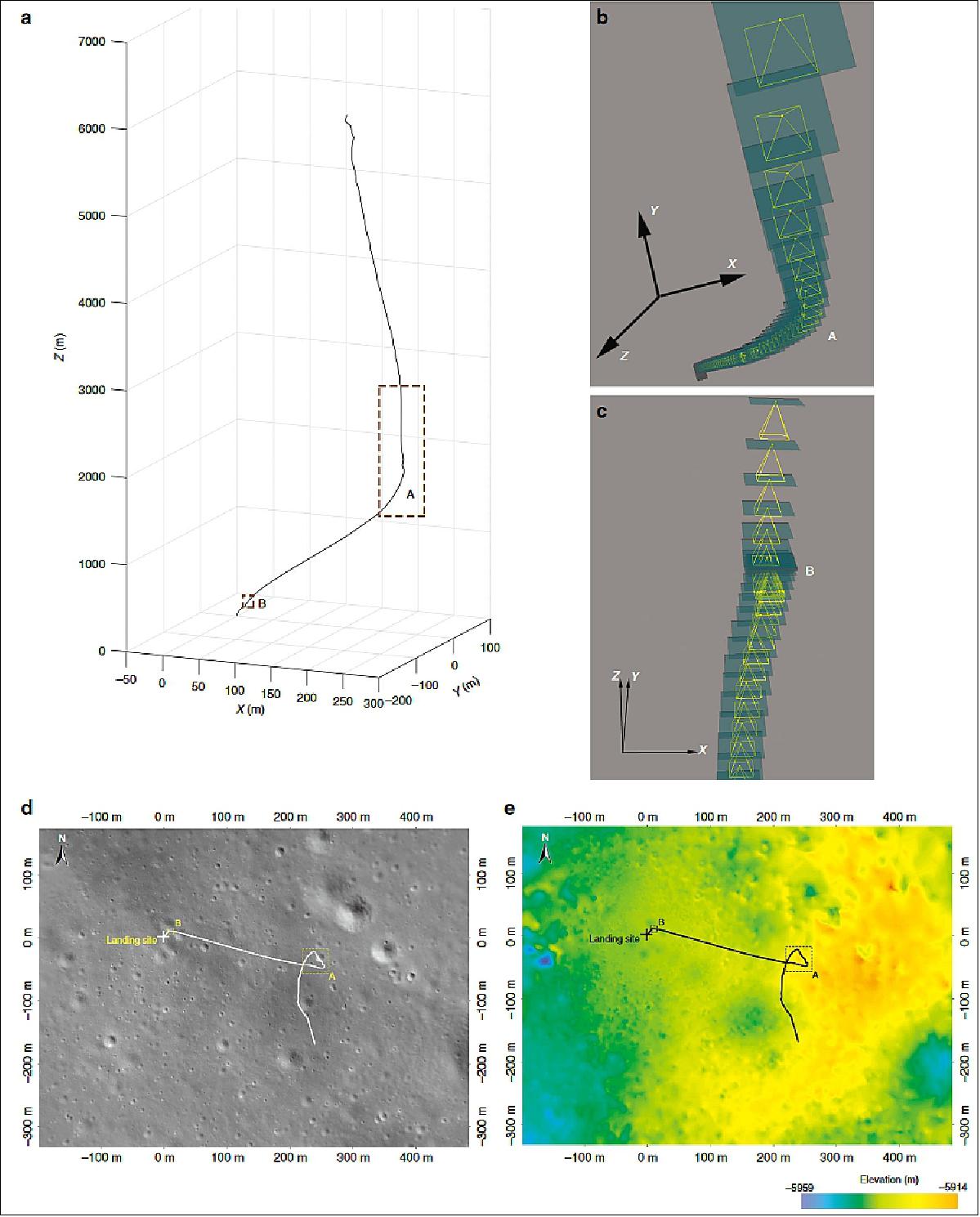
• September 20, 2019: Yutu-2, the lunar rover for China's Chang'e-4 mission, grabbed attention last month after its drive team spotted some unusual "gel-like" material while roving close to a small crater. 47)
- The Chinese-language science outreach publication Our Space, which announced the findings on 17 August, used the term "jiao zhuang wu", which can be translated as "gel-like," Space.com reported. This notion sparked wide interest and speculation among lunar scientists.
- Along with new images of the stuff on the moon, the post released over the weekend by Chinese-language science outreach publication Our Space via its WeChat social media account details how the Yutu-2 team carefully approached the crater in order to analyze the specimen, despite risks.
- One of the images shows two of the rover's six wheels and the contents of an approximately 7-foot-wide (2 meters) crater. The green, rectangular area and red circle within are suspected to be related to the field of view of the Visible and Near-Infrared Spectrometer (VNIS) instrument, rather than the subject matter itself, according to some lunar scientists.
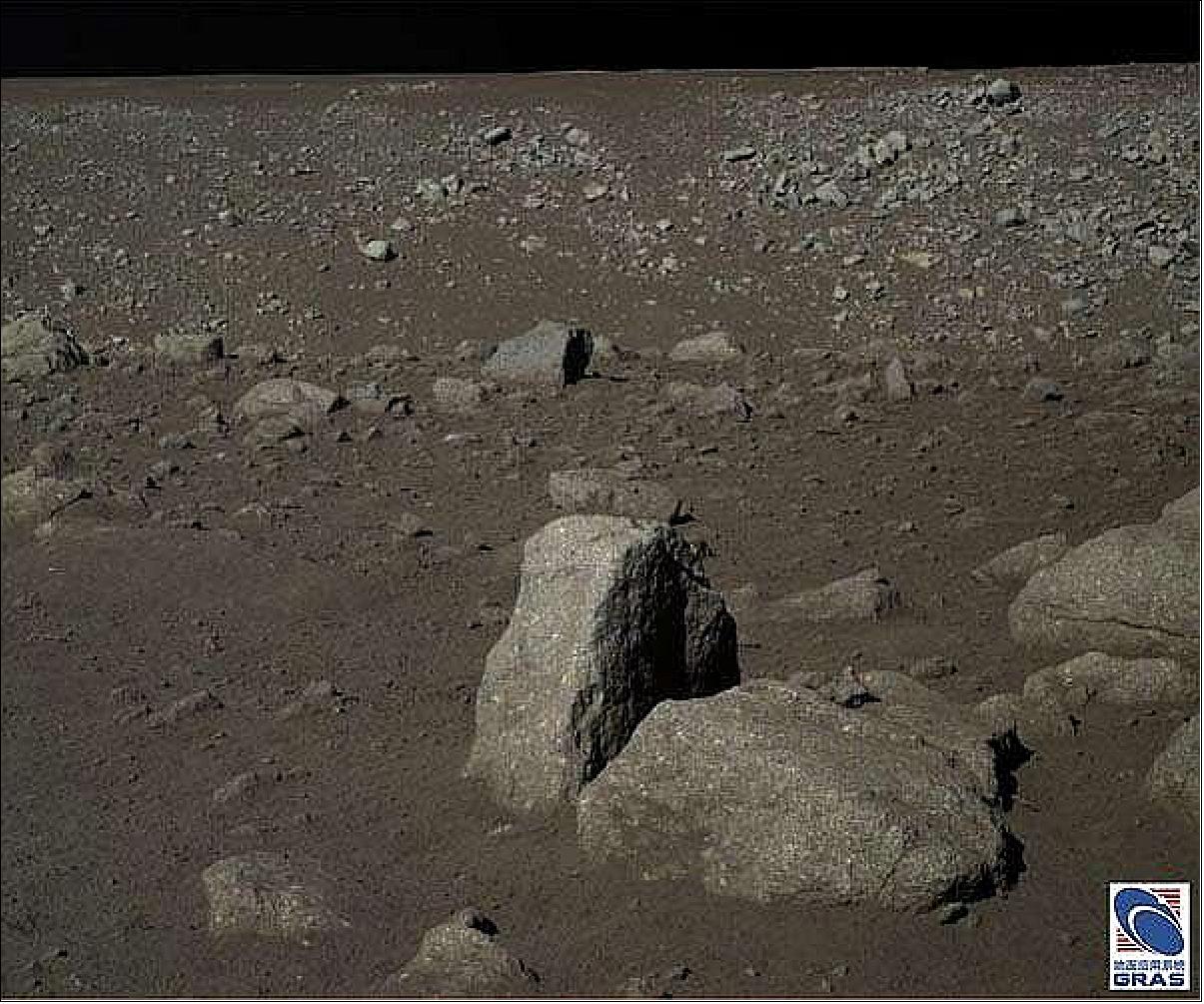
- After obtaining the first set of data that VIRS, one of Yutu-2's four science payloads, collected at the crater in July, the Yutu-2 team deemed it to be unsatisfactory due to shadows, so the team members attempted a second approach and measurement during the following lunar day in August. According to Our Space, satisfactory detection was made - but the results were not released.
- Clive Neal, a lunar scientist at the University of Notre Dame, told Space.com that while the image is not great, it may still give clues to the nature of the material. According to Neal, the material highlighted in the center of the crater resembles a sample of impact glass found during the Apollo 17 mission in 1972. Sample 70019 was collected by astronaut Harrison Schmitt, a trained geologist, from a fresh crater 3 meter in diameter, similar to that approached by Yutu-2.
- Neal describes 70019 as being made of dark, coherent microbrecci, which are made of broken fragments of minerals cemented together - and black, shiny glass. "I think we have an example here of what Yutu-2 saw," Neal said.
- Such materials could exist after high-speed impacts on the lunar surface, which tend to melt and redistribute rock across the craters they make and can create glassy, igneous rocks and crystalline structures.
- Dan Moriarty, NASA Postdoctoral Program Fellow at the Goddard Space Flight Center in Greenbelt, Maryland, also said that it is hard to make a definitive assessment of the substance's chemical composition, outlining that the material appears somewhat brighter than the surrounding materials, though the actual brightness is hard to confirm from the photographs.
- "Chang'e-4 landed in a mare basalt-filled crater, which is typically dark," Moriarty said. "Highlands crustal materials are typically brighter, so that would be a potential candidate. It will be very interesting to see what the spectrometer sees, and if any higher-resolution images become available," Moriarty notes.
- Chang'e-3's Yutu rover carried an alpha particle X-ray spectrometer for analyzing chemical composition, mounted on a robotic arm, which would be very useful for identifying such specimens. Yutu-2 instead carries the new Advanced Small Analyzer for Neutrals (ASAN), a payload from Sweden for studying how solar winds interact with the lunar surface.
- The Chang'e-4 lander and Yutu-2 completed the ninth lunar day of their mission on September 5, powering down around 24 hours ahead of local sunset. Lunar day 10 will begin around September 22 for Yutu-2 and September 23 for the lander.
• August 27, 2019: The lander and rover of the Chang'e-4 probe have resumed work for the ninth lunar day on the far side of the moon after "sleeping" during the extremely cold night. 48)
- The lander woke up at 8:10 a.m. Sunday (25 August), and the rover, Yutu-2 (Jade Rabbit-2), awoke at 8:42 a.m. Saturday, according to the Lunar Exploration and Space Program Center of the China National Space Administration.
- For the ninth lunar day, the lander's neutron radiation detector and low-frequency radio detector, as well as the rover's infrared imaging spectrometer and other instruments will be restarted to conduct scientific tasks including moon surface observation and composition analysis.
• August 12, 2019: China's lunar rover Yutu-2 has driven 271 meters on the far side of the moon to conduct scientific exploration on the virgin territory. 49)
- Both the lander and the rover of the Chang'e-4 probe switched to its dormant mode for the lunar night on Wednesday (7 August, Beijing time), according to the Lunar Exploration and Space Program Center of the China National Space Administration.
- During the eighth lunar day of the probe on the moon, the scientific instruments on the lander and rover worked well, and a new batch of scientific detection data were sent to the core research team for analysis.
- The far side of the moon has unique features, and scientists expect Chang'e-4 could bring breakthrough findings.
- The scientific tasks of the Chang'e-4 mission include low-frequency radio astronomical observation, surveying the terrain and landforms, detecting the mineral composition and shallow lunar surface structure and measuring neutron radiation and neutral atoms.
- The Chang'e-4 mission embodies China's hope to combine wisdom in space exploration with four payloads developed by the Netherlands, Germany, Sweden and Saudi Arabia.
• July 17, 2019: At a time when ESA is looking forward to future lunar exploration, it turns out there is already some small but crucial ESA-developed hardware in operation on the far side of the Moon. China’s Chang’e-4 lander is running on a LEON2-FT microprocessor core, especially designed for space missions by ESA and sold commercially by the Microchip company – marketed as the AT697. 50)
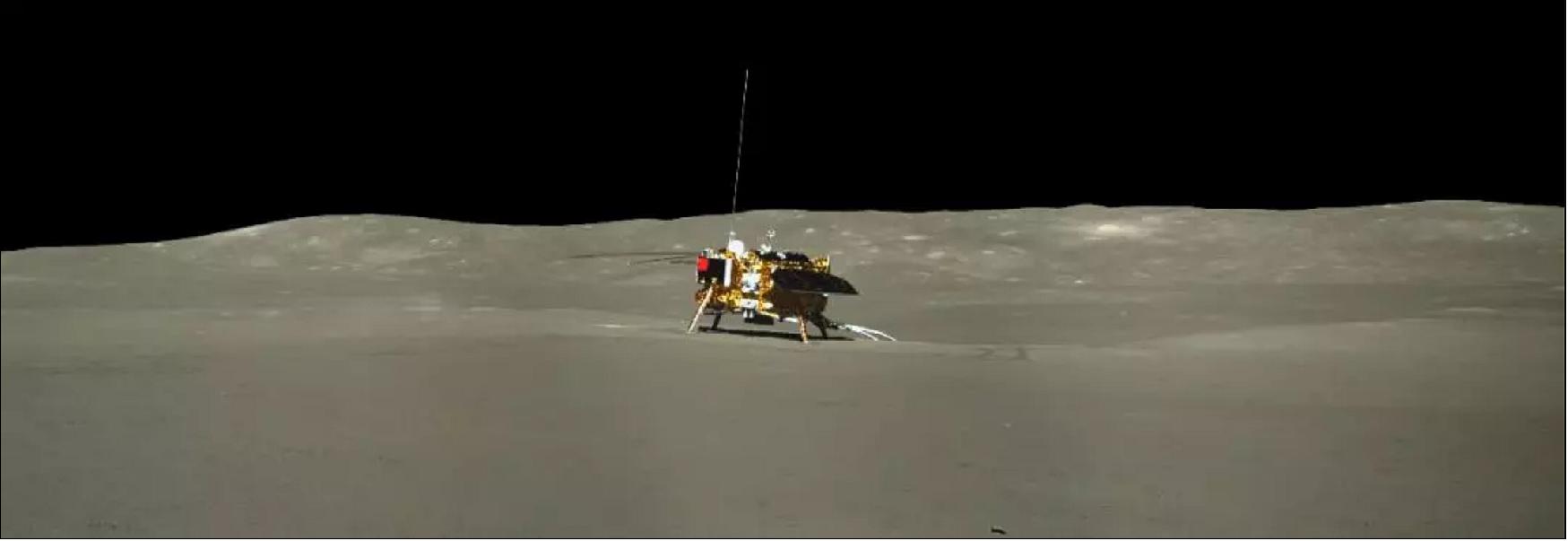
- The ordinary computer chips you use every day in your phone or laptop would be rapidly degraded by the radiation and environmental extremes of space. Specialized chips are therefore essential for spacecraft.
- Chang’e-4 touched down inside the Von Kármán crater on the Moon’s far side near the south pole on 3 January 2019. The lander and the rover it delivered are currently hibernating during the lunar night, having survived seven month-long lunar days so far.
- “Most ESA missions launched after about 2010 include at least one LEON chip, and hundreds of these radiation-hardened off-the-shelf chips have also been sold to space missions both in Europe and around the globe,” explains ESA microelectronics engineer Agustin Fernandez-Leon.
- “This number increases to the thousands if we additionally count customizable fully programmable gate arrays using LEON cores,” adds ESA microelectronics engineer Roland Weigand. “The overall scale of usage is such that it is impractical to keep track of all the missions making use of our microprocessor technology, but it is always nice to find out.”
- Israel’s ill-fated Beresheet lander – which made it most of the way to the lunar nearside before crashing –similarly utilized a GR712RC microprocessor, powered by two LEON3 cores. In this instance their design was not developed by ESA itself but privately funded by Sweden’s Cobham Gaisler company, advancing the existing LEON architecture.
- ESA’s Microelectronics section is currently working on the Next Generation Microprocessor, a quadcore design – common in modern games consoles, laptops, and mobile phones – that combines four embedded LEON4 processor cores, commercialized as the GR740.
• June 28, 2019: The lander and the rover of the Chang'e-4 probe have resumed work for the seventh lunar day on the far side of the moon after "sleeping" during the extreme cold night. 51)
- The lander woke up at 9:45 a.m. Thursday, and the rover, Yutu-2 (Jade Rabbit-2), awoke at 1:26 p.m. Wednesday. Both are in normal working condition, according to the Lunar Exploration and Space Program Center of the China National Space Administration (CNSA).
- The rover has traveled more than 212 meters on the moon to conduct scientific exploration on the virgin territory.
- The scientific tasks of the Chang'e-4 mission include low-frequency radio astronomical observation, surveying the terrain and landforms, detecting the mineral composition and shallow lunar surface structure and measuring neutron radiation and neutral atoms.
• May 15, 2019: A lunar lander named for the Chinese goddess of the moon may have lessened the mystery of the far side of the moon. The fourth Chang'E probe (CE-4) was the first mission to land on the far side of the moon, and it has collected new evidence from the largest crater in the solar system, clarifying how the moon may have evolved. The results were published on 15 May 2019, in Nature. 52) 53)
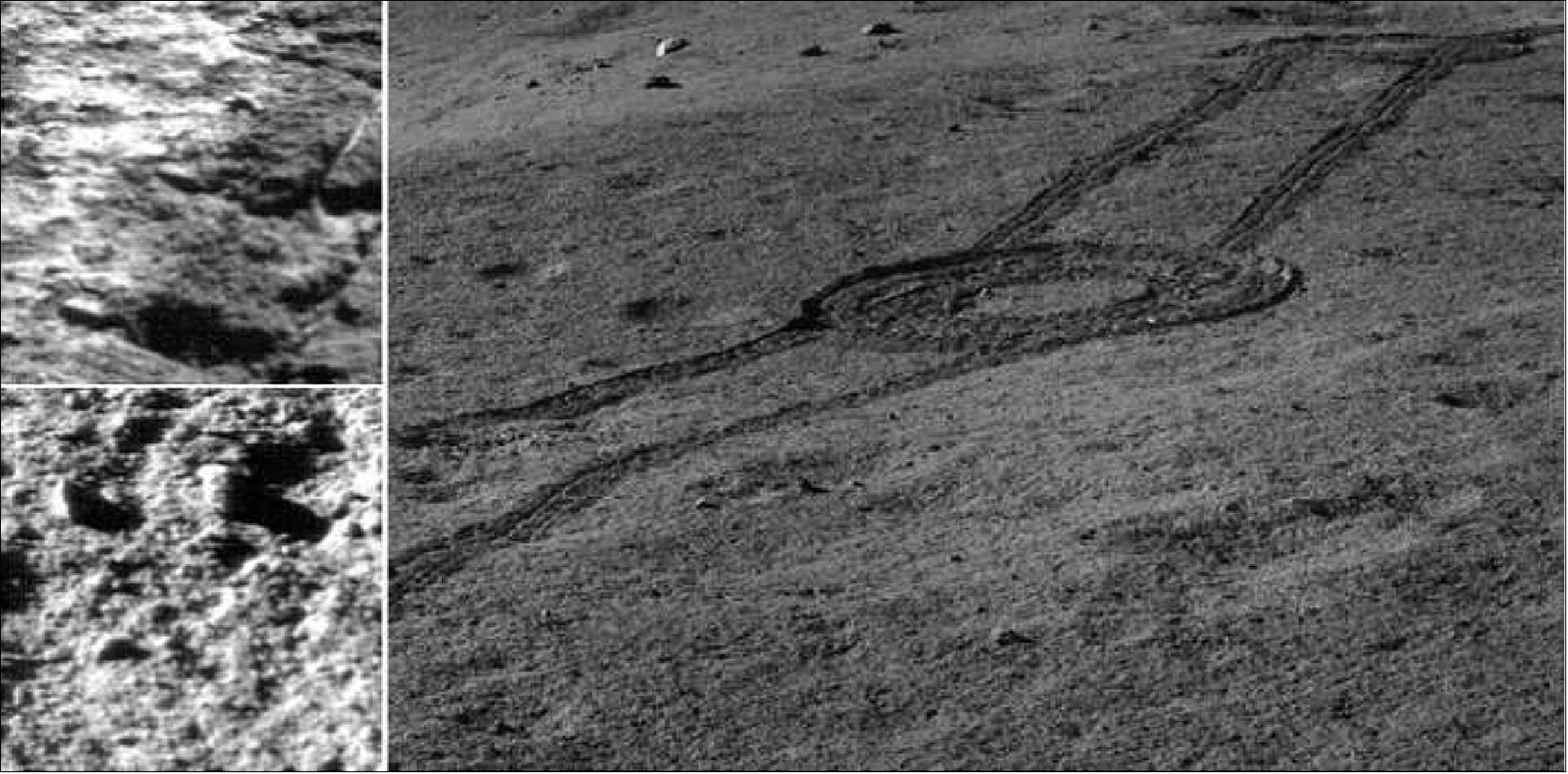
- A theory emerged in the 1970s that in the moon's infancy, an ocean made of magma covered its surface. As the molten ocean began to calm and cool, lighter minerals floated to the top, while heavier components sank. The top crusted over in a sheet of mare basalt, encasing a mantle of dense minerals, such as olivine and pyroxene.
- As asteroids and space junk crashed into the surface of the moon, they cracked through the crust and kicked up pieces of the lunar mantel.
- "Understanding the composition of the lunar mantel is critical for testing whether a magma ocean ever existed, as postulated," said corresponding author Chunlai Li, a professor of the National Astronomical Observatories of Chinese Academy of Sciences (NAOC). "It also helps advance our understanding of the thermal and magmatic evolution of the moon."
- The evolution of the moon may provide a window into the evolution of Earth and other terrestrial planets, according to Li, because its surface is relatively untouched compared to, say, the early planetary surface of Earth.
- Li and his team landed CE-4 in the moon's South Pole-Aitken (SPA) basin, which stretches about 2,500 kilometers—about half the width of China. CE-4 collected spectral data samples from the flat stretches of the basin, as well as from other smaller but deeper impact craters within the basin.
- The researchers expected to find a wealth of excavated mantle material on the flat floor of the SPA basin, since the originating impact would have penetrated well into and past the lunar crust. Instead, they found mere traces of olivine, the primary component of the Earth's upper mantle.
- "The absence of abundant olivine in the SPA interior remains a conundrum," Li said. "Could the predictions of an olivine-rich lunar mantle be incorrect?"
- Not quite. As it turns out, more olivine appeared in the samples from deeper impacts. One theory, according to Li, is that the mantle consists of equal parts olivine and pyroxene, rather than being dominated by one or the other.
- CE-4 will need to explore more to better understand the geology of its landing site, as well as collect much more spectral data to validate its initial findings and to fully understand the composition of the lunar mantle.
• April 30, 2019: The lander and the rover of the Chang'e-4 probe have resumed work for the fifth lunar day on the far side of the moon after "sleeping" during the extreme cold night. 54)
- The lander woke up at 7:40 a.m. Monday (29 April), and the rover, Yutu-2 (Jade Rabbit-2), awoke at 1:45 p.m. Sunday. Both are in normal working condition, according to the Lunar Exploration and Space Program Center of the China National Space Administration.
- The rover has traveled an accumulated 178.9 meters on the moon and worked about one month longer than its designed life.
• April 15, 2019: The lander and the rover of the Chang'e-4 probe switched to dormant mode for the lunar night on Friday (12 April), with the rover traveling an accumulated 178.9 meters on the far side of the moon. 55)
- The rover Yutu-2, or Jade Rabbit-2, is expected to awaken again on 28 April, and the lander to awaken the following day, according to the Lunar Exploration and Space Program Center of the China National Space Administration.
• March 7, 2019: China's lunar rover has conducted scientific detection on some stones on the far side of the moon, which might help scientists find out whether they are from outer space or native to the moon. 56)
- The rover Yutu-2, or Jade Rabbit-2, was sent to the Von Karman Crater in the South Pole-Aitken (SPA) Basin on the far side of the moon on Jan. 3 in the Chang'e-4 mission.
- Currently, the rover has traveled about 127 meters on the moon, and is taking a "noon break" as the temperature on the moon rises extremely high. It's scheduled to resume work on March 10 and switch to its dormant mode on March 13, according to the Lunar Exploration and Space Program Center of the China National Space Administration.
- Scientists said the rover has conducted scientific detection on its tracks and nearby stones. The largest stone detected has a diameter of about 20 cm, and the rover came as close as 1.2 meters to it.
- Experts from NSSC (National Space Science Center) under the Chinese Academy of Sciences (CAS) said they want to figure out the origin of the stones, whether they are aboriginal on the moon, or meteorites from outer space. If they are aboriginal, what is the physical process of their formation?
- As a result of the tidal locking effect, the moon's revolution cycle is the same as its rotation cycle, and it always faces the Earth with the same side.
- The far side of the moon was regarded as a virgin territory with unique features, and scientists expect important discoveries.
- Jinsong Ping, a researcher with the National Astronomical Observatories under CAS, said that the rocks on the lunar surface might be sputtered body as a result of the meteorite impact.
- Scientists have found evidence indicating a heavy asteroid bombardment event in the solar system around 3.9 billion years ago. And the SPA Basin might be an impact from that period. The exploration might offer clues as to why the bombardment occurred, said Yongliao Zou , director of the lunar and deep space exploration division of CAS.
- The other possibility is that the stones are aboriginal, and contain geological information different from the lunar dust, said Ping.
- "The rocks on the far side are more ancient. The analysis of their substance composition might help us better understand the evolution of the moon," said Zou.
- In addition, the study on the tracks of the rover may reveal the information about the evolutionary history of the lunar surface over billions of years, Ping said.
- The 135 kg lunar rover Jade Rabbit-2 is the first ever rover to drive on the moon's far side, as well as the lightest rover ever sent to the moon.
- From the images sent back from Chang'e-4, scientists found the area surrounding the probe is dotted with craters of different sizes, and it's very difficult for the rover to drive in the region.
- The rover is capable of avoiding some obstacles. If there are obstacles in front of it, it can stop and plan a new route on its own. It can also climb some slopes and cross rocky terrain, according to its designers from the China Academy of Space Technology.
- The rover has sent back pictures about the stones on the far side of the moon.
- Experts from NSSC said it's not easy for the rover to take the pictures since it cannot move as freely as a human. It takes a long time to move and adjust the position and angle of the rover.
- Scientists hope Jade Rabbit-2 will travel farther to send more images of the unknown terrain, "listen" to the stories recorded in the ancient lunar rocks, and find more traces of the early history of the moon and the solar system.
- Scientists said it's just the beginning of the scientific journey of the Jade Rabbit-2, and they expect more interesting discoveries.
• March 1, 2019: The rover and the lander of the Chang'e-4 probe have resumed work after "sleeping" during their second lunar night on the far side of the moon. 57)
- The lander woke up at 7:52 a.m. last Friday (1 March), and the rover, Yutu-2 (Jade Rabbit-2), awoke at about 10:51 a.m. last Thursday (28 February). Both of them are in normal condition, according to the Lunar Exploration and Space Program Center of the China National Space Administration.
- A lunar day equals 14 days on Earth, and a lunar night is the same length. The Chang'e-4 probe switched to a dormant mode during the lunar night due to the lack of solar power.
- As a result of the tidal locking effect, the moon's revolution cycle is the same as its rotation cycle, and it always faces Earth with the same side.
- The far side of the moon has unique features, and scientists expect Chang'e-4 could bring breakthrough findings.
- The scientific tasks of the Chang'e-4 mission include low-frequency radio astronomical observation, surveying the terrain and landforms, detecting the mineral composition and shallow lunar surface structure, and measuring neutron radiation and neutral atoms.
• February 18, 2019: Five sites on the far side of the Moon now have official names, including Chang'e-4's landing site. The names have significance in Chinese culture, reflecting the background of the probe's team. 58) 59)
- The IAU (International Astronomical Union) Working Group for Planetary System Nomenclature has approved the name Statio Tianhe for the landing site where the Chinese spacecraft Chang'e-4 touched down on 3 January this year, in the first-ever landing on the far side of the Moon. The name Tianhe originates from the ancient Chinese name for the Milky Way, which was the sky river that separated Niulang and Zhinyu in the folk tale "The Cowherd and the Weaver Girl".
- Four other names for features near the landing site have also been approved. In keeping with the theme of the above-mentioned folk tale, three small craters that form a triangle around the landing site have been named Zhinyu, Hegu, and Tianjin, which correspond to characters in the tale. They are also names of ancient Chinese constellations from the time of the Han dynasty. The fifth approved name is Mons Tai, assigned to the central peak of the crater Von Kármán, in which the landing occurred. Mons Tai is named for Mount Tai, a mountain in Shandong, China, and is about 46 km to the northwest of the Chang’e-4 landing site.

- They are also names of ancient Chinese constellations from the time of the Han dynasty. The fifth approved name is Mons Tai, assigned to the central peak of the crater Von Karman, in which the landing occurred. Mons Tai is named for Mount Tai, a mountain in Shandong, China, and is about 46 km to the northwest of the Chang'e-4 landing site.
• February 3, 2019: An experiment that saw the first-ever plant sprouting on the moon last month was born in a natural disaster that devastated China's cotton-industry almost three decades ago. 60)
- Fuguang Li was one of the Chinese agricultural scientists whose years of hard work might one day help lead to a base and long-term human residence on the moon.
- Li was on the team that developed the cotton seeds carried to the moon by China's Chang'e-4 probe, leading to the first-ever sprout on the moon.
- The seed is one of the best varieties developed by the Institute of Cotton Research (ICR) of the Chinese Academy of Agricultural Sciences.
- After making the first-ever soft landing on the far side of the moon on 3 January, China's Chang'e-4 mission pioneered the first mini biosphere experiment on the moon.
- A canister on the Chang'e-4 lander contained seeds of cotton, rapeseed, potato and Arabidopsis, as well as fruit fly eggs and some yeast, to form a simple mini biosphere.
- Images from the probe showed that only a cotton sprout was growing.
- Although the sprout couldn't survive the extremely cold lunar night, Li, head of ICR, believed it could help acquire knowledge for building a base and long-term residence on the moon.
- The cotton seeds were selected for the experiment because of their outstanding performance on Earth.
- The seeds belong to a transgenic insect-resistant cotton variety developed in China and named CCRI 41, said Li.
- China suffered its worst ever cotton bollworm infestation in 1992. In one county, the bollworms captured (ate) in one day over a ton.
- The disaster reduced the yield of most of the cotton fields by more than half.
- Within three years, the cotton planting area in China fell from 100 million mu (about 6.67 million hectares) to 60 million mu (4 million hectares).
- The economic losses nationwide exceeded 40 billion yuan (about $5.9 billion).
- Transgenic insect-resistant cottons developed by foreign scientists gained more than 90 percent of the market share in China by the end of last century.
- In 2002, Chinese scientists successfully bred CCRI 41, the first transgenic insect-resistant cotton variety with independent intellectual property rights, breaking the hold of imported cotton varieties.
- The market share of domestic insect-resistant cotton varieties increased from 5 percent in 1999 to 98 percent in 2012.
- The plantation of the insect-resistant cottons not only controlled the spread of bollworm, but also reduced the use of pesticides by 70 to 80 percent in China, said Li.
- Based on CCRI 41, Chinese scientists have bred more than 100 new cotton varieties.
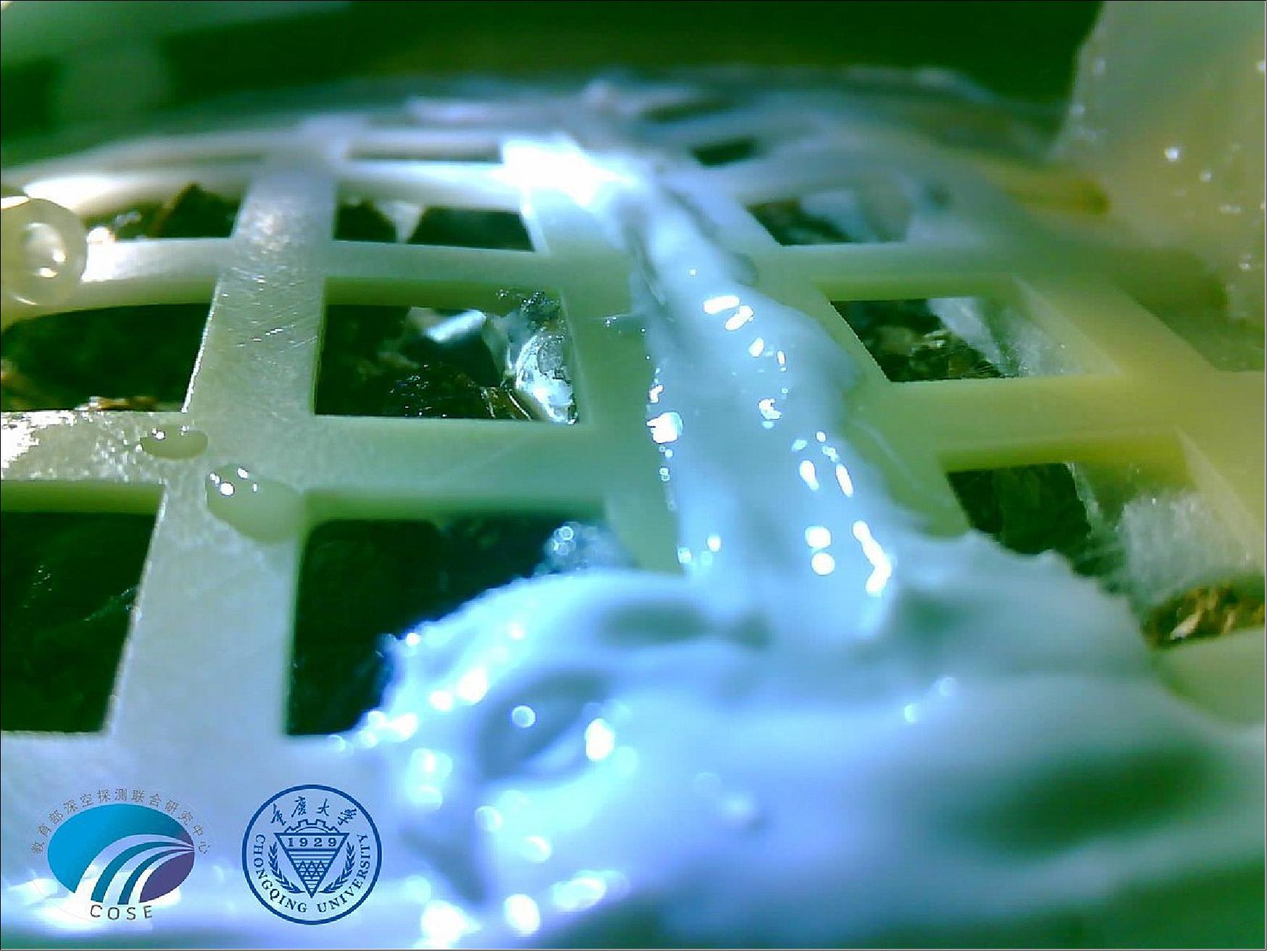
• February 1, 2019: China's Chang'e 4 probe, having made the first-ever soft landing on moon's far side, found that the temperature of the lunar surface dropped to as low as minus 190º Celsius, colder than expected. 61)
- This is the first time Chinese scientists have received first-hand data about the temperatures on the surface of the moon during the lunar night.
- The rover and the lander of the Chang'e-4 probe have been awakened by sunlight after a long "sleep" during their first extremely cold night on the moon, CNSA (China National Space Administration) announced on Thursday (31 January).
- As a result of the tidal locking effect, the moon's revolution cycle is the same as its rotation cycle, and the same side of the moon always faces Earth. A lunar day equals 14 days on Earth, and a lunar night is the same length. The Chang'e-4 probe switched to dormant mode during the lunar night due to a lack of solar power.
- "According to the measurements of Chang'e-4, the temperature of the shallow layer of the lunar soil on the far side of the moon is lower than the data obtained by the U.S. Apollo mission on the near side of the moon," said He Zhang, executive director of the Chang'e-4 probe project from CAST (China Academy of Space Technology). "That's probably due to the difference in lunar soil composition between the two sides of the moon. We still need more careful analysis," Zhang said.
- Temperatures vary enormously between day and night on the moon. Previously, Chinese scientists had no data on exactly how cold it could be.
- At the end of 2013, China launched Chang'e-3, the country's first spacecraft to soft-land on the moon. The scientific instruments on its lander are still operating after more than 60 lunar nights over the past five years.
- "It was a success, but Chang'e-3 was designed according to foreign temperature data," said Zhang. The measurement of the temperature changes between the day and night on the moon will help scientists estimate the properties of the lunar soil, according to Zhang.
- The rover and the lander carried a radioisotope heat source, which helped keep the probe warm during the lunar night.
- The lander was also equipped with an isotope thermoelectric cell and dozens of temperature data collectors to measure the temperatures on the surface of the moon during the lunar night.
- Used for the first time in a Chinese spacecraft, the isotope thermoelectric generation technology to transform heat into power on Chang'e-4 is a prototype for future deep-space exploration, said Zezhou Sun, chief designer of the Chang'e-4 probe from CAST.
- NASA's Curiosity rover also adopts this power technology, freeing it from the sunshine, sand and dust restrictions that have affected its predecessors Opportunity and Spirit, he explained.
- "It is a technology that we must master if we want to go to the moon's polar regions or farther than Jupiter into deep space, where solar power cannot be used as the primary power source," he said.
• January 16, 2019: One of the cotton seeds carried to the moon by China's Chang'e-4 probe is the first ever to sprout on the moon, according to scientists of a mini biosphere experiment Tuesday. 62) 63)
- After making the first-ever soft landing on the far side of the moon, China's Chang'e-4 mission pioneered the first mini biosphere experiment on the moon.
- Professor Gengxin Xie, of Chongqing University and chief designer of the experiment, said a canister installed on the lander of the Chang'e-4 probe contained the seeds of cotton, rapeseed, potato and Arabidopsis, as well as eggs of the fruit fly and some yeast, to form a simple mini biosphere.
- Images sent by the probe showed that a cotton sprout had started to grow, though no other plants were found growing.
- The cylinder canister, made from special aluminum alloy materials, is 198 mm tall, with a diameter of 173 mm and a weight of 2.6 kg. It also holds water, soil, air, two small cameras and a heat control system, Xie said.
- More than 170 pictures have been taken by the cameras and sent back to Earth, according to the team.
- Why were these species chosen? Xie said potatoes could be a major source of food for future space travelers. The growth period of Arabidopsis, a small flowering plant related to cabbage and mustard, is short and easy to observe. Yeast could play a role in regulating carbon dioxide and oxygen in the mini biosphere, and the fruit fly would be the consumer of the photosynthesis process.
- Researchers used biological technology to render the seeds and eggs dormant during the two months when the probe went through the final checks in the launch center and journey of more than 20 days through space.
- After Chang'e-4 landed on the far side of the moon on 3 January, the ground control center instructed the probe to water the plants to start the growing process. A tube directs natural light on the surface of the moon into the canister to allow the plants to grow.
- The Chang'e-4 probe entered a "sleep mode" on Sunday (6 January) as the first lunar night after the probe's landing fell. The temperature could drop as low as about minus 170ºC.
- "Life in the canister would not survive the lunar night," Xie said.
- The experiment has ended. The organisms will gradually decompose in the totally enclosed canister, and will not affect the lunar environment, said CNSA (China National Space Administration).
- Although astronauts have cultivated plants on the International Space Station, and rice and Arabidopsis were grown on China's Tiangong-2 space lab, those experiments were conducted in low-Earth orbit, at an altitude of about 400 km. The environment on the moon, 380,000 km from Earth, is more complex.
- "We had no such experience before. And we could not simulate the lunar environment, such as microgravity and cosmic radiation, on Earth," Xie said.
• January 15, 2019: China announced Friday (11 January) that the Chang'e-4 mission, which realized the first-ever soft-landing on the far side of the moon, was a complete success. 64)
- With the assistance of the relay satellite Queqiao (Magpie Bridge), the rover Yutu-2 (Jade Rabbit-2) and the lander of the Chang'e-4 probe took photos of each other.
- The scientific instruments aboard the probe worked well, and the images taken by the probe and detection data have been sent back to ground control, said the China National Space Administration (CNSA).
- At 4:47 p.m. Beijing Time on Friday, the images of the lander and rover appeared on a large screen at the Beijing Aerospace Control Center, showing the Chinese national flag on both the lander and the rover with landscape dotted with craters in the background.
- A congratulatory message sent by the Communist Party of China (CPC) Central Committee, the State Council and the Central Military Commission hailed the Chang'e-4 mission as a remarkable achievement in China's space program, which marks an important stride toward China being a strong country in space exploration.
• January 15, 2019: China's second lunar rover Yutu-2 (Jade Rabbit-2) will face great challenges brought by complicated terrains in its future exploration, Chinese space experts said on 14 January. 65)
- "From the images sent back from Chang'e-4, we can see the area surrounding the probe is dotted with craters of different sizes, and it's very difficult for the rover to drive in the region," Zezhou Sun, chief designer of the Chang'e-4 probe, said at a press conference of the State Council Information Office.
- "We'll try to find the relatively safe areas and make a reasonable plan for the route of the rover based on the images taken by it," Sun said.
- The rover is capable of avoiding some obstacles. If there are obstacles in front of it, it can stop and plan a new route on its own. It can also climb some slopes and cross some rocks. "We haven't found any insurmountable obstacle in the region," Sun said.
- He said the Chang'e-4 probe has achieved the expected landing precision. The telemetry information and images taken by a camera on the probe showed that the spacecraft effectively avoided obstacles during its descent.
- The probe has started its scientific exploration, focusing on studying the terrains and landforms, lunar environment, and substances composition, said Weiren Wu, chief designer of China's lunar program.
- "This is the first-ever exploration on the surface of the far side of the moon. The scientific research will be innovative and influential both at home and abroad," Wu said.
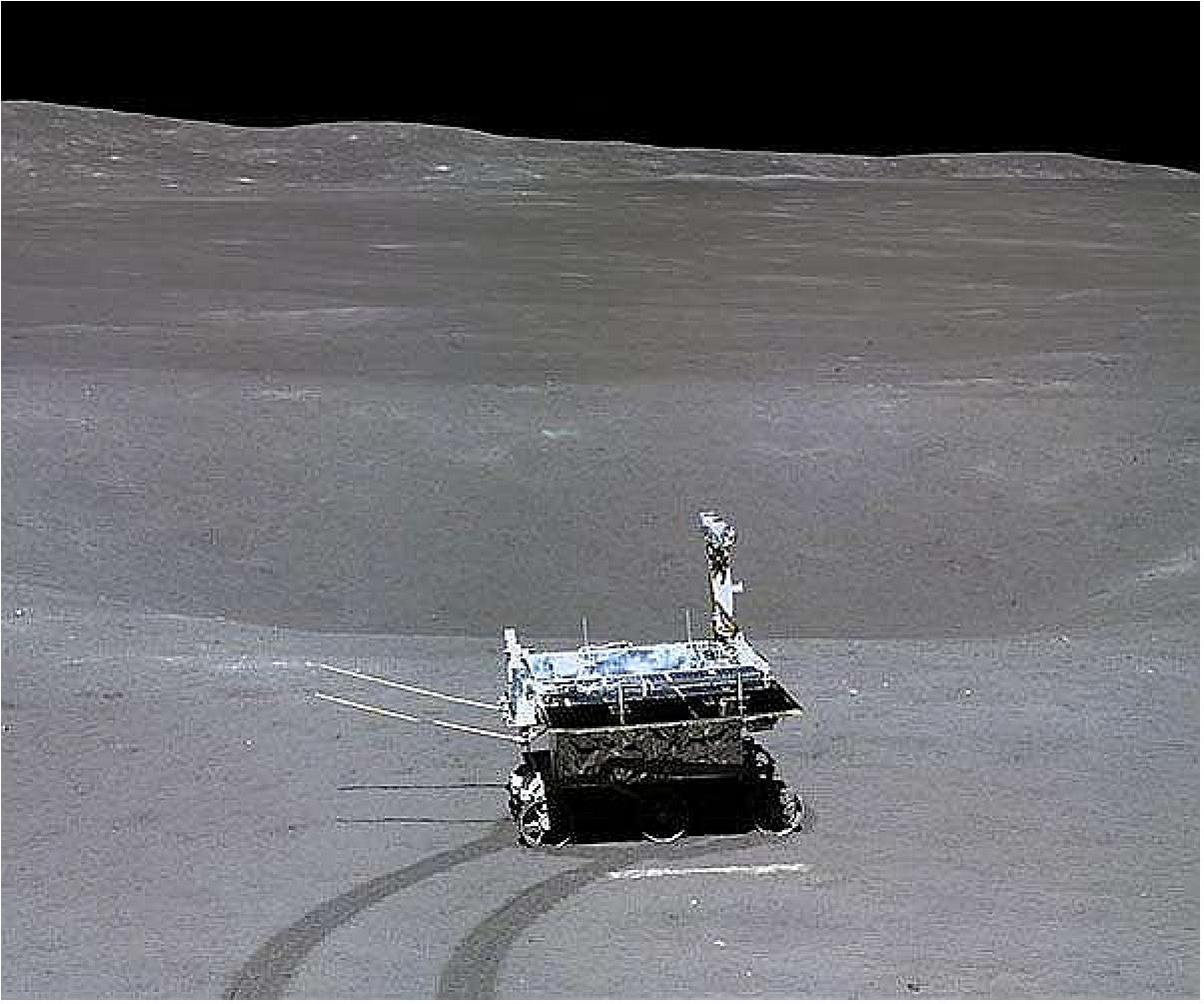
• January 11, 2019: China's Chang'e-4 probe took panoramic photos on the lunar surface after it successfully made the first ever soft-landing on the far side of the moon. CNSA (China National Space Administration) released the 360-degree panoramic photos taken by a camera installed on the top of the lander (Figure 27). The picture was pieced together from 80 photos taken by a camera on the lander. 66) 67)
- The images were sent back via the relay satellite Queqiao, which was operating around the second Lagrangian point of the earth-moon system, about 455,000 km from the earth, where it can see both the earth and the moon's far side.
- Scientists have made a preliminary analysis on the terrains and land form the probe's surroundings according to the panoramic pictures.
- The Chang'e-4 probe touched down on the Von Karman Crater at the South Pole-Aitken Basin in the morning of 3 January 2019, and the lunar rover Yutu-2 drove onto the lunar surface late that night. — Then the rover took a "nap" as the solar radiation raised the temperature on the lunar surface to over 100ºC. It restarted to work on Thursday (10 January).
- According to CNSA, the rover and the relay satellite are in good condition.
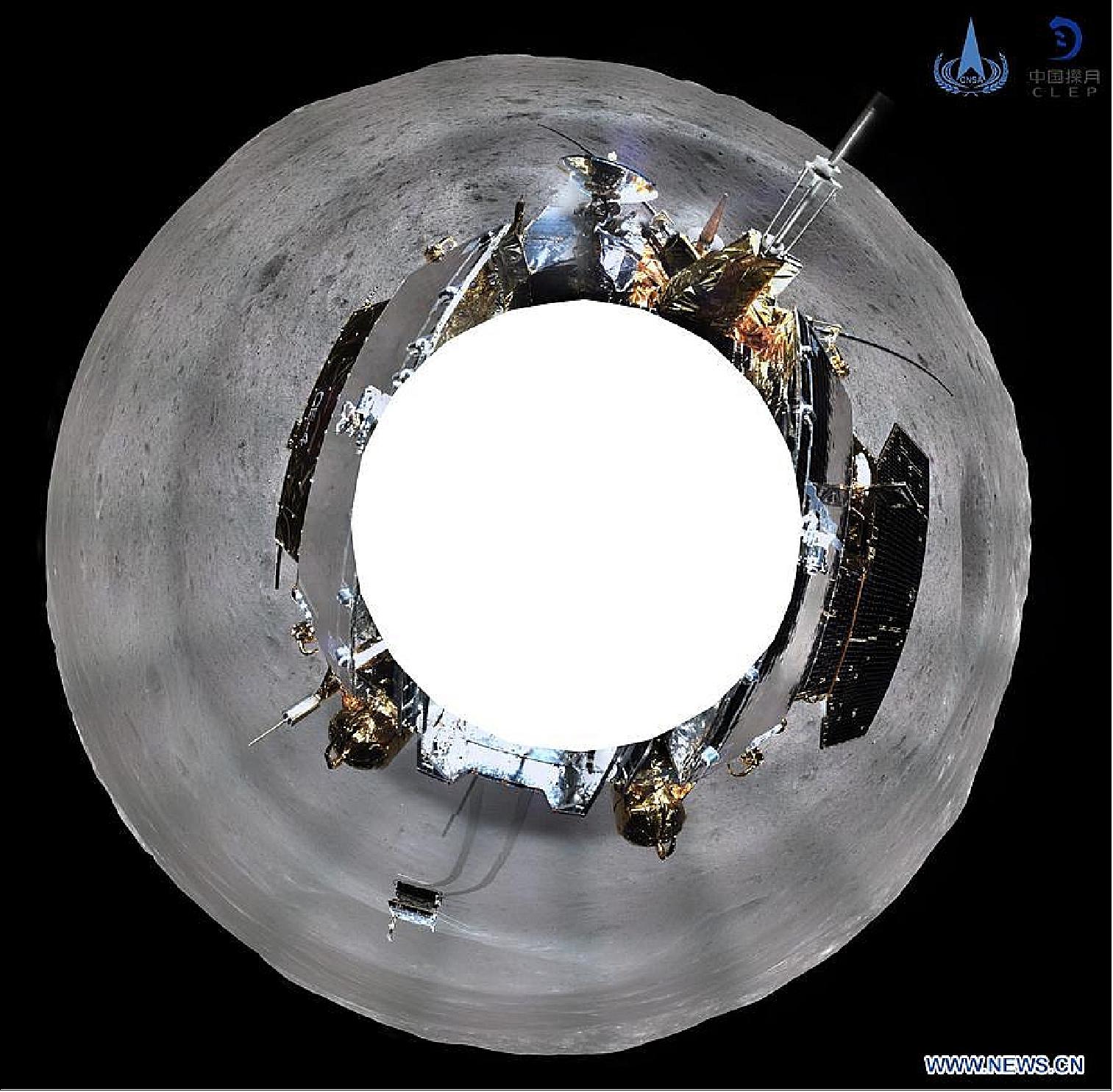
• January 5, 2019: Lunar rover Yutu-2 has been driving on the far side of the moon after separating from the lander and scientific devices on both the lander and rover are currently gathering data, CNSA (China National Space Administration) said late Friday (4 January). 68)
- At 17:00 local time in Beijing, the three 5-meter antennas of the low-frequency radio spectrometer on the lander have fully spread out, said the CNSA in a statement.
- Meanwhile, Germany's LND (Lunar Lander Neutrons and Dosimetry) experiment was turned on for testing. The ground control has been receiving geographic and geomorphic images of the moon's far side.
- The Yutu-2 rover, equipped with a data transmission link to relay via the Queqiao satellite at EML-2 (Earth-Moon Liberation point-2), completed environment perception and route planning. It has been driving on the lunar surface on schedule and arrived at preset location A to carry out observations.
- The LPR (Lunar Penetrating Radar) and PCAM (Panorama Camera) the rover have been operating smoothly and other devices will begin operation according to schedule.
- According to the CNSA, in the following days, Yutu-2 and the lander will face the challenge of extremely high temperatures in the lunar day. Yutu-2 will enter a "napping" mode at an appropriate time and is expected to resume moving next Thursday (10 January).
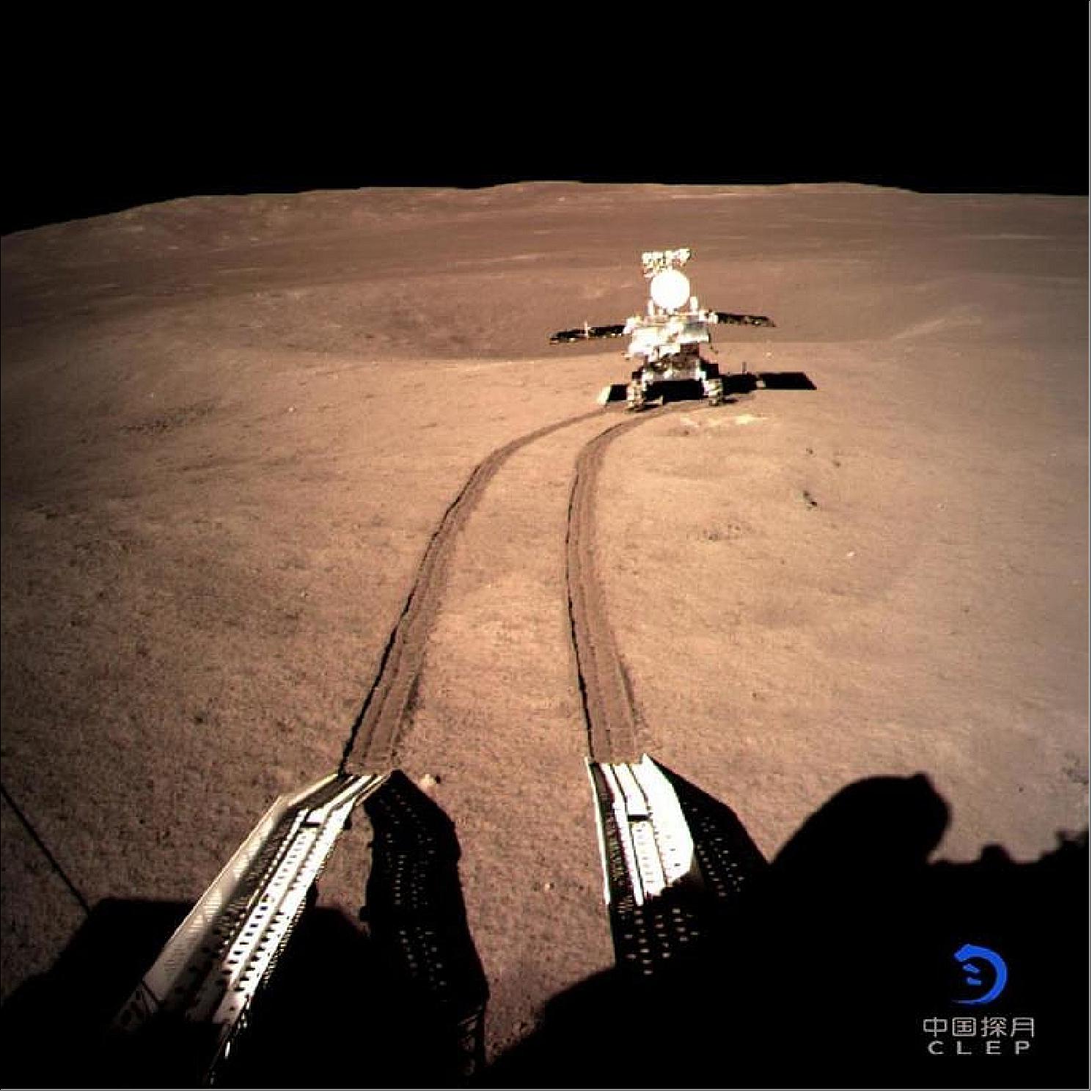
• January 4, 2019: China has chosen the name "Yutu-2", or Jade Rabbit-2, for its new moon rover, the China National Space Administration (CNSA) announced on late 3 January (Thursday). 69)
- CNSA made the announcement after China's Chang'e-4 probe, comprised of a lander and a rover, landed on the far side of the moon earlier in the day. In Chinese folklore, Yutu is the white pet rabbit of Chang'e, the moon goddess who lent her name to the Chinese lunar mission.
• January 4, 2019: China's Chang'e-4 probe has landed on the SPA (South Pole-Aitken) Basin on the far side of the moon, regarded as a virgin territory by scientists expecting important discoveries. 70)
- "The far side of the moon has very unique features, and has never been explored in situ, so Chang'e-4 might bring us breakthrough findings," said Yongliao Zou, director of the lunar and deep space exploration division of CAS (Chinese Academy of Sciences).
- As a result of the tidal locking effect, the moon's revolution cycle is the same as its rotation cycle. It always faces the earth with the same side, and the far side was a mystery before the age of spacecraft.
- About 60 years ago, the Luna 3 probe of the Soviet Union sent back the first image of the moon's far side. And about 50 years ago, three astronauts of the United States Apollo 8 mission became the first people to see the moon's far side with their own eyes.
- More lunar missions showed the moon's two sides were very different: the near side has more and relatively flat lunar mares, while the far side is thickly dotted with impact craters at different sizes.
- "There are great differences in terms of substance composition, terrain and landforms, structure and the age of rocks. For instance, about 60 percent of the near side is covered by mare basalt, but most part of the far side is covered by lunar highland anorthosite. Of the 22 lunar mares, 19 are located on the near side," said Zou.
- Scientists infer that the lunar crust on the far side is much thicker than the near side. But why is still a mystery. Only in-situ exploration might reveal the secrets.
- Exploration of the far side might help shed light on the early history of the moon, the earth and the solar system.
- The moon and the earth shared a similar "childhood." But the traces of the remote past on earth have been erased by geological activity. "The moon might provide us with some insights to the early history of earth," said Yangting Lin, a researcher from the Institute of Geology and Geophysics of CAS.
- The SPA Basin, where the Chang'e-4 probe landed, is the largest and deepest basin in the solar system, with a diameter of 2,500 km and a depth of more than 10 km.
- "With the Chang'e-4 probe, we can detect information hidden deeply inside the moon. I believe there will be surprising scientific findings," Zou said.
- "The rocks on the far side are more ancient. The analysis of their substance composition might help us better understand the evolution of the moon," said Zou.
- Scientists have found evidence indicating a heavy asteroid bombardment event in the solar system around 3.9 billion years ago. And the SPA Basin might be an impact from that period. The exploration might offer clues as to why the bombardment occurred, said Zou.
• January 3, 2019: The Chang'e-4 lunar probe, the latest step in China's endeavor to explore the silver sphere, landed at 10:26 Beijing Time on the Von Karman crater in the South Pole-Aitken basin (177.6º east longitude and 45.5º south latitude)) and then sent back a picture of the landing site shot by one of the monitor cameras on the probe's lander, marking the world's first image taken on the moon's far side. 71) 72) 73)
- The successful soft landing formally inaugurated the world's first expedition to the far side that never faces the Earth and is expected to fulfill scientists' long-held aspiration to closely observe the enormous region.
- The probe conducted rapid position adjustments when it reached to an altitude 8 to 6 km above the moon. The descent then paused for a while at an altitude of about 100 meters as the spacecraft needed to detect and analyze the inclination as well as possible obstacles at its preset landing site so it could autonomously avoid hazards.
- The lander returned the first ever images from the surface of the far side of the morning shortly after, with images from its descent and others cameras sent to Earth via the Queqiao relay satellite. - Almost 12 hours later, the China Lunar Exploration Project (CLEP) announced that the rover had descended from the lander at 14:22 UTC. 74)
- NASA congratulated Chinese scientists on this success, which is actually the fourth lunar probe launched by the nation. The robotic spacecraft is carrying instruments to analyze the unexplored region’s geology and will conduct biological experiments. The first-ever soft landing is a major milestone in space exploration because, unlike previous moon missions that have landed on the Earth-facing side, this is the first time any craft has landed on the unexplored and rugged far side of the moon. The China Daily infosite posted that this successful landing formally inaugurated the world’s first expedition to the far side that never faces the Earth and is expected to fulfill scientists’ long-held aspiration to closely observe the enormous region. 75)
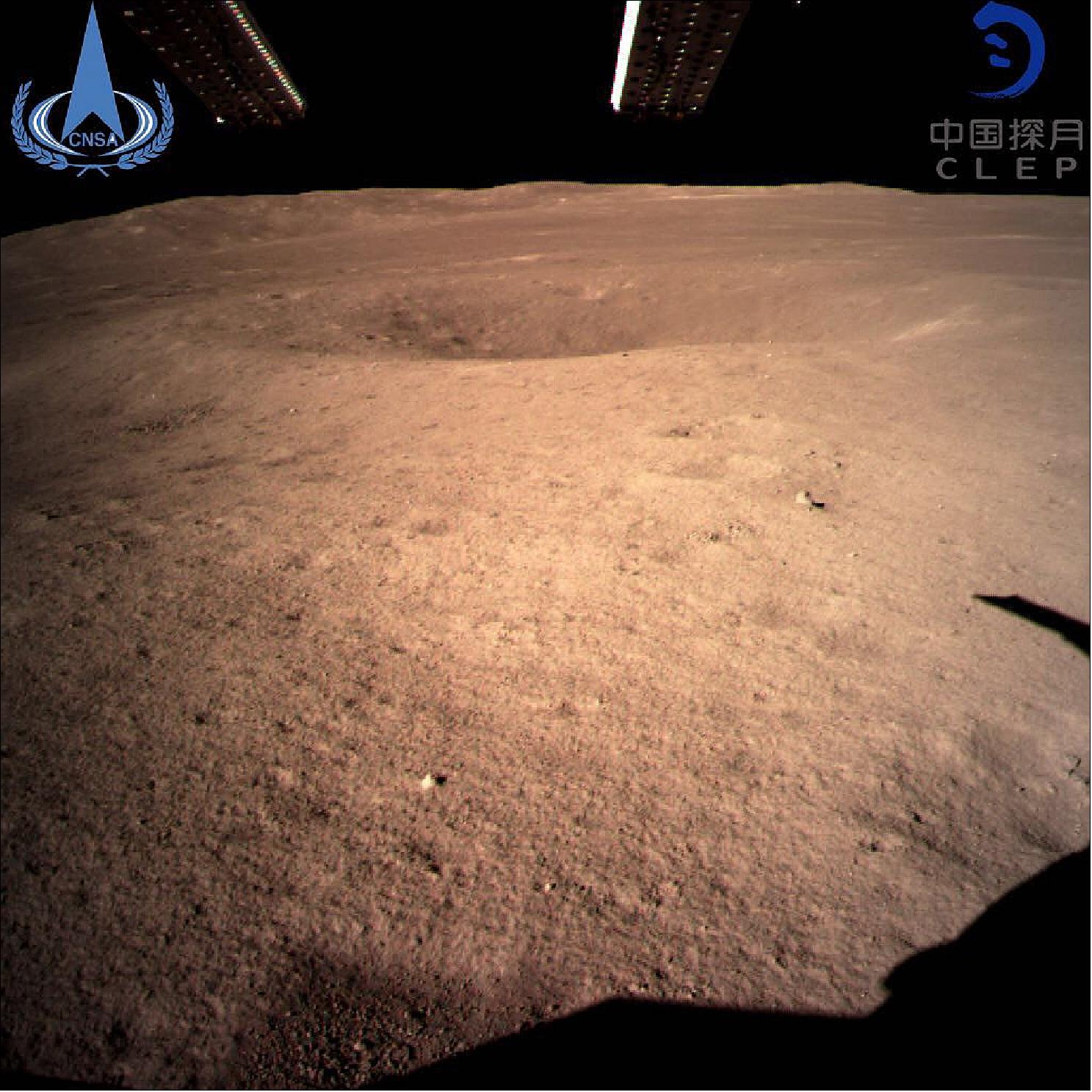
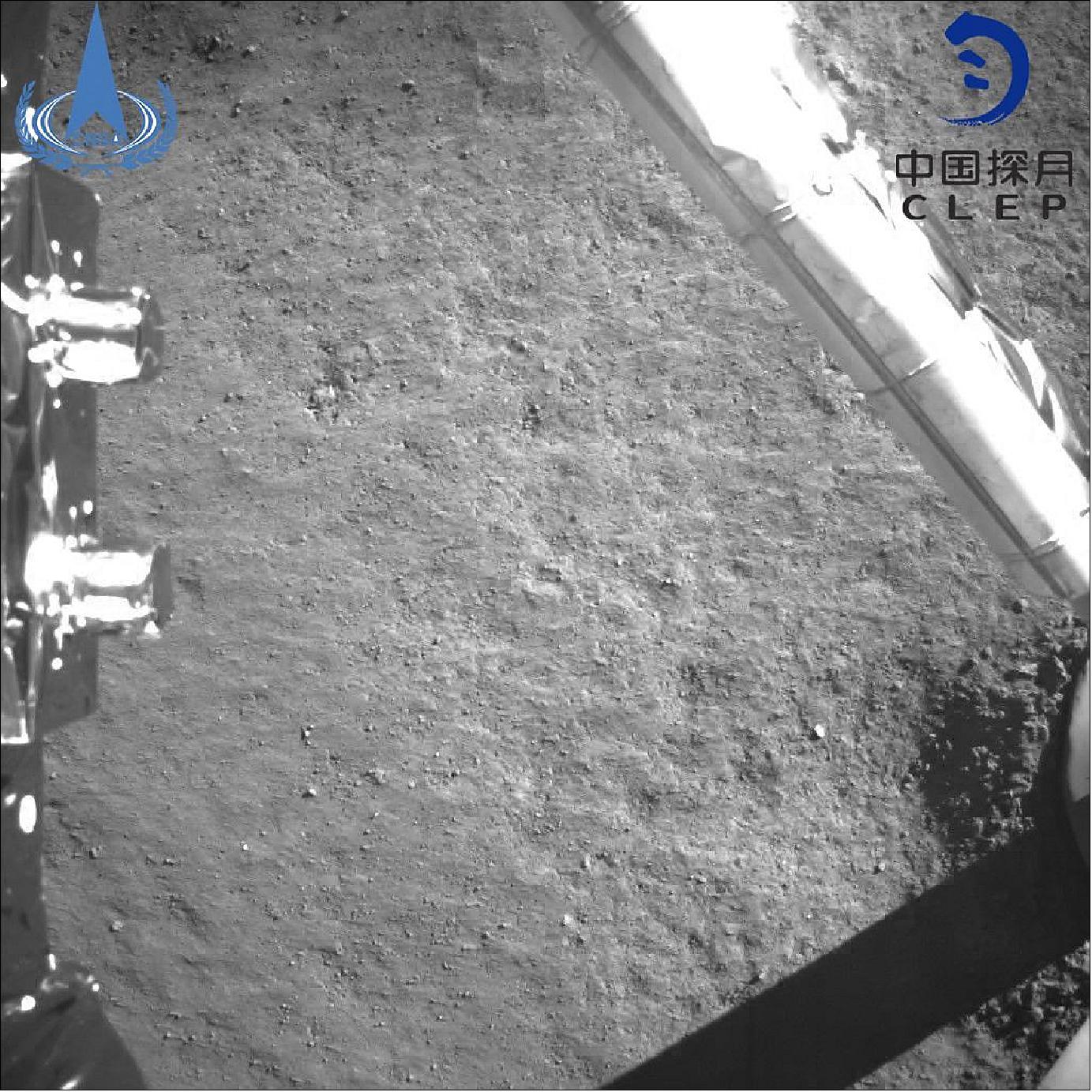
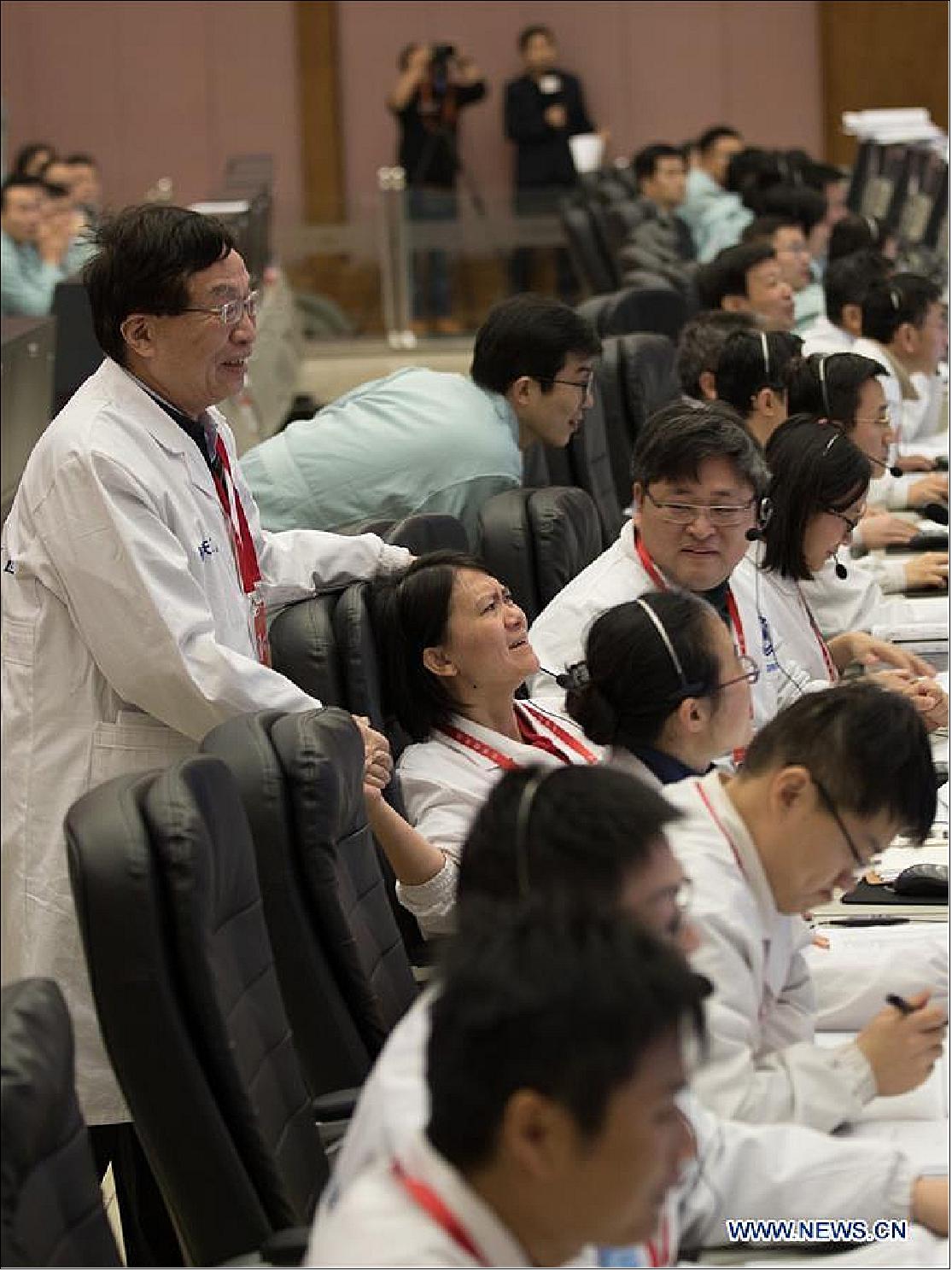
• December 12, 2018: China's Chang'e-4 probe decelerated and entered the lunar orbit Wednesday (12 December), completing a vital step on its way to make the first-ever soft landing on the far side of the moon, CNSA (China National Space Administration) announced. 77)
- After flying about 110 hours from Earth, an engine on the probe was ignited when it was 129 km above the surface of the moon, in line with instructions sent from a control center in Beijing at 4:39 p.m. CST (08:39 UTC ), and then the probe slowed and entered an elliptical lunar orbit with the perilune at about 100 km at 4:45 p.m., said CNSA.
- The probe, including a lander and a rover, was launched by a Long March-3B carrier rocket last Saturday (7 December 2018) from the Xichang Satellite Launch Center in southwest China's Sichuan Province, opening a new chapter in lunar exploration.
- As the rocket was able to send the probe into orbit precisely as planned, the control center only adjusted the probe's orbit once on Sunday and also canceled two pre-planned orbit trimmings before the near-moon deceleration, CNSA said.
- Next, the control center will adjust the probe's orbit around the moon and test the communication link between the probe and the relay satellite "Queqiao," which is operating in the halo orbit around the second Lagrangian (L2) point of the Earth-moon system.
- Afterwards, the control center will choose a proper time to land the probe on the far side of the moon, according to CNSA.
Lander Sensor Complement
Bearing in mind the features of the farside of the Moon, scientific payloads usually include a low-frequency radio spectrometer (LFS), an infrared spectrometer, a panoramic camera, a lunar radar, etc. The LFS is newly developed for the farside exploration and is implemented in the lander and the rover for the comparison and analysis of data collected (Ref. 9).
LFS (Low Frequency Spectrometer)
Low-frequency radio frequency spectrum analyzer for detection of low-frequency radio frequency characteristics of the sun and the moon's low-frequency radio environment to perform low-frequency radio astronomy observations.
The LFS is used for detecting the low-frequency electric field of the solar storm and to study the Lunar plasma. By detecting the low-frequency electric field from the Sun, the planetary space and the galactic space, the information of electric magnitude, phase, time variance, frequency spectrum, polarization and DoA (Direction of Arrivals) are collected for analysis. With features of variation of the spatial low-frequency electric field, the Lunar plasma environment above the landing site will be analyzed. The LFS is configured with a three-component decomposition active antenna to receive electromagnetic signals from the Sun and from space. Each of the three antenna units receives one of the three orthogonal components of the electromagnetic signals. According to radio transmission theory, information such as the electromagnetic intensity, the frequency spectrum, the time variance, the polarization features and the direction of radiation source are obtained by analyzing and processing the exploration data.
LCAM (Landing Camera)
LCAM is used for optical imaging of the landing area during descent to investigate surface morphology and geological structure.
TCAM (Terrain Camera)
The objective of TCAM is for optical imaging of the landing area to investigate surface morphology and geological structure.
LND (Lunar Lander Neutrons and Dosimetry Experiment)
The LND effort is led by the Christian-Albrechts-University in Kiel (CAU), Germany, with contributions from the Institute for Aerospace Medicine of the German Space Center, the National Space Science Center (NSSC), the National Astronomical Observatories (NAOC) from the Chinese Academy of Sciences (CAS), and the China Academy of Space Technology (CAST). LND is supported by DLR (German Space Agency) through the Federal Ministry of Economics and Technology.
The LND instrument will be accommodated on the Chang'e-4 Lander and has two major science objectives: 78)
1) dosimetry for human exploration of the Moon and
2) contribute to heliospheric science as an additional measuring point.
To achieve the first objective, LND is designed to measure time series of dose rate and of linear energy transfer (LET) spectra in the complex radiation field of the lunar surface. For the second objective, LND is capable to measure particle fluxes and their temporal variations and thus will contribute to the understanding of particle propagation and transport in the heliosphere. Its stack of 10 silicon solid-state detectors (SSDs) allows to measure protons from 10-30 MeV, electrons from 60-500 keV, alpha particles from 10-20 MeV/n and heavy ions from 15-40 MeV/n. In addition, LND can measure fast neutrons in the energy range from 1-20 MeV and, using two Gd-sandwich detectors, measure fluxes of thermal neutrons, which are sensitive to subsurface water and important for understanding lunar surface mixing processes.
Instrument concept: The zenith-pointing LND is mounted inside the payload compartment of the Chang’E 4 lander and consists of a thermally decoupled sensor head and an electronics box (Figure 33). The sensor head consists of a stack of 10 SSDs (Figure 4) as well as two Printed Circuit Boards (PCBs). One PCB is used to pre-amplify the detector signals, the other PCB contains shaper circuits and the Analog to Digital Converters (ADCs). These digitized signals are sent from the sensor head to the electronics box which accumulates the data into histograms, count rates, PHA words, etc., packetizes them and sends them to the Instrument Control Unit (ICU). The latter serves as the electrical and data interface with the lander.
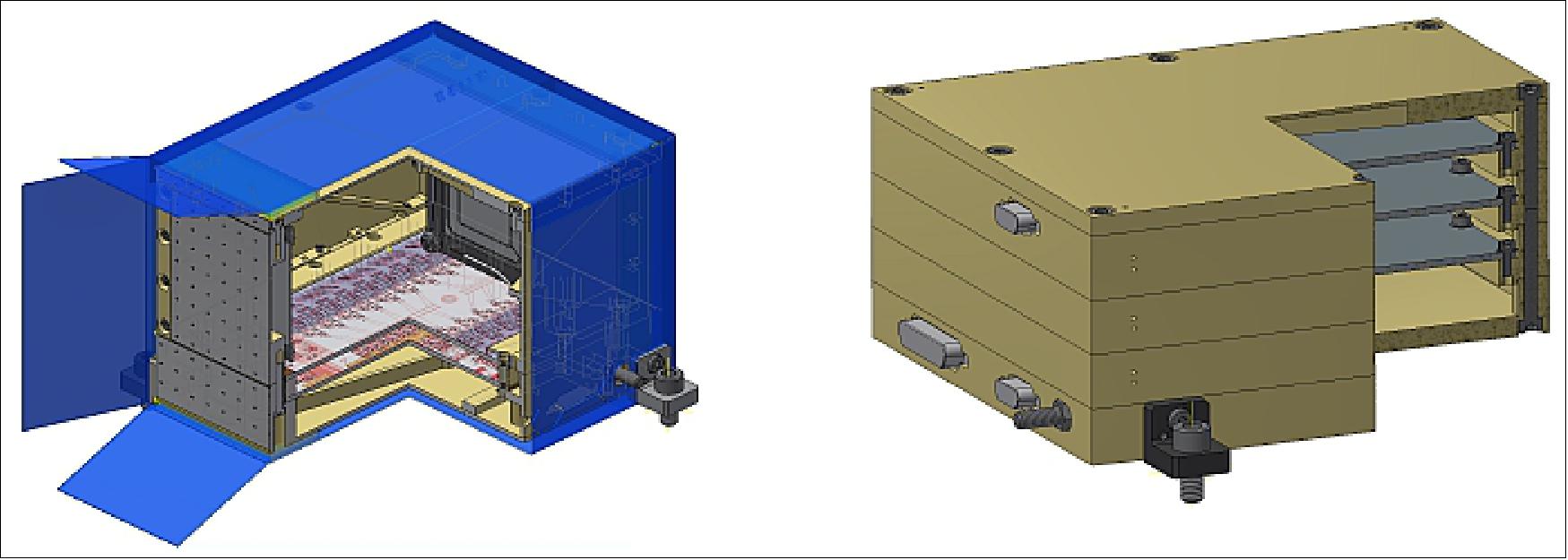
Measuring fast neutrons: Fast neutrons are generated by the interaction of the galactic cosmic rays with the lunar regolith and are an important source of the radiation dose reaching the interior of an astronaut’s body. LND uses three segmented Si SSDs which are as closely packed as possible to detect fast neutrons. The innermost segment of the C detector in Figure 34, C1, measures neutral radiation in anti-coincidence with all outer segments (B1&B2, D1&D2, C2). LND’s response to neutral radiation (n, γ) is shown in Figs. 7 and 8.
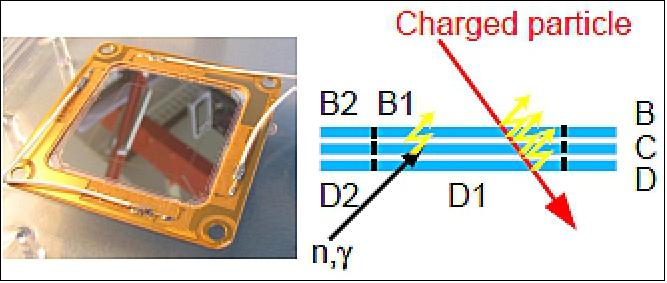
Sensor Head Design: LND is largely based on developments which were made for IRAS (Ionizing Radiation Sensor) in an early phase of ExoMars. As shown in Fig. 4, LND is basically a telescope consisting of ten segmented SSDs (A-J). Three detectors (B, C, and D) are packed as close together as possible to measure neutrons in the energy range 1-20 MeV (see section 3). The lower six detectors (E-J) are mounted in two different sandwich configurations. In one each sandwich clamps a very thin (~20 µm) Gd foil (shown in red) to detect thermal neutrons. To discriminate thermal neutrons which are emitted from the lunar soil (and are thus sensitive to the subsurface proton (water) content), the GH sandwich is shielded from above by a thicker Gd foil which is encased in two thick Al sheets. The GH sandwich then measures thermal neutrons from below and the EF sandwich thermal neutrons from above. The lowermost sandwich is a copy of the IRAS BCsandwich and serves as the final detector in the stack. The J detector serves as an anticoincidence to discriminate stopping particles from penetrating ones.
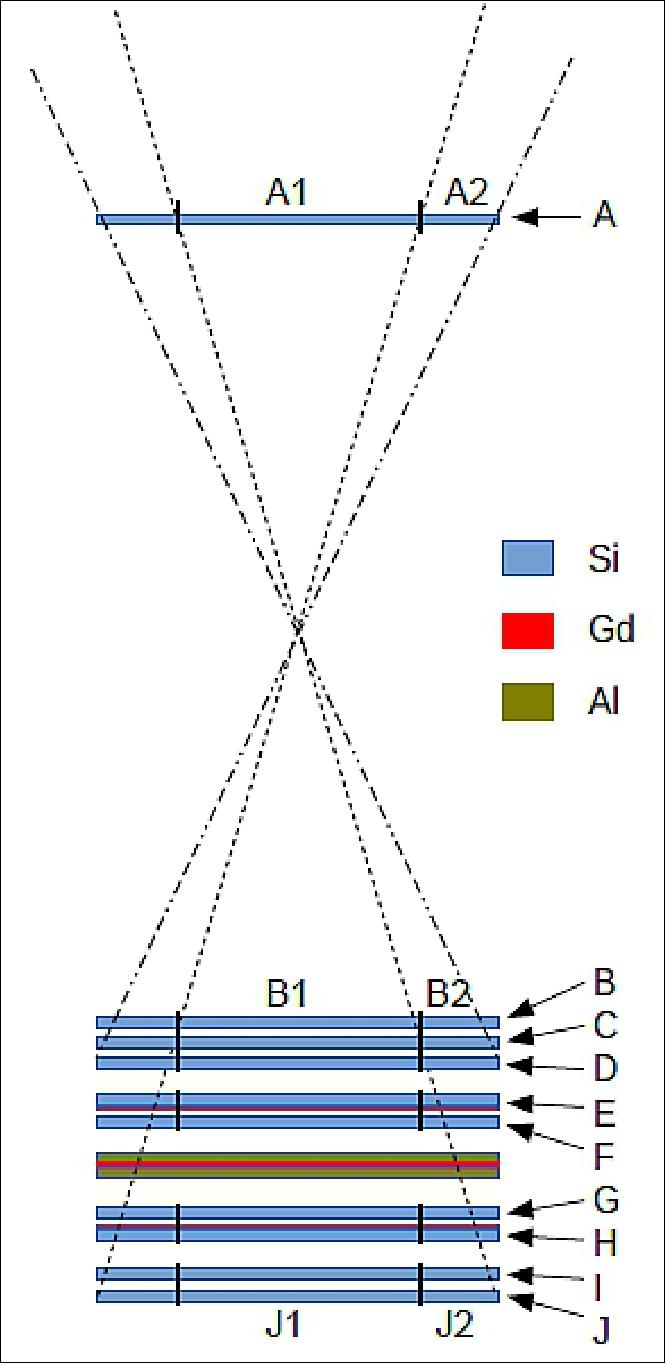
Measuring thermal neutrons using Gd converters: Natural gadolinium (Gd) has a very large cross section for thermal neutrons (48’890 b). After neutron capture, the Gd nuclei have a large probability to decay via internal conversion emitting electrons with energies of 29, 72, 78, and 132 keV (Figure 36). LND uses a 20 µm thin natural Gd foil as a neutron converter. The electrons which escape from the foil can then be measured in the adjacent Si SSDs in anticoincidence with the surrounding detectors.
LND will have to use a fairly thick (20 µm) foil. While our initial sputtering tests were successful, the sputtered Gd on the flight detectors showed bubbles (Figure 37).

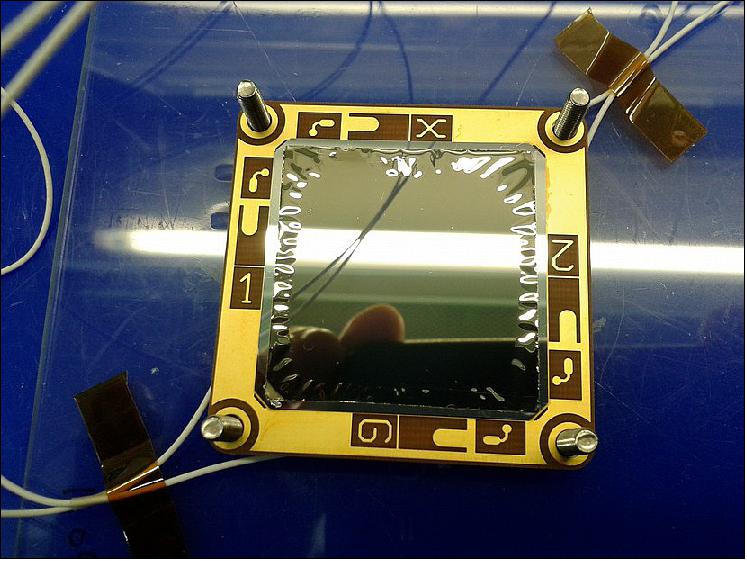
Geant4 Simulations: We used Geant4 to simulate the performance of LND. Figure 38 shows the instrument response functions (IRFs) for the inner C segment (C1) for gamma and neutron particles. It is dominated by neutrons for energy deposits above 1 MeV.
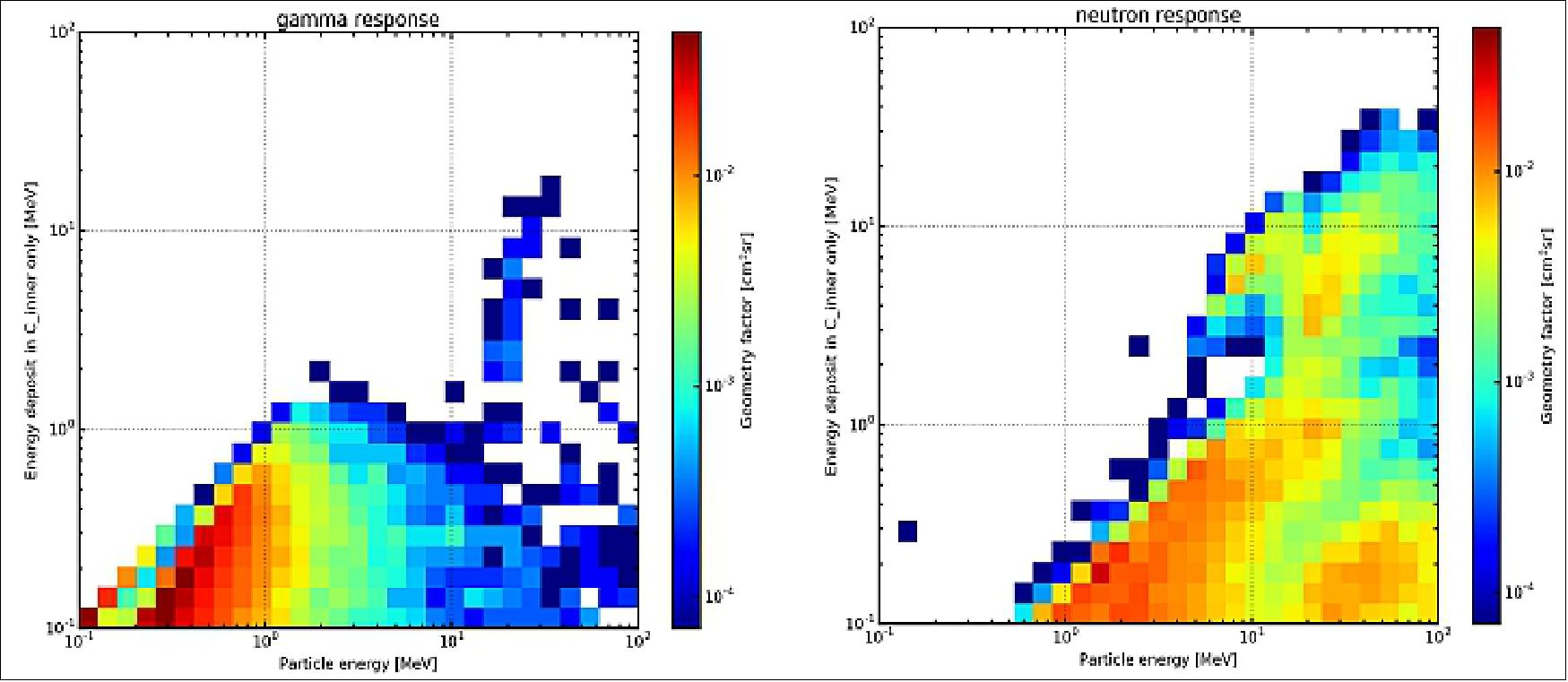
As discussed in section 3, LND measures fast neutrons by using an anti-coincidence of C1 with (B1&B2, D1&D2, and C2). Thus, if only the C1 segment was triggered, this was due to a neutron or gamma, because both of them only interact weakly with the Si-nuclei in the detector compared with charged particles, e.g., protons and electrons. The expected spectrum of neutral radiation energy deposits in C1 shown in Figure 39 was obtained using a GEANT4-model of the lunar surface neutron and gamma spectra folded with the LND IRF. It is dominated by gammas at low energies. Above about 700 keV, neutrons start to dominate, e.g., at energies above 1 MeV, we expect only about 0.01 gamma, but ~0.03 neutron counts per second.
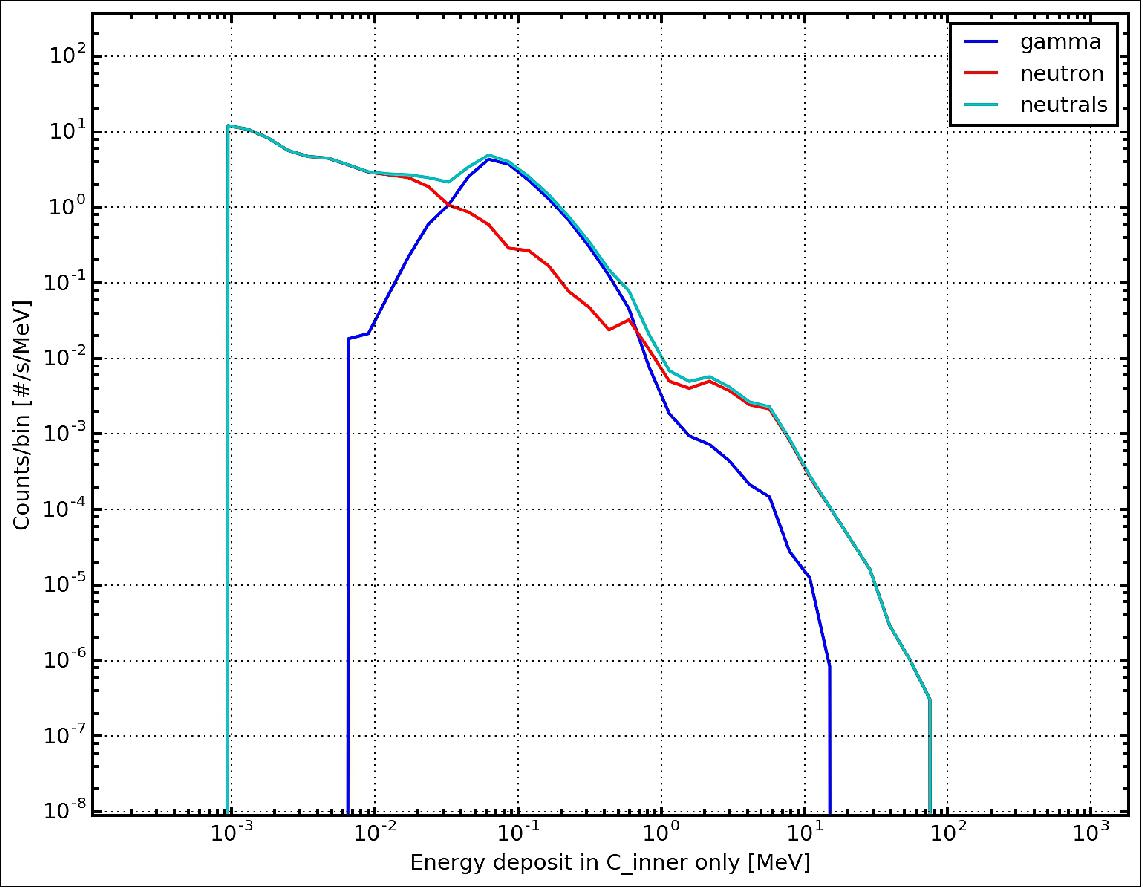
Data Products: The raw data of LND is processed by LND on board and telemetered to Earth via an Earth-Moon L2 relay satellite. LND data products and their cadences are given in the table to the left. LND provides measurements of interest for dosimetry, lunar regolith science, as well as heliophysics. After receipt on ground, instrument response functions will be applied to the data, and visual inspections will be performed at CAU (Christian-Albrechts-University in Kiel, Germany) and at NSSC (National Space Science Center) China. LND data will be made available to the scientific community via the usual channels.
Number | Measurement | Cadence |
1 | Dose rate in SI | 1 minute |
2 | Neutral particle dose rate | 1 minute |
3 | Housekeeping | 1 minute |
4 | Pulse height analysis words | 1 minute |
5 | Proton energy spectra up to around 20 MeV | 5 minutes |
6 | Electron spectrum | 5 minutes |
7 | Thermal neutron counts | 5 minutes |
8 | Alpha-particle spectrum up to around 20 MeV /nuc | 15 minutes |
9 | LET-spectra in the range 0.1-430 keV/µm | 15 minutes |
10 | Fast neutrons in the range 1-20 MeV | 15 minutes |
11 | 3He spectrum up to roughly 20 MeV/nuc | 30 minutes |
12 | Composition of the radiation | 30 minutes |
Rover Sensor Complement
Chang’e-4 mission has been planned to install six kinds of scientific payloads to complete the corresponding tasks, three kinds of payloads on the lander are the Landing Camera (LCAM), the Terrain Camera (TCAM), and the Low Frequency Spectrometer (LFS), and three kinds of payloads on the rover are the Panorama Camera (PCAM), the Lunar Penetrating Radar (LPR), and the Visible and Near-Infrared Imaging Spectrometer (VNIS). The LFS is newly developed for Chang’e-4 lander, and other five kinds of payloads are the inherited instruments from Chang’e-3. 79)
Besides the above six payloads, there are also three international joint collaboration payloads to be installed on the Chang’e-4 explorer, which are the Lunar Lander Neutrons and Dosimetry(LND) installed on the lander, the Advanced Small Analyzer for Neutrals(ASAN) installed on the rover, Netherlands-China Low-Frequency Explorer (NCLE) installed on the relay satellite.
PCAM (Panoramic Camera)
The objective of PCAM is to obtain three-dimensional images of the landing and patrolling lunar surface for investigation of surface morphology and geological structure.
LPR (Lunar Penetrating Radar)
LPR is of Chang'e-3 heritage. The objective of LPR are the mapping of lunar regolith and detection of subsurface geologic structures.
VNIS (Visible and Near-Infrared Imaging Spectrometer)
VNIS is of Chang'e-3 heritage. VNIS is capable of simultaneously in situ acquiring full reflectance spectra for objects on the lunar surface and performing calibrations. VNIS uses non-collinear acousto-optic tunable filters and consists of a VIS/NIR imaging spectrometer (0.45–0.95 µm), a shortwave IR spectrometer (0.9–2.4 µm), and a calibration unit with dust-proofing functionality.
ASAN (Advanced Small Analyzer for Neutrals)
ASAN was developed by the Swedish Institute of Space Physics (IRF) in Kiruna.
• Moon radar for surveying the lunar sub-surface structure to investigate surface morphology and geological structure
• Infrared imaging spectrometer for patrol area lunar surface infrared spectroscopy and imaging exploration to survey lunar surface material composition and available resources
• Lunar neutron and radiation dose detector (LND, Germany) neutral atomic detector (ASAN, Sweden) for observations of energy-neutral atoms and positive ions in patrol area to investigate the particle radiation environment in the patrol area.

On April 7, 2018, the Swedish Institute of Space Physics (IRF) successfully delivered the flight model of the ASAN (Advanced Small Analyzer for Neutrals) instrument to the National Space Science Center of the Chinese Academy of Sciences in Beijing, China. The ASAN instrument will be launched at the end of 2018 onboard the Chinese Chang'e-4 mission to the Moon. 80)
Relay Satellite / Queqiao of China
The Chang'e-4 relay satellite (CE-4R), named Queqiao ('magpie bridge'), is a precursor to an unprecedented attempt to soft-land the Chang'e-4 satellite on the lunar far side in late 2018, when a lander and rover will be send to the Moon. Since the lunar far side does not face the Earth as the moon’s orbital period matches its rotational period, a relay satellite is required to facilitate communications between the Chang'e-4 lander on the far side of the moon and ground stations on Earth.
The nickname Queqiao was announced by CNSA (China National Space Administration) on 25 April 2018, China's Space Day. In a Chinese folktale, magpies form a bridge with their wings on the seventh night of the seventh month of the lunar calendar to enable Zhi Nu, the seventh daughter of the Goddess of Heaven, to cross and meet her beloved husband, separated from her by the Milky Way. 81) 82)
This is the main role of the 425 kg spacecraft, developed by the China Academy of Space Technology (CAST), which is being sent into position around six months before the landing mission in order to test and verify is functions.
The 425 kg relay satellite is based on the three-axis stabilized CAST-100 minisatellite bus featuring an 130 N hydrazine propulsion system. It carries a deployable 4.2 m dish antenna for the relay equipment. It provides four 256 kbit/s X-band links between itself and the lander/rover and one 2 Mbit/s S-band link towards Earth.
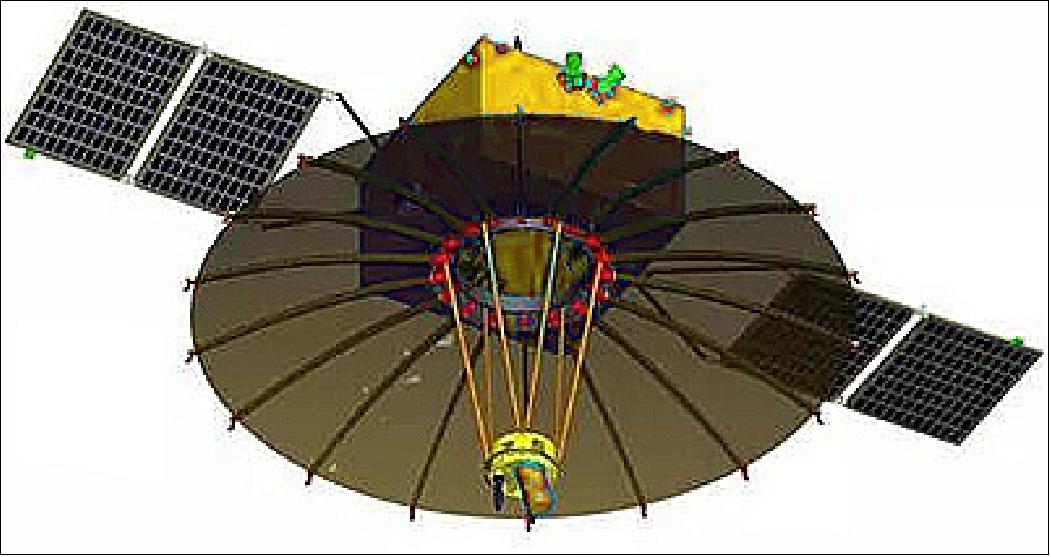
Launch
The Chang'4 relay satellite (Queqiao) was launched on 20 May 2018 (21:28 UTC) on a Long March-4C vehicle from the XSLC (Xichang Satellite Launch Center) in China. 83)
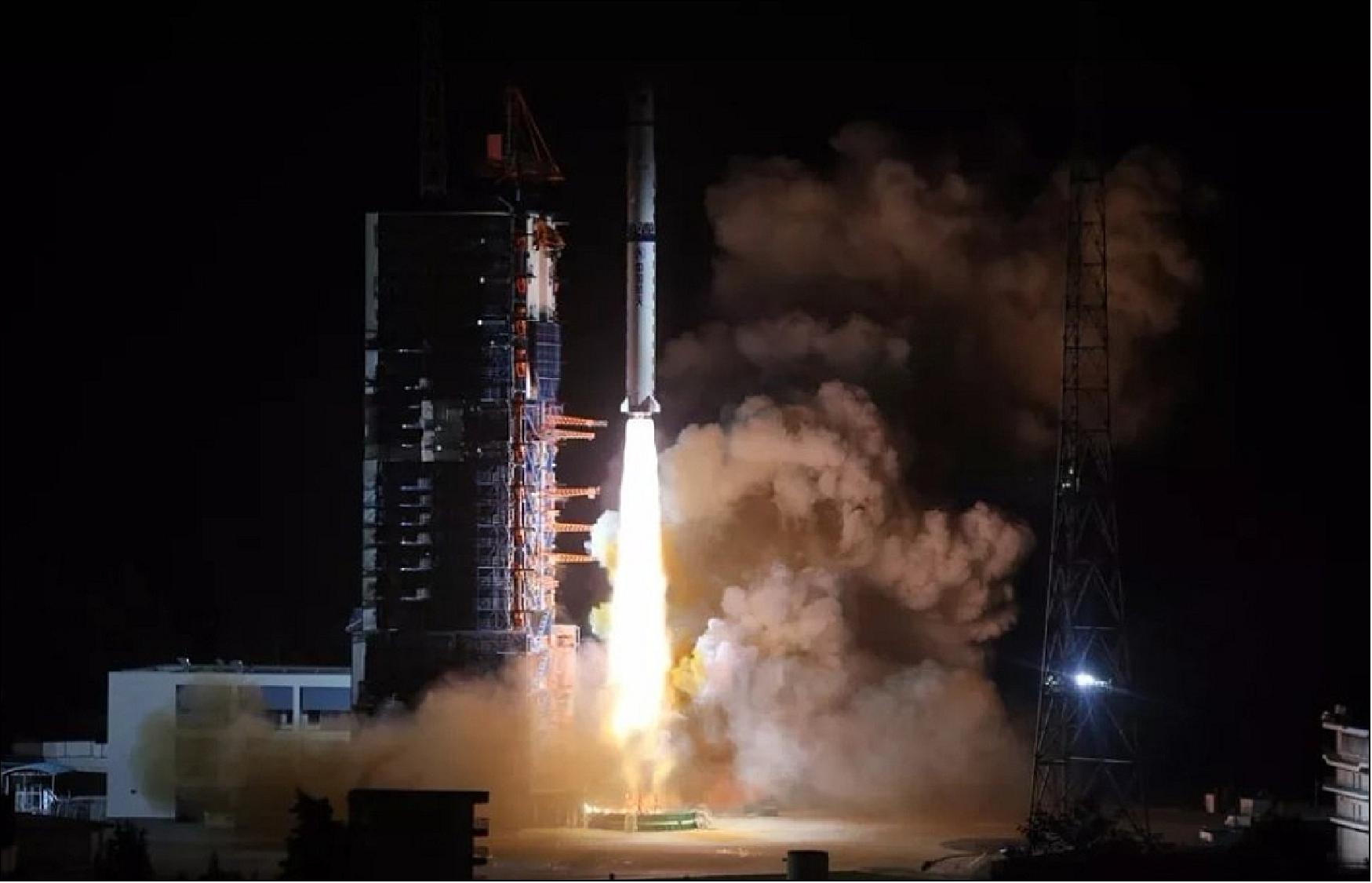
Orbit: Halo orbit of the Earth-Moon L2 (Lagrangian Point 2), around 65,000 km on the far side of the moon, so as to be visible to both ground stations on the Earth and the lander and rover on the lunar far side at all times.
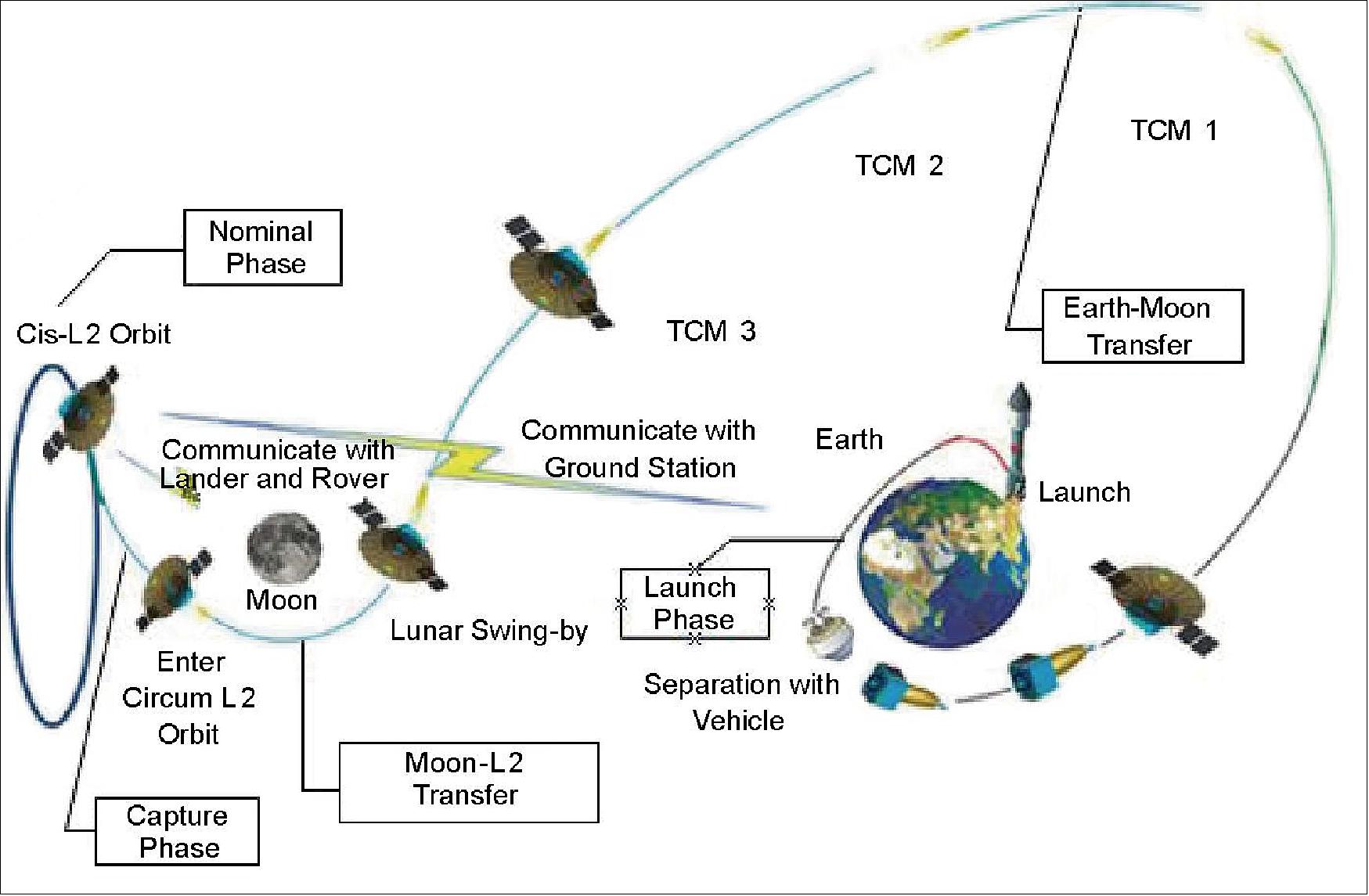
Secondary Payloads
Two Chinese microsatellites, DSLWP -A and -B (Discovering the Sky at Longest Wavelengths Pathfinder), also referred to as Longjiang-1 and Longjiang-2, were launched with the Chang’e 4 relay mission to conduct astronomical observations from deep space (Selenocentric, elliptical orbit).The two microsatellites were developed by the Harbin Institute of Technology. Each microsatellite has a mass of 47 kg. 84)
They will be inserted into 200 km x 9000 km lunar orbits. The satellites are three-axis stabilized and carry a radio-astronomy payload featuring two linear polarization antennas mounted along and normal to the flight direction, which uses the moon as a shield to avoid radio emanations from earth. Additionally, the microsatellites carry a KACST (King Abdulaziz City for Science and Technology) developed micro-optical camera and an amateur radio communications system.

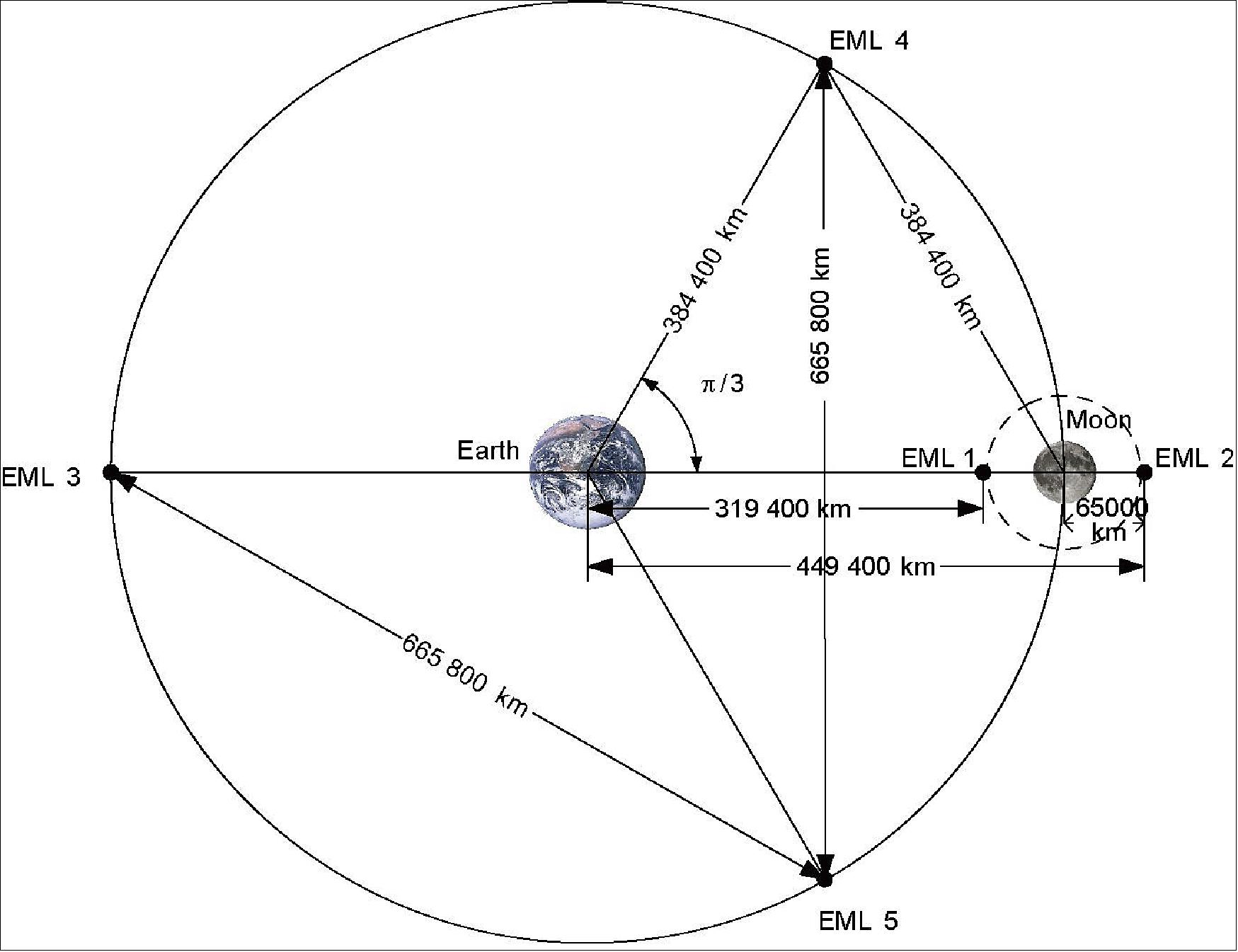
The relay satellite orbiting around the Earth-Moon L2 point is about 60000–80000 km away (halo orbit) from the lander and the rover working on lunar surface. Under the constraints of the launching mass and size, the relay communication link should be optimized in multiple aspects such as the relay transmission modes and the high gain relay antenna development to achieve high-bit-rate communication.
Relay communications: The link between Change’4 relay satellite and lander/rover is designed to work on X-band. The forward link uses unified carrier-wave TT&C regime and the backward uses BPSK. The forward relay signal emitter should be able to scan with complex frequency carrier waves, similar to ground stations. The relay satellite should be able to transmit data to Earth and relay with the lander and the rover simultaneously. To avoid interference, the relay link adopts X-band channel, and TT&C to Earth chooses S-band unified carrier wave regime and the data transmission utilizes S-band and BPSK carrier wave regime. Channel encoding is not used for telecommand transmission and RS+concatenated convolution channel encoding is adopted for telemetry and data transmission. Meanwhile for the purpose of synchronous encoding with the ground, both telemetry and data pseudo-random coded.
Relay communication link design: The link profile among the relay satellite, the lander and the rover and ground stations is as shown in Figure 46. The forward data is emitted from the relay satellite, the lander and the rover receive data via omnidirectional antenna and the signals are modulated in PCM/PSK/PM. The backward data is transmitted via an omnidirectional antenna, a medium gain antenna or a directional antenna and is received by the relay satellite. The backward link data of the rover is transmitted by the omnidirectional antenna or the directional antenna and is received by the relay satellite. The lander backward link adopts omnidirectional antenna, medium gain antenna and directional antenna corresponding to low, medium and high bit rates. The modulation mode of the backward link is BPSK.
During the powered descent process, except for setting up X-band omnidirectional forward/backward relay communication links, the lander and the relay satellite also communicate via a medium gain antenna to return landing camera data back to Earth.
While working on the Lunar surface, the lander and the rover respectively receives forward telecommand signals via an omnidirectional antenna from the relay satellite. The relay satellite can send data at two frequency points at the same time to realize simultaneous control of the lander and the rover. Following the command, the lander and the rover send backward data (including telemetry and scientific exploration data) via an omnidirectional antenna or a directional antenna.
The relay satellite can receive backward data from both the lander and the rover simultaneously.
Phase | Lander | Lunar rover |
Earth-Moon transfer | Directly communicates with ground TT&C stations | Idle |
Moon orbiting | a) Directly communicates with ground TT&C stations; | Idle |
Powered descent | a) Telemetry and Telecommand data transmission with relay satellite; | Idle |
Working on Lunar surface | TT&C and scientific exploration data transmission via relay satellite | TT&C and scientific exploration data |
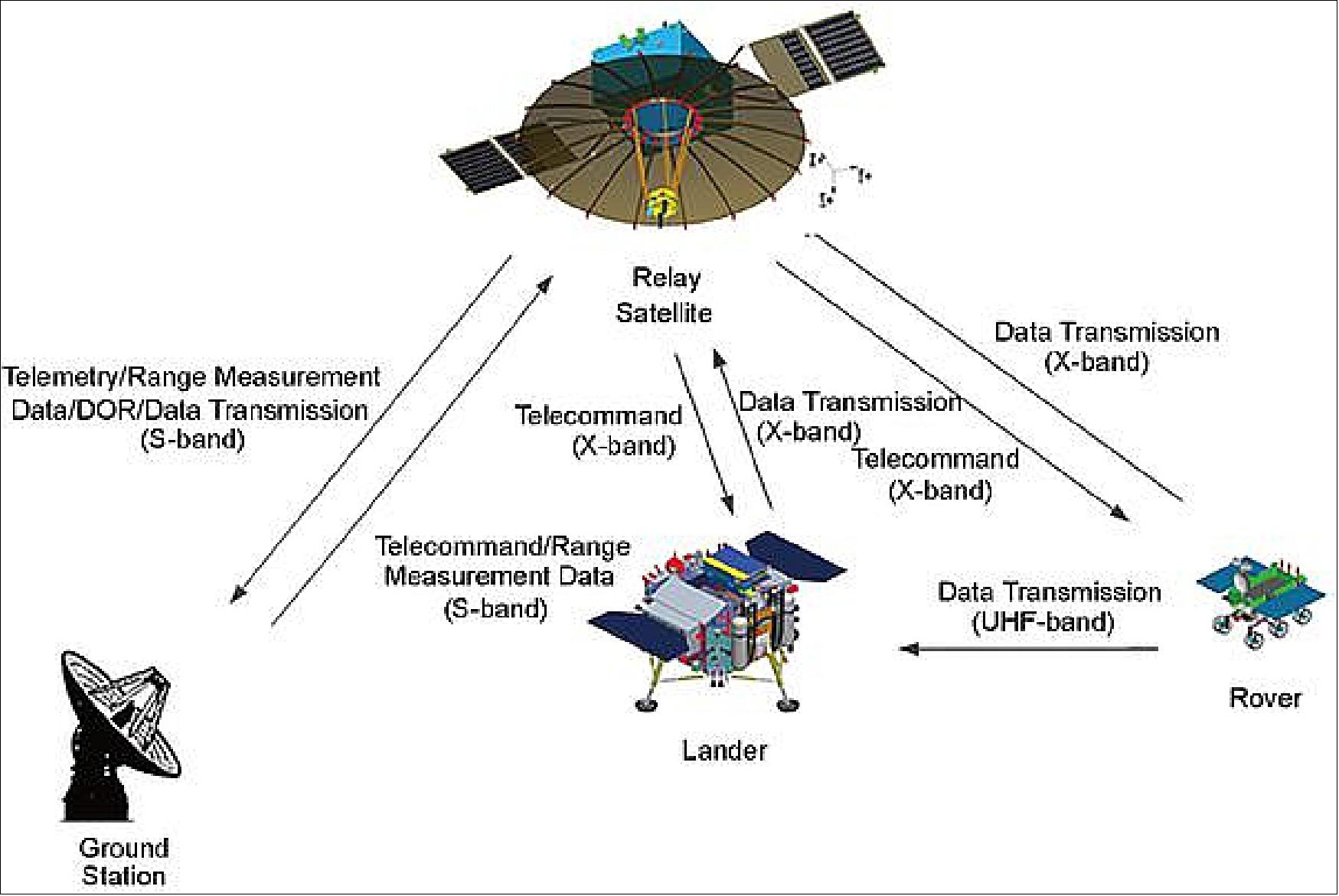
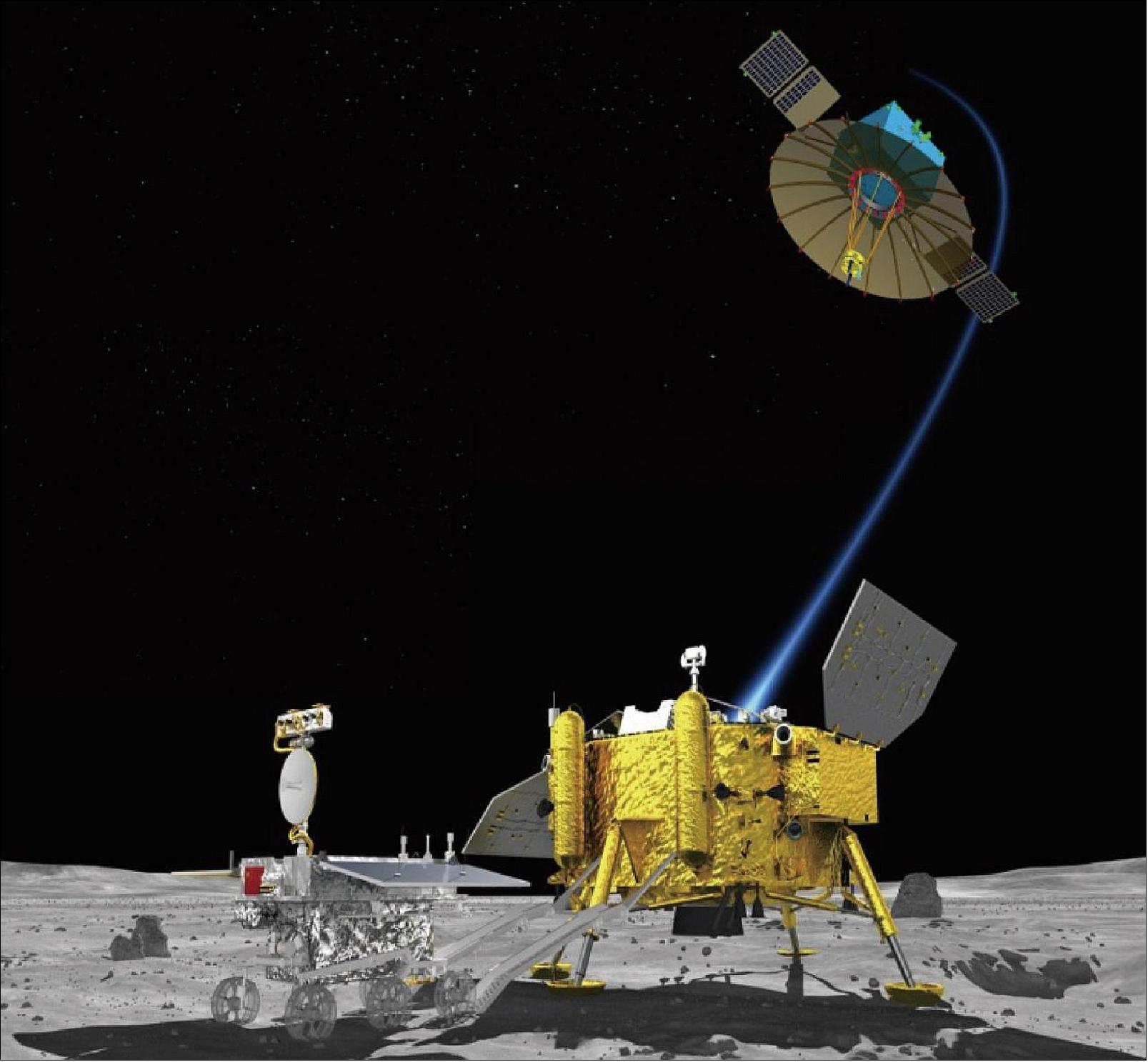
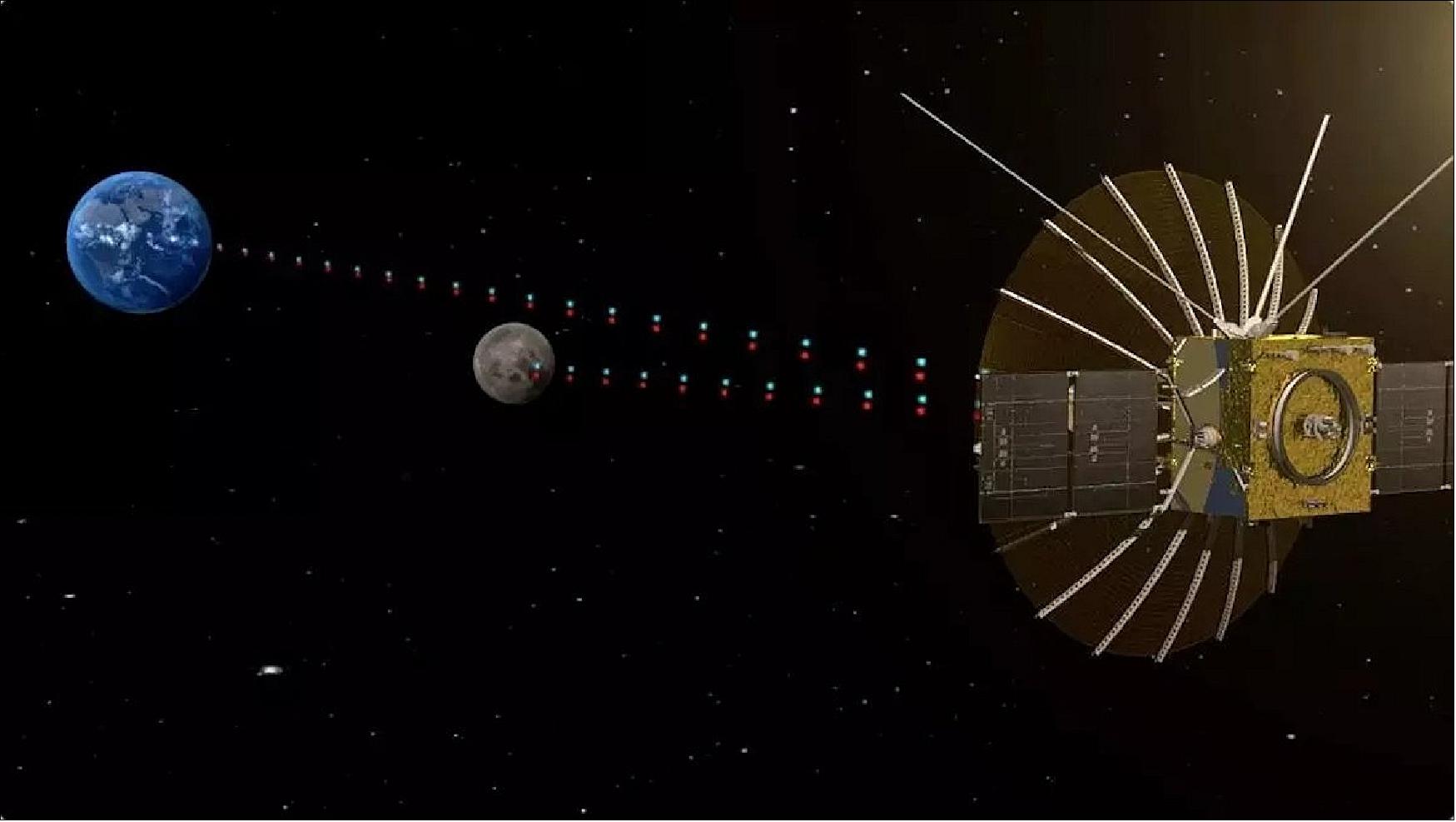
Mission Status
• June 11, 2021: Because of a phenomenon called gravitational locking, the Moon always faces the Earth from the same side. This proved useful in the early lunar landing missions in the 20th century, as there was always a direct line of sight for uninterrupted radiocommunications between Earth ground stations and equipment on the Moon. However, gravitational locking makes exploring the hidden face of the moon - the far side - much more challenging, because signals cannot be sent directly across the Moon towards Earth. 85)
- Still, in January 2019, China's lunar probe Chang'e-4 marked the first time a spacecraft landed on the far side of the Moon. Both the lander and the lunar rover it carried have been gathering and sending back images and data from previously unexplored areas. But how does Chang'e-4 probe communicate with the Earth? The answer is Queqiao, a relay communications satellite, explains Dr. Lihua Zhang from DFH Satellite Co., Ltd., China.
- As explained by Dr. Zhang in a review paper recently published in Space: Science and Technology, Queqiao is an unprecedented satellite designed specifically for one purpose: to act as a bridge between Chang'e-4 probe and the Earth. Queqiao was launched in 2018 and put into orbit around a point 'behind' the Moon. 86)
- This point is known as the Earth-Moon Libration point 2, where a special case of gravitational balance allows Queqiao to maintain an orbit such that it has almost constant direct line of sight with both the far side of the Moon and the Earth. Getting the satellite into this peculiar orbit required careful planning and maintenance management, and the success of this operation set a precedent for future attempts at putting satellites in orbit around other Earth-Moon libration points.
- From its stable place in space, Queqiao helped guide the soft-landing and surface operations of Chang'e-4 probe and has been our intermediary with it ever since. The satellite is equipped with two different kinds of antennas: a parabolic antenna and several spiral antennas. The former, which has a large diameter of 4.2 m, was designed to send and receive signals on the X-band (7-8 GHz) to and from the rover and lander on the surface of the Moon. Its large size is related the expected noise levels and the low intensity of the transmissions that are sent by surface equipment.
- On the other hand, the spiral antennas operate on the S-band (2-4 GHz) and communicate with Earth ground stations, forwarding commands to the lunar surface equipment and exchanging telemetry and tracking data. Most notably, all these different links can transmit and receive simultaneously, making Queqiao highly versatile. The review paper addresses other important design considerations for Queqiao and future relay satellites, such as the use of regenerative forwarding, the various link data rates involved, and data storage systems for when no Earth ground station is accessible.
- Over two years of exploration, a great amount of data has been received from the rover and lander through Queqiao. "Scientists in both China and other countries have conducted analysis and research based on the retrieved data, and they have produced valuable scientific results. The longer the operational life of Queqiao, the more scientific outcomes will be achieved," remarks Dr. Zhang. Based on current predictions, Queqiao should be operable on mission orbit for at least five years.
- Dr. Zhang also addressed the prospects for future lunar missions and how relay communication systems should evolve to support them. Many unexplored areas on the Moon, such as the largest crater at the South Pole, call for multiple relay satellites to maintain constant communication links, which poses an expensive and time-consuming challenge. But what if relay satellites were suitable for more than a single mission?
- "A sustainable communication and navigation infrastructure should be established to benefit all lunar missions rather than dealing with each mission independently," comments Dr. Zhang,
- "This infrastructure should adopt an open and extensible architecture and provide flexible, interoperable, cross-supportable, and compatible communications services, which are critical to the success of future lunar explorations." It's likely that future endeavors on the far side of the Moon will be a test on how well we can cooperate to unveil the secrets of our natural satellite.
• November 26, 2019: The three antennas on the Dutch-Chinese radio telescope, which is currently located behind the moon, have been unfolded. This was officially announced today by the Dutch team. The Netherlands-China Low Frequency Explorer (NCLE) hung in space waiting for over a year. This was longer than initially planned, as the accompanying communications satellite had to assist a Chinese lunar lander for a longer time. 87) 88)
- The Chinese satellite was previously mainly seen as a communications satellite. However, the Chinese moon mission has by now achieved its primary goals. Consequently, the Chinese have redefined the satellite to be a radio observatory. As such, the Netherlands-China Low Frequency Explorer is the first Dutch-Chinese space observatory for radio astronomy.
- Marc Klein Wolt, Managing Director of the Radboud Radio Lab and leader of the Dutch team, is happy: “Our contribution to the Chinese Chang’e -4 mission has now increased tremendously. We have the opportunity to perform our observations during the fourteen-day-long night behind the moon, which is much longer than was originally the idea. The moon night is ours, now.”
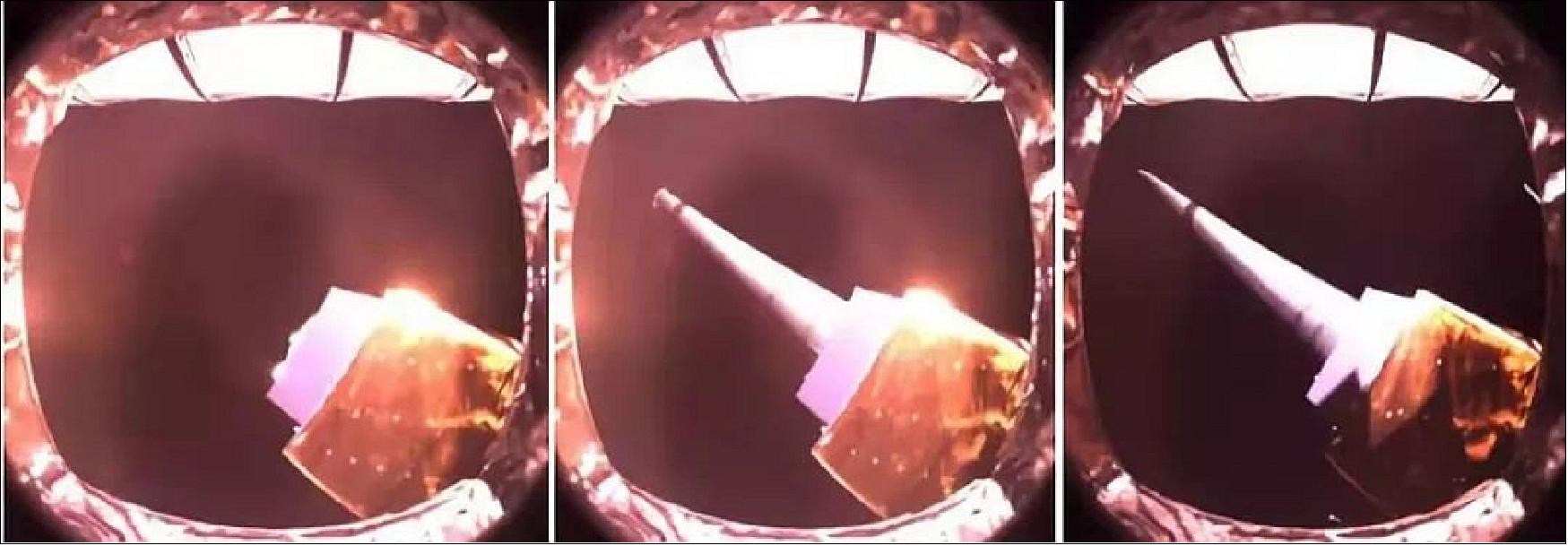
- Last week, Klein Wolt went to China with engineer Eric Bertels from the antenna manufacturer ISISpace to prepare the unfolding of the antennas. Bertels: “The launch eighteen months ago was already extremely thrilling, of course, but we had no hand in it. Now that our own instrument was concerned, things were rather different.”
- Albert-Jan Boonstra of ASTRON is pleased to see that the antennas have been unfolded after three years of hard work: “This is a unique demonstration of technology that paves the way for future radio instruments in space.”
- Heino Falcke of Radboud University and scientific leader of the Dutch-Chinese radio telescope can barely wait to get his hands on the first measurements. “We are finally in business and have a radio-astronomy instrument of Dutch origin in space. The team has worked incredibly hard, and the first data will reveal how well the instrument truly performs.”
- The longer stay behind the moon most probably did have an effect on the antennas. At first, the antennas unfolded smoothly, but as the process progressed, it became increasingly difficult. The team therefore decided to collect data first and perhaps unfold the antennas further at a later point in time. With these shorter antennas, the instrument is sensitive to signals from around 800 million years after the Big Bang. Once unfolded to their full length, they will be able to capture signals from just after the Big Bang.
Netherlands-China Low Frequency Explorer
- The Netherlands-China Low Frequency Explorer (NCLE) is a prototype radio telescope built to record weak radio signals from a period just following the Big Bang, called the Dark Ages. These signals are blocked by the Earth’s atmosphere, which is why the telescope was placed on a satellite and brought to a location behind the moon. With this satellite, called QueQiao, the China National Space Administration (CNSA) has been navigating a lunar lander that has been driving around the back of the moon since early 2019. The Netherlands-China Low Frequency Explorer was developed in the Netherlands by Radboud University (Nijmegen), ASTRON (Dwingeloo) and the ISISpace company (Delft), with support from the Netherlands Space Office.
• August 2019: The first switch on of the NCLE instrument happened 22 January 2019, where a first initial sanity check was performed to verify the instrument had survived the launch, transit to lunar orbit, and 9 months in lunar orbit (Ref. 100).
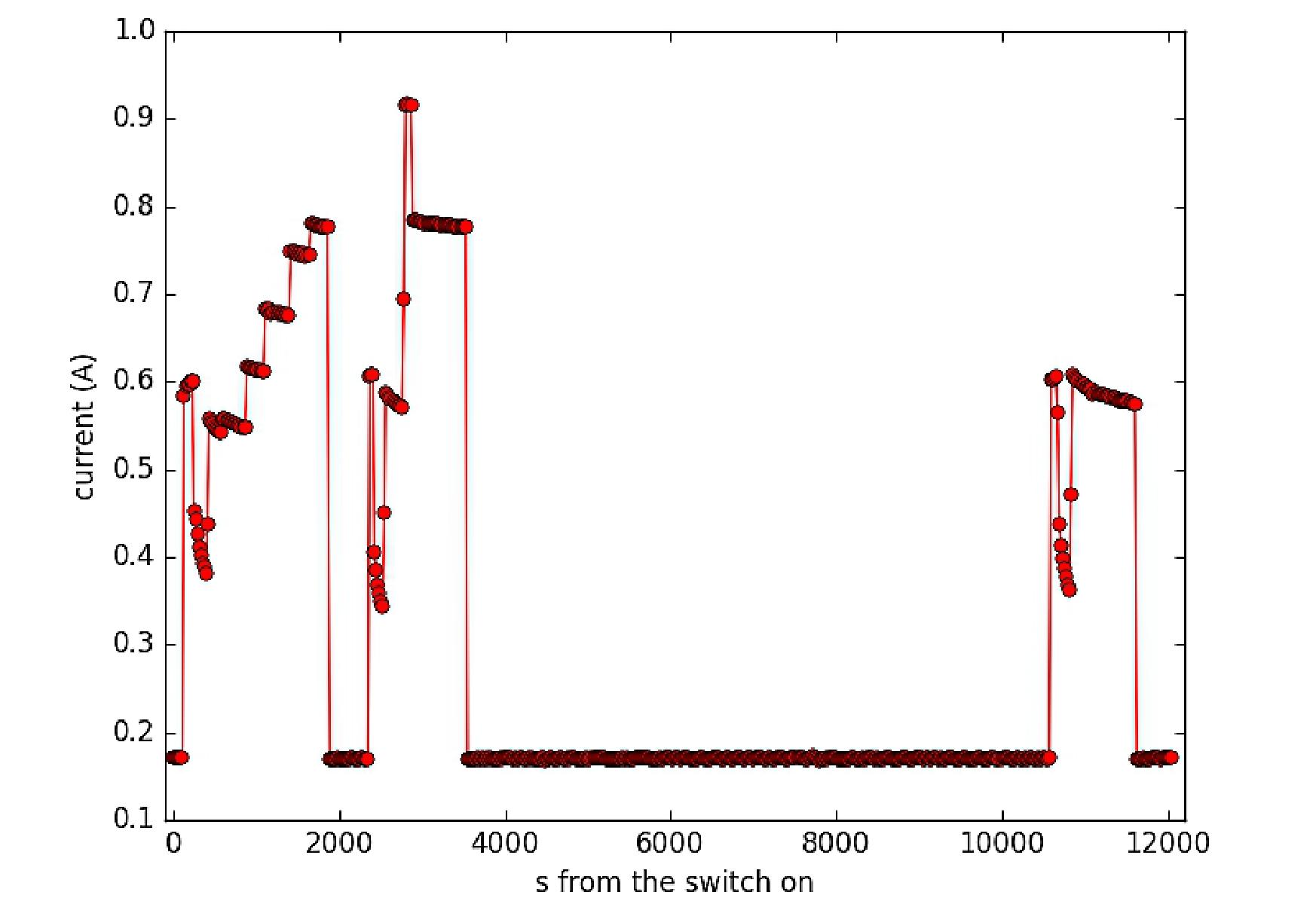
- Figure 50 shows the power drawn by the NCLE instrument, which is seen to increase as progressively more subsystems are switched on. From this figure we can clearly see that at t=120 seconds the switch-on was commenced, by powering up the DRS OCXO clock. After that the other subsystems were switched on one by one. The current drawn by the system is exactly at the level what it should be, signaling the start of commissioning.
- Currently, the instrument is undergoing a month worth of observations with antenna’s in stowed configuration to characterize the noise over an entire lunar orbit. After this, the antennas will be deployed up to 0.5 meter, after which they will be extended slowly up to the total 5 meters.
Future Roadmap
- NCLE is not supposed to be the last step in the quest to observe the early universe. Rather, it is considered to be a steppingstone mission towards more advanced missions and instruments. It all starts with the initial NCLE mission as described in this paper.
- This will be followed by not only developing the instrument, but a complete platform as well. These satellites will also be deployed into Lunar orbit to take full advantage of the lessons learnt during the development of this instrument.
- The last step is to have multiple of these satellites not only in lunar orbit, but even further out. The combination of these instruments at locations which are far apart will provide an excellent baseline to perform interferometer making all measurements even more precise.
- Currently, the 2nd phase has just started with a phase A study. In this study suitable orbits have been identified and a preliminary system design was derived.
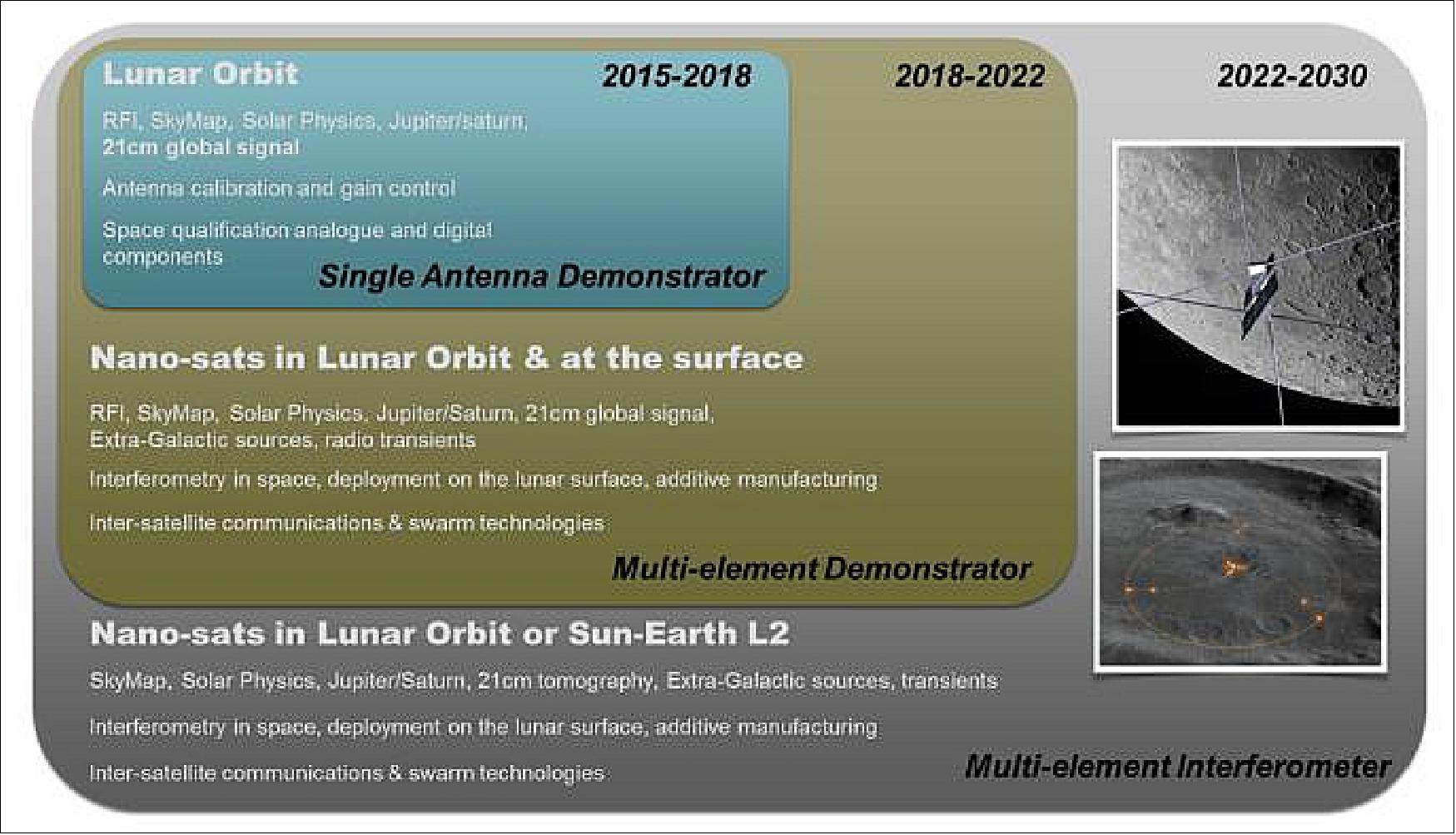
• September 4, 2018: One of the two microsatellites, launched along with a required communications relay satellite in May, has quietly been allowing radio operators to download images from the spacecraft taken along its elliptical lunar orbit. 89)
- Longjiang-2, aka DSLWP-B, was developed by students at the Harbin Institute of Technology (HIT) in the Heilongjiang Province, northeast China. Despite having a mass of just 47 kg, the tiny satellite managed to use its own propulsion to slow down and enter lunar orbit while the relay satellite continued past the Moon to its special destination.
- During its time in orbit Longjiang-2 has used a student-developed camera to take images of the Moon, Mars, the Sun and other objects. UHF tests have seen data transmitted by Longjiang-2 and received and decoded by radio operators on Earth.
- Unfortunately its partner microsatellite, Longjaing-1/DSLWP-A, was lost shortly after trans-lunar injection, and likely remains in distant Earth orbit after a lunar flyby.
• August 16, 2018: Longjiang-2 (aka DSLWP-B), one of two microsatellites launched along with the Queqiao relay satellite in May, is still functioning in an elliptical orbit around the Moon, with amateur radio enthusiasts using the 47 kg spacecraft for experiments. 90)
- Longjiang-2 carries a camera developed by KACST of Saudi Arabia, accounting for the final of four internationally-provided payloads for Chang’e-4, which sent back these cool images of the Earth and Moon.
- Another onboard imager developed by students at the Harbin Institute of Technology (HIT) in northeast China has allowed radio operators to download images. Here is one such image, of Mare Nubium on the near side of the Moon.
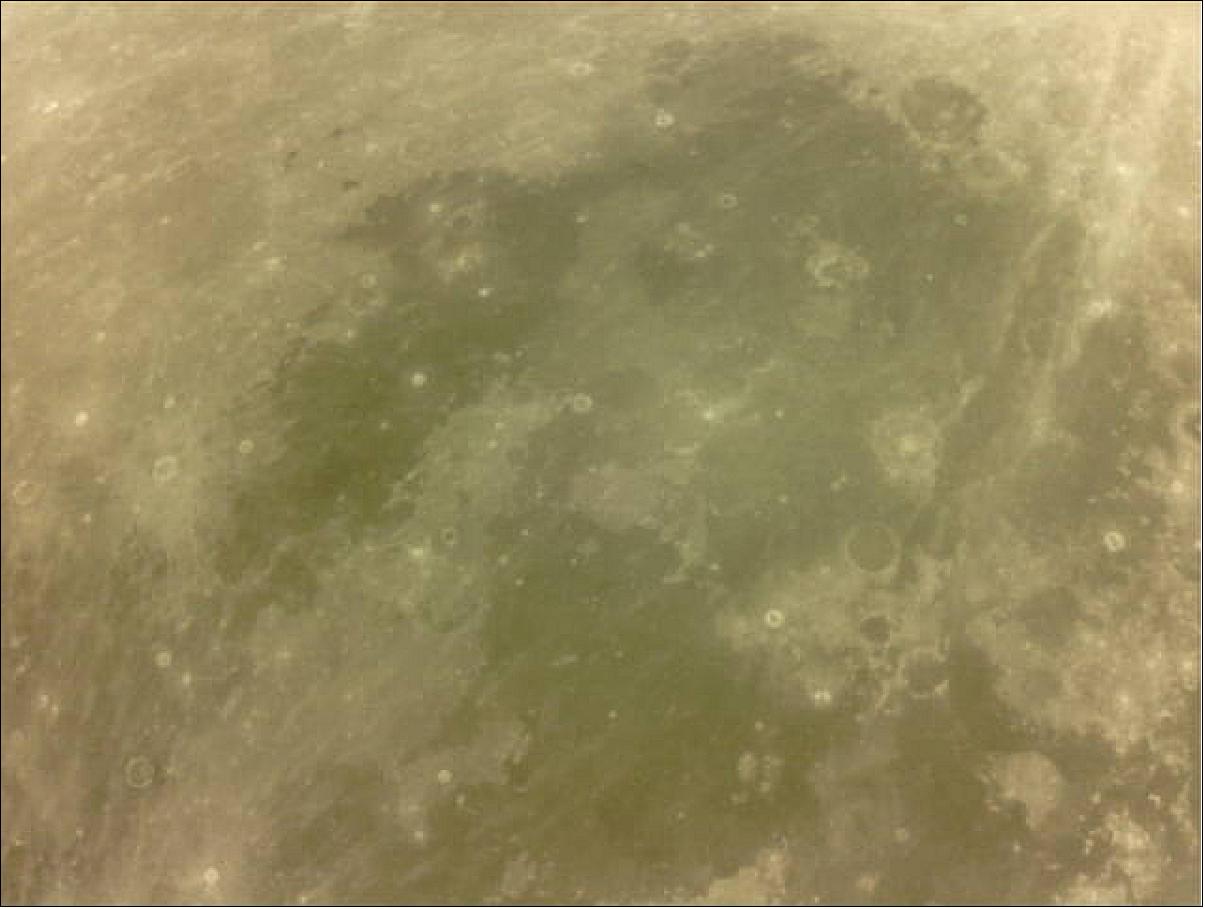
• June 18, 2018: Two microsatellites, Longjiang-1 and Longjiang-2, were sent into space on 20 May (21:28 UTC) together with the Chang'e-4 lunar probe's relay satellite from southwest China's Xichang Satellite Launch Center. 91)
- Longjiang-2 successfully reached its destination near the Moon on May 25, and entered a lunar orbit with a perilune at 350 km and an apolune at 13,700 km. However, Longjiang-1 suffered an anomaly and failed to enter lunar orbit, according to CNSA (China National Space Administration).
- With a mass of 47 kg, Longjiang-2 has become the world's first lunar orbiter developed by a university. The Longjiang-2 microsatellite carries an optical camera developed by KACST (King Abdulaziz City for Science and Technology) of Riyadh,Saudi Arabia, as well as a low-frequency radio detector developed by the National Space Science Center of CAS (Chinese Academy of Sciences).
- The camera, which began to work on 28 May , has conducted observations of the Moon and acquired a series of clear lunar images and data, according to Xinhua News.

• June 15, 2018: China has provided an update on its Chang'e-4 relay satellite, launched in May in preparation for a later landing on the far side of the Moon, while also revealing the status of the Longjiang microsatellites intended for lunar orbit. A series of stunning images from a Saudi Arabia-developed camera aboard one of the lunar microsatellites, namely Longjiang-2, were also released. 92)


• June 14, 2018: The relay satellite for the Chinese Chang'e-4 lunar probe, named Queqiao and launched on 20 May 2018, entered the Halo orbit around the second Lagrangian (L2) point of the Earth-Moon system (EML-2), about 65,000 km. from the Moon, at 11:06 a.m. on Thursday, June 14, after a journey of more than 20 days. 93)
- "The satellite is the world's first communication satellite operating in that orbit, and will lay the foundation for the Chang'e-4, which is expected to become the world's first soft-landing, roving probe on the far side of the Moon," said Hongtai Zhang, President of the China Academy of Space Technology (CAST). 94)
- The concept of the Halo orbit around the EML-2 (Earth-Moon L2 ) point was first put forward by international space experts in 1950s. While in orbit, the relay satellite can see both the Earth and the far side of the Moon. The satellite can stay in the Halo orbit for a long time due to its relatively low use of fuel, since the Earth's and Moon's gravity balances the orbital motion of the satellite.
- "From Earth, the orbit looks like a halo of the Moon, which is where it got its name," said Lihua Zhang, project manager of the relay satellite. He said the Halo orbit was a three-dimensional ,irregular curve. It is extremely difficult and complex to maintain the satellite in orbit. "If there is a tiny disturbance, such as gravitational disturbance from other planets or the Sun, the satellite will leave orbit. The orbit period is about 14 days. According to our current plan, we will conduct orbit maintenance every seven days. It's a new type of orbit, we don't have any experience. We ran a number of simulations to make sure the design is feasible and reliable," Zhang added.
- In order to establish a communication link between Earth and the planned Chang'e-4 lunar probe, space engineers must keep the satellite stable and control its altitude, angle and speed with high precision. Next, the team will test the communication function of the relay satellite.
- With a mass of 400 kg, and with a design life of three years, the satellite carries several antennas. One, shaped like an umbrella with a diameter of 4.2 meters, is the largest communication antenna ever used in deep space exploration, this according to Lan Chen, deputy chief engineer of the Xi'an Branch of CAST.
- Tidal forces of the Earth have slowed the Moon's rotation to the point where the same side always faces the Earth, a phenomenon called tidal locking. The other face, most of which is never visible from Earth, is the far side or dark side of the Moon, not because it's dark, but because most of it remains unknown. With its special environment and complex geological history, the far side is a hot spot for scientific and space exploration. The Aitken Basin of the lunar south pole region on the far side has been chosen as the landing site for Chang'e-4. The region is believed to have great research potential.
• June 1, 2018: Queqiao made its lunar swing-by on May 25, performing a braking burn at 13:32 UTC to send the communications satellite towards EML-2, some 60-80,000 km beyond the Moon. 95)
Relay Satellite Sensor Complement
On board is a Dutch radio antenna, the NCLE (Netherlands Chinese Low-Frequency Explorer). The radio antenna is the first Dutch-made scientific instrument to be sent on a Chinese space mission, and it will open up a new chapter in radio astronomy. 96) 97) 98)
The NCLE instrument was developed and built by engineers from ASTRON, the Netherlands Institute for Radio Astronomy in Dwingeloo, the Radboud Radio Lab of Radboud University in Nijmegen, and the Delft-based company ISIS — in collaboration with a team from the Chinese NAOC (National Astronomical Observatory of the Chinese Academy of Sciences). With the instrument, astronomers want to measure radio waves originating from the period directly after the Big Bang, when the first stars and galaxies were formed.
Why is it so important for the measuring instruments to be placed behind the Moon? Professor of Astrophysics from Radboud University and ASTRON Heino Falcke: "Radio astronomers study the universe using radio waves, light coming from stars and planets, for example, which are not visible with the naked eye. We can receive almost all celestial radio wave frequencies here on Earth. We cannot detect radio waves below 30 MHz, however, as these are blocked by our atmosphere. It is these frequencies in particular that contain information about the early universe, which is why we want to measure them."
Special about the radio antenna is that it will receive low frequency radio waves with a large frequency range. The instrument passed an important risk assessment review by the Chinese space agency at the end of April.
"In the past this was not possible and therefore a receiver with a narrow frequency band was used, in order to avoid electromagnetic interference of the satellite itself," explains project leader Albert-Jan Boonstra of ASTRON. "We have now succeeded in avoiding the electromagnetic interference and making a broadband receiver. That is, of course, good news for subsequent missions and can, for example, be used for future nano-satellites."
In 2016, the NSO (Netherlands Space Office) and its Chinese counterpart CNSA signed an agreement to cooperate in this project, which was an elaboration of the Memorandum of Understanding the two space agencies signed the year before during a trade mission in presence of the Chinese President Xi Jinping and the Dutch King Willem Alexander.
A digital controller unit, designed and supplied by the Somerset West-based SAC (Space Advisory Company), is part of the NCLE (Netherlands-China Low-Frequency Explorer) as a science payload on the Chang’e-4 relay satellite which lifted atop a Long March 4C Rocket from Xichang Satellite Launch Center at 21:28 UTC on Sunday, 21 May 2018. 99)
While the Chang’e-4 satellite’s main mission is to relay messages between Earth and the Moon, the NCLE instrument will ride along and conduct experiments into deeper space.
Duncan Stanton, CEO of SAC said that they are ecstatic to be part of such an unique mission and especially proud of their engineering team who proved themselves to be world-class by meeting the ambitious timeline and performance requirements of the project. They may just have embarked on proudly flying the South African flag the furthest ever.
Stanton continued that the controller unit supplied by them forms a critical part of the digital receiver system for the NCLE instrument. The instrument was built by the Radboud Radio Lab from the Radboud University, the Netherlands Institute for Radio Astronomy (ASTRON), and ISIS (Innovative Solutions In Space) in Delft. The instrument has a primary science objective to detect low frequency 21 cm hydrogen line emissions from the ‘dark ages’ period of the universe before stars began to shine.
SAC is a member of the Somerset West-based SCS Aerospace Group (SCSAG), Africa’s largest privately-owned group of satellite design and manufacturing companies with more than 25 years of experience in this domain.
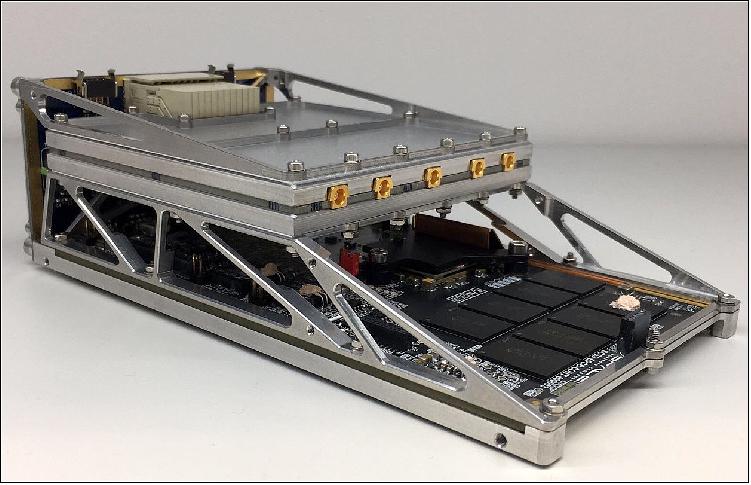
NCLE (Netherlands-China Low-Frequency Explorer)
NCLE (Netherlands-China Low-Frequency Explorer) is a low-frequency payload which is part of the Chinese Chang’e-4 mission. The NCLE instrument consists of three 5-meter long monopole antennas mounted on the Queqiao satellite to measure in the 80 kHz -80 MHz radio frequency range. The instrument is designed to address a multitude of high-profile science cases, but predominantly NCLE will open up the low-frequency regime for radio astronomy and will prepare for the ground-breaking observations of the 21-cm line emission from the Dark Ages and the Cosmic Dawn, considered to be the holy grail of cosmology. 100)
The main goal of NCLE is to determine the low frequency radio environment at the Earth Moon L2 point. It serves as a stepping stone mission towards low frequency observations, aimed at registering the hydrogen line at different frequencies and thus creating a ‘moving picture’ of the evolution of the early universe.
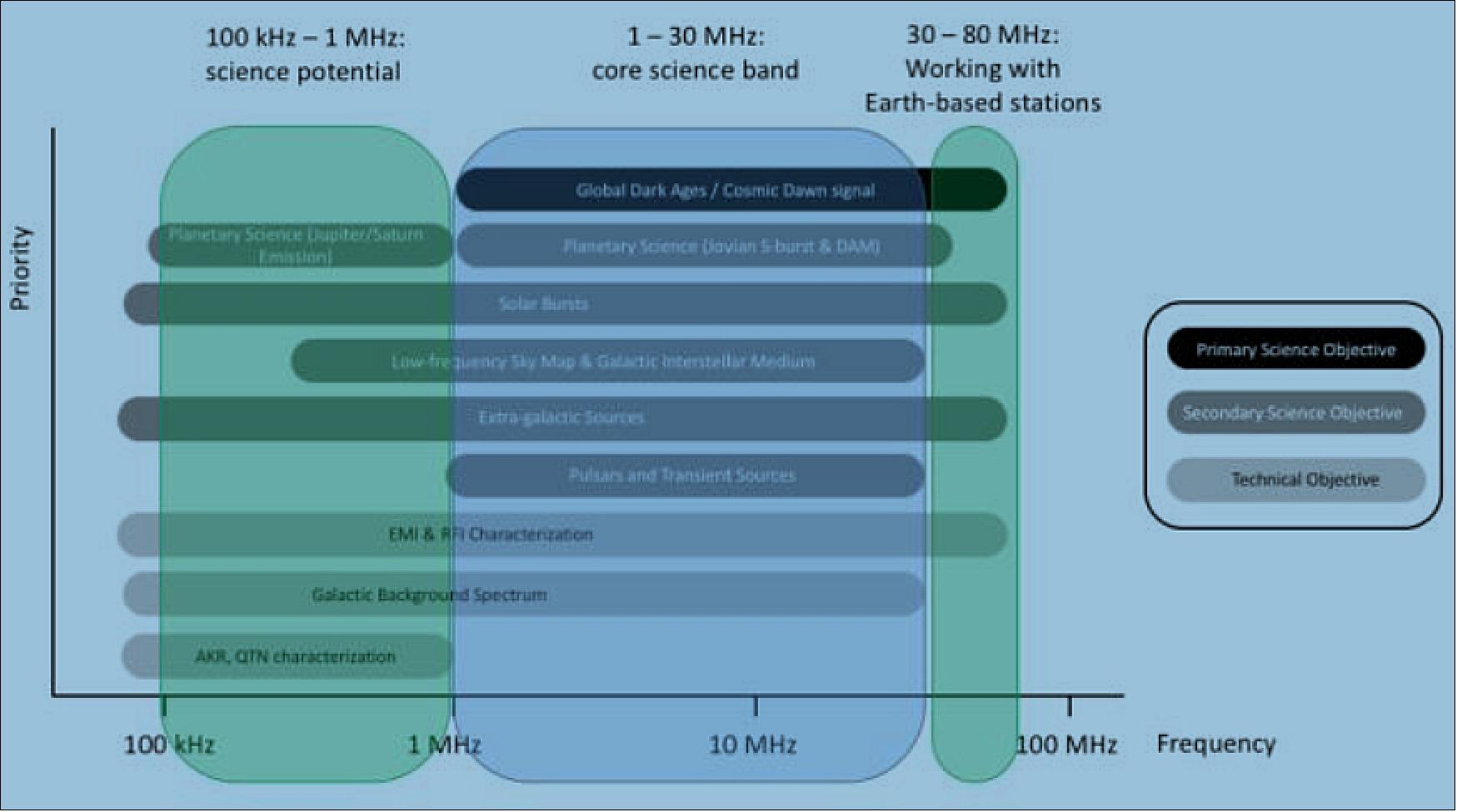
Dark Ages and Cosmic Dawn: The signature emission from neutral hydrogen at 21 cm shows a spectrum over different redshifts that indicates its cosmic abundance as a function of time. Around the epoch of reionization in the younger universe, which was when neutral hydrogen was re-ionized by radiation from early stars, this signature should show a measurable dependence on redshift as a result in the range from 1 – 80 MHz. The detection or the constraining of this signature will have a strong impact on cosmology and science of the early universe, as it provides information on an epoch in the history of our universe from which we cannot receive much information through other means.
Solar Bursts: The Sun, our closest star, affects fundamentally the Earth's ecosystem and daily life thereby affecting the quality of life on Earth and the performance of technological systems (e.g. power grid). Superimposed on the powerful thermal emissions of the quiet Sun are the intense radio bursts associated with solar flares and coronal mass ejections (CME), clouds of ionized plasma are ejected into interplanetary space. Despite their great importance to Space Weather services, the physical mechanisms governing such events are poorly understood, with the consequence that neither accurate models nor reliable prediction tools exist.
The Sun often exhibits magnetic activity outside of its photosphere, in the form of rapid reordering of its smaller-scale magnetic field that may be accompanied by mass ejections. These field reconfigurations generate strong radio emission through synchrotron radiation from charged particles in these magnetized regions. The strength of this emission makes this a source that can be investigated by NCLE relatively easily, establishing statistics and correlations over a long observing period.
Two main types of radio bursts are observed from the Sun particularly in its active state: Type II bursts drive energizing shocks through the solar corona and interplanetary medium (~1000-2000 km/s), and Type III bursts result from mildly relativistic (~0.1 - 0.3 c) electron beams propagating through the corona and interplanetary space that excite plasma waves at the local plasma frequency but do not create a CME. Type II bursts and their ensuing CMEs can be followed by NCLE much further out than the few solar radii possible from the ground because of the ionosphere, see Figure 58.
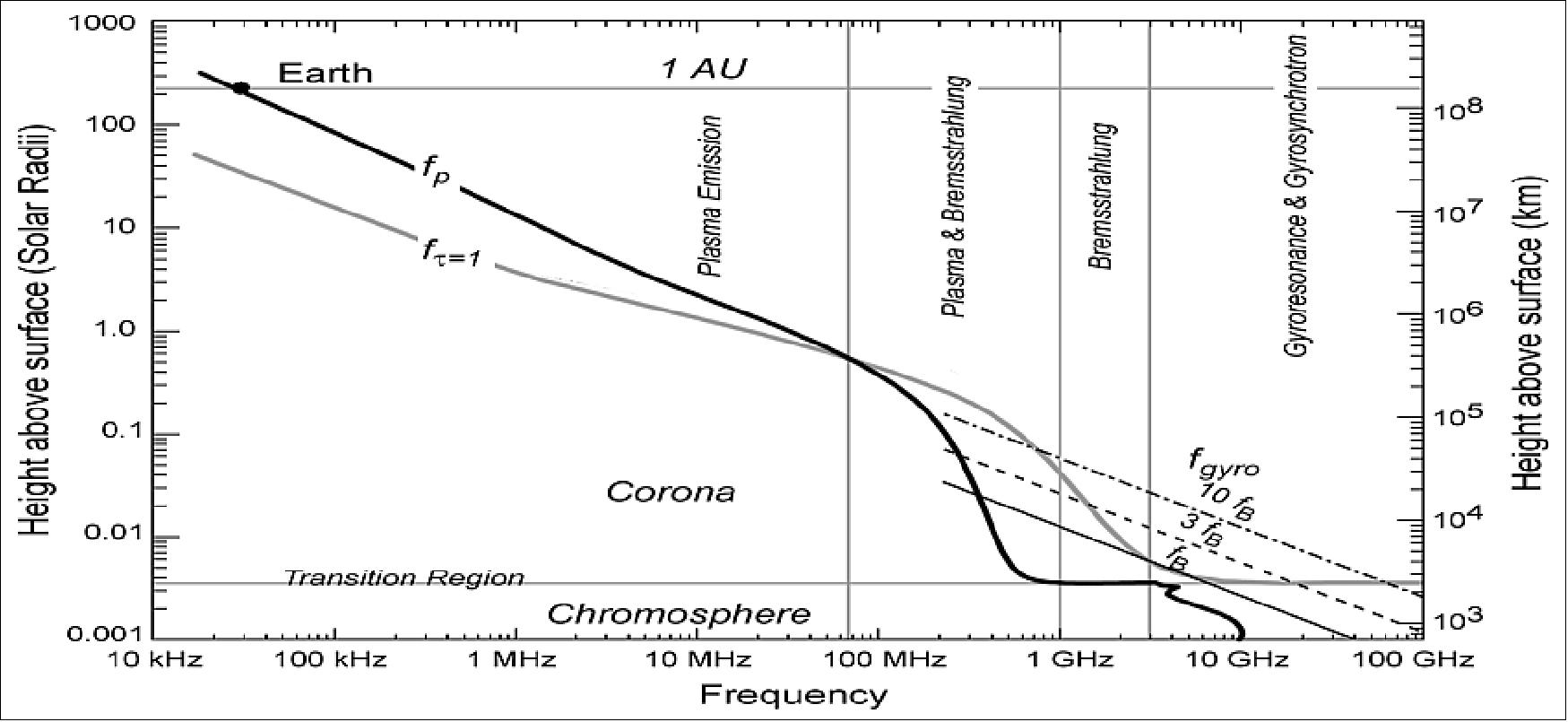
Lightning (Earth): Rapid discharge of built-up electrical charge between different clouds in Earth’s troposphere or between clouds and the ground generates bursts of wide-band radio emission. As such, lightning represents one component of Earth-based RFI with a unique signature that is critical for us to understand.
Auroral Kilometric Radiation / AKR (Earth): Charged particles in the Solar wind are deflected by Earth’s magnetic field. Under certain circumstances, these particles can become temporarily trapped and emit cyclotron radiation at very low frequencies. As this phenomenon arises from the interaction of the Solar wind with the Earth’s magnetic field, measuring AKR allows us to learn about both of these systems.
Galactic Background: Interaction of cosmic rays (energetic charged particles) with the Galactic magnetic field generates a wide-spectrum Synchrotron background, which is especially prominent in the Galactic plane. Measurement of this spectral component in the form of a multi-frequency sky map helps us to understand the geometry of the Galactic magnetic field and the cosmic ray population in our Galaxy.
Quasi-Thermal Noise (QTN): Interaction of the instrument antennas with local plasma causes small voltage variations in them, which manifest as an extra noise component in the measurements. The measurement of QTN outside of the strong influence of Earth’s magnetic field enables us to sample local solar wind properties (possibly allowing us to correlate these with solar outburst data), as well as to understand its influence on our other measurements.
Solar System Planetary Emissions: Analogous to AKR from Earth, the extended magnetospheres of Jupiter and Saturn can trap charged particles from the Solar wind, which proceed to generate low-frequency cyclotron radiation. As with Earth, measuring this AKR helps us to understand the magnetic fields of the most massive planets in the Solar system, as well as the Solar wind itself.
Bright Radio Transients From Outside The Solar System: There are many possible processes that might generate low-frequency radio emission with a rapidly varying temporal signature. One example is pulsar emission, which tends to have a strong low-frequency component. Fast Radio Bursts, from hitherto unknown origin, are another example. An issue with short pulses at low frequencies is that they get dispersed quite strongly by interstellar propagation. An ability to measure these transients from space at low frequencies offers the opportunity to correlate these detections with Earth-based measurements at higher frequencies. NCLE’s remoteness from Earth and regular occultation by the Moon, combined with its multidirectional sensitivity, should offer us ample opportunities to look for these events.
Engineering Challenges
Leaving low Earth Orbit: To support the science cases, there is no choice but to leave the well know low earth orbits and go further out. The NCLE instrument managed to find an agreement with the Chinese CE-4R satellite; a satellite travelling to the Moon Earth L2 point to act as a relay satellite for a rover which will land on the far side of the Moon.
Because NLCE is part of a larger satellite some of the obvious challenges have already been met. The host spacecraft will provide mechanical, power, communication and thermal interfaces. However, at the start of the project the host was already designed and built meaning the NCLE instrument needed to conform to the design as little changes could be made.
This proved to be just as challenging as designing without a spacecraft present. The information to and from the Chinese included large uncertainties as the final orbit, orientation of the instrument or configuration of the spacecraft were largely unknown when the NCLE design started. This directly translates to uncertainties in the design.
Schedule: At the start of the project only a few things were clear; the system must be below 10 kg, below 50 Watts, will orbit the Earth Moon L2 point and the launch will be in May 2018.
As the project started in earnest May 2016, this left only 2 years to develop build and test the instrument. The whole system architecture tried to follow the CubeSat approach as much as possible; special space rated components could not be procured on time, build and test, test and build and keeping the system as modular as possible to allow for early testing of the different subsystems. This allowed for all parts to be ready in March 2018, less than 2 years after the project started.
Electromagnetic Interference: The other big challenge for the instrument is to reduce its electromagnetic emissions as much as possible. This was needed to become sky-noise limited and detect the weak signals over the noise the instrument itself is making.
CubeSats generally are not designed to be as clean as possible from an EMC point of view. Rather, little care is given to this part of the design in typical CubeSat missions. To make matters worse, the interfaces coming from CE-4R also was not designed to be as clean as possible.
To combat these issues almost the entire power system had to be redesigned from the ground up. Care was taken to implement a star grounding scheme such that all power paths are well defined and controlled. Isolation between the incoming power, analog power and digital domain needed to be carefully created as well.
Using previous CubeSat designs as a blueprint, the power system was designed to be as modular as possible to facility all these requirements. In the end, no less than 4 boards have been designed, tested and integrated together, a far cry from the usual one a typical CubeSat needs!
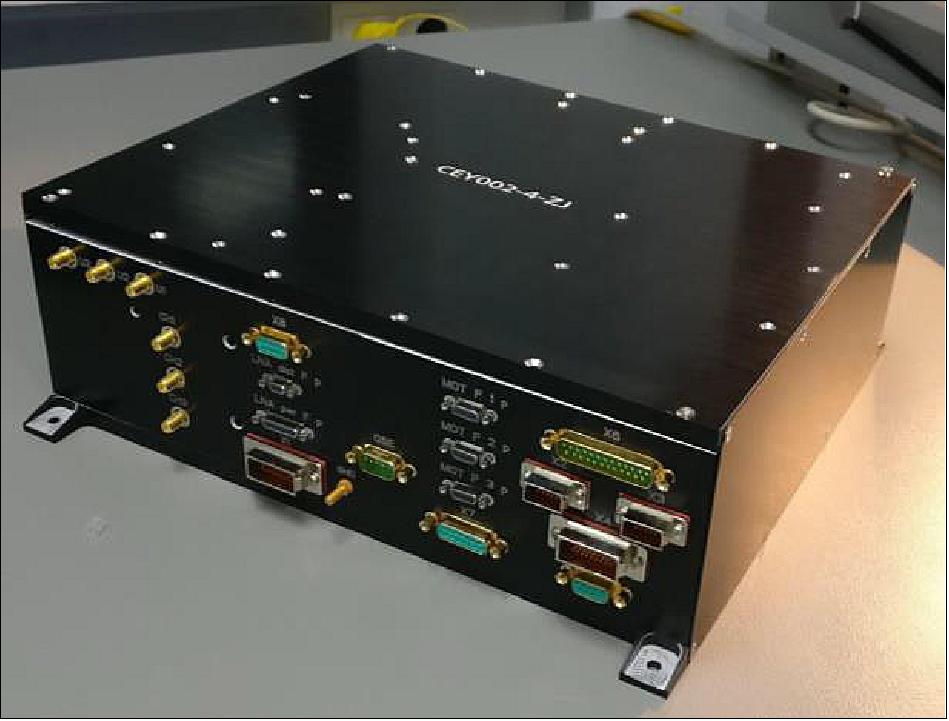
Lastly, the mechanical design had to contain special measures to make sure internal signals wouldn’t radiate to one another. This resulted in one dedicated box for the LNA (Low Noise Amplifier) system and compartments inside of the EBOX for the final analog stages.
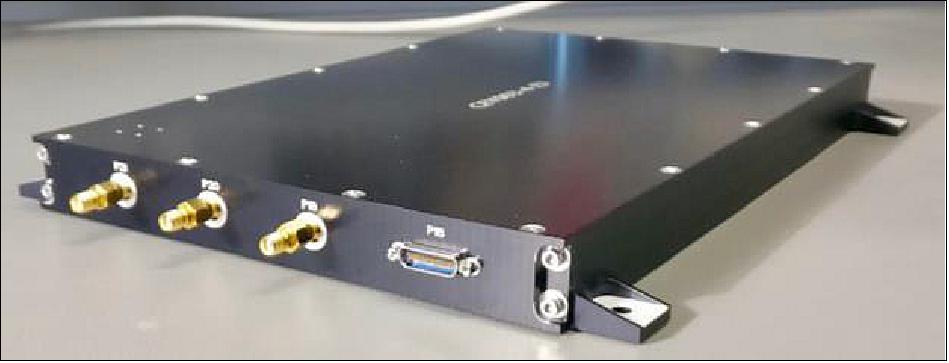
NCLE System Design
The NCLE system functionally can be broken down into 4 main elements:
• Analog receiver system (analog electronics)
• Digital received system (FPGA based digital receiver, mass memory storage)
• On-board Data Handling and interface electronics (On-Board Data Handling, data interfaces, power regulation)
• Deployable antenna system (antenna mechanism and motor drive electronics)
An overview of the system architecture is shown in Figure 61. The analog parts are indicated in yellow, the digital system in blue, the antenna in red and the interface electronics in green.

Analog receiver system: The analog receiver system consists of three antenna elements that pick up the external RF signals and are connected through RF connections to the Low-Noise Amplifier and Analog Input Stage electronics. Each antenna is connected to its own channel of analog electronics, where the RF signals are conditioned (amplified, filtered, etc.) before being sampled by the digital receiver system.
In addition to these three channels, a calibrator is included that produces a calibration pulse train that is fed into the three LNA input channels providing a signal reference.
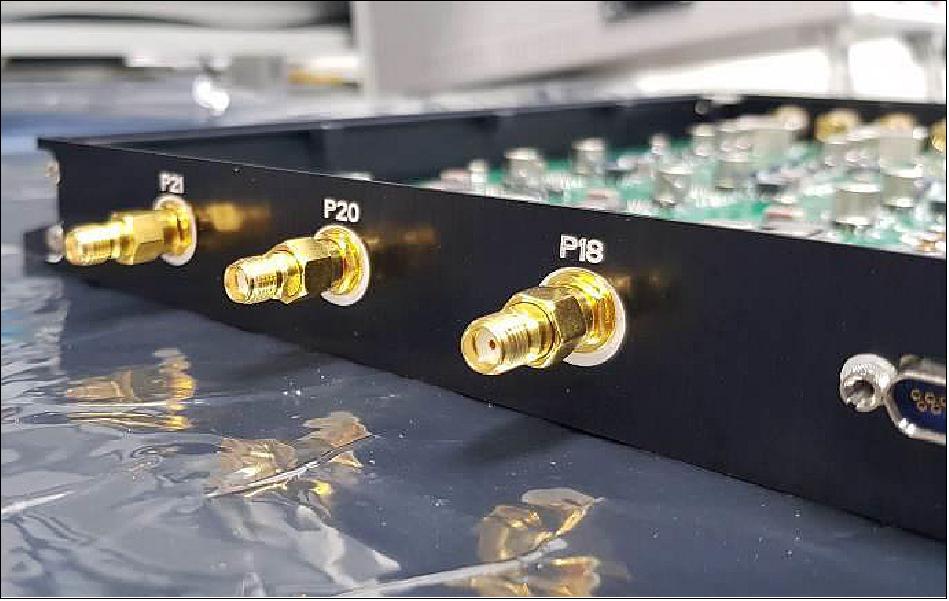
Digital receiver system: The digital receiver system consists of Analog to Digital Converters where the analog signals are sampled, a clock module for time synchronization, an FPGA based programmable logic where signal processing is performed and mass memory to buffer the data. This includes for example FFTs, running data reduction algorithms and storing the data. It is based on CubeSat hardware; an SCS space image processor board has been repurposed to perform all these tasks.
On-board data handling and interface electronics: The on-board data handling and interface electronics consists of a number of elements.
The power supply unit provides regulation of the incoming power, galvanic isolation and signal filtering, and distribution of the different power lines for the analog and digital electronics. The board is a heavily version of an ISIS EPS system, with many additions to facilitate the special needs of this mission.
An ISIS On-Board Computer is included to provide data handling and to manage the data interfaces with the Chang’e-4R spacecraft. The control bus interface is a dual redundant CAN bus, while the payload data transfer is performed over a dual redundant LVDS bus.

Deployable antenna system: To provide sufficient gain at low frequencies and the possibility to provide directionality information, three orthogonal 5-m long antennas were required. As the antenna system also had to meet strict stiffness, mass and volume constraints, a new design had to be made.
The antenna element was designed to be stiff enough to maintain its shape under all possible forces induced by the spacecraft, such as propulsion firings or attitude maneuvers, while meeting the mass and volume constraints. A C-shaped carbon fiber element was developed that could be rolled up on a drum before deployment.
The antenna deployment mechanism consists of a motor and gearhead with associated drive electronics, worm gear, slipring and a drum with the rolled-up antenna element. Deployment and end-stop switches provide information about the status of deployment.


System Performance
Prior to delivery several tests have been conducted with the NCLE instrument. Most of these where not conducted with the antennas deployed. If they were deployed, the environment was not EMC proof. The final tests was conducted while integrated on the CE-4R spacecraft, showing the environment most representative of flight conditions so far.
The results of these tests look promising: in a noisy lab environment the instrument picks up a significant amount of noise, see Figure 66. Integrated on the spacecraft, with antenna’s stowed the picture looks much better, with a noise floor which is much reduced, see Figure 67. The noise floor is found to be around -130 dBm, with the spikes being interference generated by the platform or environment.


References
1) David R. Williams, ”Future Chinese Lunar Missions — Chang'e 4 - Farside Lander,” NASA, 3 Oct. 2017, URL: https://nssdc.gsfc.nasa.gov/planetary/lunar/cnsa_moon_future.html
2) Pei Jian Ye, Ze Zhou Sun, He Zhang, Fei Li, ”An overview of the mission and technical characteristics of Change’4 Lunar Probe,” Science China Press and Springer Verlag, Berlin Heidelberg, May 2017, Vol.60 No.5, pp: 658–667, doi: 10.1007/s11431-016-9034-6, URL. http://engine.scichina.com/publisher/scp/journal/SCTS/60/5/10.1007/s11431-016-9034-6?slug=fulltext
3) Na Chen, ”China to Send Chang'e-4 to South Pole of Moon's Far-side,” CAS (Chinese Academy of Sciences), 15 June 2016, URL: http://english.cas.cn/newsroom/news/201606/t20160615_164411.shtml
4) ”China Prepares for Breakthrough Chang'e 4 Moon Landing in 2018,” Moon Daily, 02 January 2018, URL: http://www.moondaily.com/reports/
China_Prepares_for_Breakthrough_Change_4_Moon_Landing_in_2018_999.html
5) Matt Williams, ”Upcoming Chinese Lander Will Carry Insects and Plants to the Surface of the Moon,” Universe Today, 4 Jan. 2018, URL: https://www.universetoday.com/
138197/upcoming-chinese-lander-will-carry-insects-plants-surface-moon/
6) David A. Kring, Daniel D. Durda, ”A Global Lunar Landing Site Study to Provide the Scientific Context for Exploration of the Moon,” LPI (Lunar Planetary Institute) Contribution No. 1694, 2012, URL: https://www.lpi.usra.edu/exploration/CLSE-landing-site-study/
7) Sebastian Jester, Heino Falcke, ”Science with a lunar low-frequency array: from the dark ages of the Universe to nearby exoplanets,” Cosmology and Nongalactic Astrophysics, arXiv:0902.0493 [astro-ph.CO], Feb. 2009, URL: https://arxiv.org/pdf/0902.0493.pdf
8) J. K. Alexander, M. L. Kaiser, C. Novaco, F. R.Grena, R. R. Weber, ”Scientific instrumentation of the Radio-Astronomy-Explorer-2 satellite,” NASA, Feb. 1975, URL: https://ntrs.nasa.gov/archive/nasa/casi.ntrs.nasa.gov/19750010212.pdf
9) PeiJian Ye, ZeZhou Sun, He Zhang,Fei Li, ”An overview of the mission and technical characteristics of Change’4 Lunar Probe,” Science China, Technological Sciences, Vol. 60, Issue 5, pp: 658-667, May 2017, URL: http://engine.scichina.com/publisher/scp/journal/
SCTS/60/5/10.1007/s11431-016-9034-6?slug=full%20text
10) ”China plans missions to moon's south pole,” Moon Daily, 4 January 2022, URL: https://www.moondaily.com/reports/China_plans_missions_to_moons_south_pole_999.html
11) ”Lunar Probe Unveiled As It Readies for Expedition,” CAS (Chinese Academy of Sciences), 16 August 2018, URL: [web source no longer available]
12) Andrew Jones, ”China launches Chang’e-4 spacecraft for pioneering lunar far side landing mission,” 7 December 2018, URL: https://spacenews.com/
china-launches-change-4-spacecraft-for-pioneering-lunar-far-side-landing-mission/
13) Andrew Jones, ”Pioneering Chang’e-4 lunar far side landing mission to launch in December,” Space News, 15 August 2018, URL: https://spacenews.com/
pioneering-change-4-lunar-far-side-landing-mission-to-launch-in-december/
14) Jun Huang, Zhiyong Xiao, Jessica Flahaut, Mélissa Martinot, Xiao Xiao, ”Geological characteristics of Chang'e-4 landing site,” 49th Lunar and Planetary Science Conference 2018 (LPI Contrib. No. 1438), Lunar and Planetary Science Conference, The Woodlands, Texas, March 19-23, 2018, URL: https://www.hou.usra.edu/meetings/lpsc2018/pdf/1438.pdf
15) Jia Wang, Man Peng, Wenhui Wan, Zhanyong Zhou, Zhifei Rong, Baofeng Wang, Weihua Ma, Xinyuan Lu, Ximing He, Yi You, ”Positioning Method of Chang'E-4 lander based on Multi-source Images,” Proceedings of the 69th IAC (International Astronautical Congress) Bremen, Germany, 1-5 October 2018, paper: IAC-18.A3.IP.21, URL: https://iafastro.directory/iac/proceedings/
IAC-18/IAC-18/A3/IP/manuscripts/IAC-18,A3,IP,21,x42199.pdf
16) ”China's lunar rover spots cube-like object on Moon, sparking curiosity,” Moon Daily, 08 December 2021, URL: https://www.moondaily.com/reports/
Chinas_lunar_rover_spots_cube_like_object_on_Moon_sparking_curiosity_999.html
17) ”China's Chang'e 4 probe resumes work for 29th lunar day,” Moon Daily, 08 April 2021, URL: https://www.moondaily.com/reports/Chinas_Change_4_probe_resumes_work_for_29th_lunar_day_999.html
18) ”Chang'e 4 probe resumes work for 26th lunar day,” Moon Daily, 11 January 2021, URL: https://www.moondaily.com/reports/
Change_4_probe_resumes_work_for_26th_lunar_day_999.html
19) ”China's lunar rover travels about 600 meters on moon's far side,” Moon Daily, 25 December 2020, URL: https://www.moondaily.com/reports/
Chinas_lunar_rover_travels_about_600_meters_on_moons_far_side_999.html
20) ”Yutu 2 rover still operating on far side of moon,” Moon Daily, 25 November 2020, URL: https://www.moondaily.com/reports/
Yutu_2_rover_still_operating_on_far_side_of_moon_999.html
21) ”China's lunar rover travels 565.9 meters on moon's far side,” Moon Daily, 27 October 2020, URL: https://www.moondaily.com/reports/
Chinas_lunar_rover_travels_565_9_meters_on_moons_far_side_999.html
22) ”China's Chang'e-4 probe resumes work for 23rd lunar day,” Moon Daily, 13 October 2020, URL: https://www.moondaily.com/reports/
Chinas_Change_4_probe_resumes_work_for_23rd_lunar_day_999.html
23) ”How intense and dangerous is cosmic radiation on the Moon?,” DLR, 25 September 2020, URL: https://www.dlr.de/content/en/articles/
news/2020/03/20200925_how-intense-and-dangerous-is-cosmic-radiation-on-the-moon.html
24) Shenyi Zhang, Robert F. Wimmer-Schweingruber, Jia Yu, Chi Wang, Qiang Fu, Yongliao Zou, Yueqiang Sun, Chunqin Wang, Donghui Hou, Stephan I. Böttcher, Sönke Burmeister, Lars Seimetz, Björn Schuster, Violetta Knierim, Guohong Shen, Bin Yuan, Henning Lohf, Jingnan Guo, Zigong Xu, Johan L. Freiherr von Forstner, Shrinivasrao R. Kulkarni, Haitao Xu, Changbin Xue, Jun Li, Zhe Zhang, He Zhang, Thomas Berger, Daniel Matthiä, Christine E. Hellweg, Xufeng Hou, Jinbin Cao, Zhen Chang, Binquan Zhang, Yuesong Chen, Hao Geng and Zida Quan, ”First measurements of the radiation dose on the lunar surface,” Science Advances, Vol. 6, No 39, eaaz1334, https://doi.org/10.1126/sciadv.aaz1334, September 2020
25) ”China's Chang'e-4 probe resumes work for 22nd lunar day,” Moon Daily, 14 September 2020, URL: https://www.moondaily.com/reports/
Chinas_Change_4_probe_resumes_work_for_22nd_lunar_day_999.html
26) ”China's Chang'e-4 probe reveals landing site impact history on moon's far side,” Moon Daily, 10 September 2020, URL: https://www.moondaily.com/reports/
Chinas_Change_4_probe_reveals_landing_site_impact_history_on_moons_far_side_999.html
27) Jinhai Zhang, Bin Zhou, Yangting Lin, Meng-Hua Zhu, Hanjie Song, Zehua Dong, Yunze Gao, Kaichang Di, Wei Yang, Hongyu Lin, Jianfeng Yang, Enhai Liu, Lei Wang, Yi Lin, Chao Li, Zongyu Yue, Zhenxing Yao & Ziyuan Ouyang, ”Lunar regolith and substructure at Chang’E-4 landing site in South Pole–Aitken basin,” Nature Astronomy Letter, Vol. 130, Published: 07 September 2020, https://doi.org/10.1038/s41550-020-1197-x
28) https://www.nature.com/articles/s41550-020-1197-x/figures/4
29) ”China's Chang'e-4 probe survives 600 Earth days on Moon's far side,” Moon Daily, 1 September 2020, URL: https://www.moondaily.com/reports/
Chinas_Change_4_probe_survives_600_Earth_days_on_Moons_far_side_999.html
30) ”China's Chang'e-4 probe resumes work for 21st lunar day,” Moon Daily, 16 August 2020, URL: https://www.moondaily.com/reports/Chinas_Change_4_probe_resumes_work_for_21st_lunar_day_999.html
31) ”Study reveals composition of 'gel-like' substance discovered by Chang'e-4 rover on Moon's far side,” Phys.org news, 21 July 2020, URL: https://phys.org/news/
2020-07-reveals-composition-gel-like-substance-change-.html
32) Sheng Gou, Zongyu Yue, Kaichang Di, Jia Wang, Wenhui Wan, Zhaoqin Liu, Bin Liu, Man Peng, Yexin Wang,Zhiping Hee, Rui Xu, ”Impact melt breccia and surrounding regolith measured by Chang'e-4 rover,” Earth and Planetary Science Letters, Volume 544, 15 August 2020, 116378, Available online: 8 June 2020, https://doi.org/10.1016/j.epsl.2020.116378
33) ”Scientists identify 'gel-like' substance Chinese rover found on the moon,” Moon Daily, 09 July 2020, URL: https://www.moondaily.com/reports/
Scientists_identify_gel-like_substance_Chinese_rover_found_on_the_moon_999.html
34) Sheng Gou, Zongyu Yue, Kaichang Di, Jia Wang, Wenhui Wan, Zhaoqin Liu, Bin Liu, Man Peng, Yexin Wang, Zhiping He, Rui Xu, ” Impact melt breccia and surrounding regolith measured by Chang'e-4 rover,” Earth and Planetary Science Letters, Volume 544, 15 August 2020, 116378, Available online: 8 June 2020, https://doi.org/10.1016/j.epsl.2020.116378
35) ”China's lunar rover travels about 448 meters on moon's far side,” Moon Daily, 01 May 2020, URL: https://www.moondaily.com/reports/
Chinas_lunar_rover_travels_about_448_meters_on_moons_far_side_999.html
36) ”China's Chang'e-4 probe resumes work for 17th lunar day,” Moon Daily, 17 April 2020, URL: https://www.moondaily.com/reports/Chinas_Change_4_probe_resumes_work_for_17th_lunar_day_999.html
37) ”China's lunar rover travels over 424 meters on moon's far side,” Moon Daily, 2 April 2020, URL: https://www.moondaily.com/reports/
Chinas_lunar_rover_travels_over_424_meters_on_moons_far_side_999.html
38) Yuan Li, ”Digging into the Far Side of the Moon: Chang'E-4 Probes 40 Meters into Lunar Surface,” CAS Newsroom, 27 February 2020, URL: [web source no longer available]
39) Chunlai Li, Yan Su, Elena Pettinelli, Shuguo Xing, Chunyu Ding, Jianjun Liu, Xin Ren, Sebastian E. Lauro, Francesco Soldovieri, Xingguo Zeng, Xingye Gao, Wangli Chen, Shun Dai, Dawei Liu, Guangliang Zhang, Wei Zuo, Weibin Wen, Zhoubin Zhang, Xiaoxia Zhang, Hongbo Zhang, ”The Moon’s farside shallow subsurface structure unveiled by Chang’E-4 Lunar Penetrating Radar,” Science Advances, Volume 6, No 9, eaay6898, 26 February 2020, URL: https://advances.sciencemag.org/content/advances/6/9/eaay6898.full.pdf
40) ”China's Chang'e-4 probe resumes work for 15th lunar day,” Moon Daily, 19 February 2020, URL: https://www.moondaily.com/reports/
Chinas_Change_4_probe_resumes_work_for_15th_lunar_day_999.html
41) ”China's lunar rover travels 367 meters on moon's far side,” Moon Daily, 5 February 2020, URL: http://www.moondaily.com/reports/Chinas_lunar_rover_travels_367_meters_on_moons_far_side_999.html
42) Stephen Clark, ”China publishes Chang’e 4 data one year after first landing on far side of the moon,” Spaceflight Now, 6 January 2020, URL: https://spaceflightnow.com/2020/01/06/
china-publishes-change-4-data-one-year-after-first-landing-on-far-side-of-the-moon/
43) ”China's lunar rover travels over 345 meters on Moon's far side,” CGTN ((China Global Television Network), 5 December 2019, URL: https://news.cgtn.com/news/2019-12-05/
China-s-lunar-rover-travels-over-345-meters-on-Moon-s-far-side-Mav0LyZ6X6/index.html
44) ”China's Chang'e-4 probe resumes work for 12th lunar day,” Moon Daily, 25 November 2019, URL: http://www.moondaily.com/reports/Chinas_Change_4_probe_resumes_work_for_12th_lunar_day_999.html
45) ”Reconstructing the first successful lunar farside landing,” Moon Daily, 25 September 2019, URL: http://www.moondaily.com/reports/Reconstructing_the_first_successful_lunar_farside_landing_999.html
46) Jianjun Liu, Xin Ren, Wei Yan, Chunlai Li, He Zhang, Yang Jia, Xingguo Zeng, Wangli Chen, Xingye Gao, Dawei Liu, Xu Tan, Xiaoxia Zhang, Tao Ni, Hongbo Zhang, Wei Zuo, Yan Su & Weibin Wen, ”Descent trajectory reconstruction and landing site positioning of Chang’E-4 on the lunar farside,” Nature Communications, Vol. 10, Article No. 4229, Published: 24 September 2019, https://www.nature.com/articles/s41467-019-12278-3, URL: https://www.nature.com
/articles/s41467-019-12278-3.pdf
47) ”China's lunar rover discovers mysterious material on far side of Moon,” Moon Daily, 20 September 2019, URL: http://www.moondaily.com/reports/
Chinas_lunar_rover_discovers_mysterious_material_on_far_side_of_Moon_999.html
48) ”China's Chang'e-4 probe resumes work for ninth lunar day,” Moon Daily, 27 August 2019, URL: http://www.moondaily.com/reports/
Chinas_Change_4_probe_resumes_work_for_ninth_lunar_day_999.html
49) ”China's lunar rover travels 271 meters on moon's far side,” Moon Daily, 12 August 2019, URL: http://www.moondaily.com/reports/
Chinas_lunar_rover_travels_271_meters_on_moons_far_side_999.html
50) ”Chang’e-4 lander,” ESA microchip on Moon, Technology image of the week, 17 July 2019, URL: http://www.esa.int/spaceinimages/Images/2019/07/Chang_e-4_lander
51) ”China's Chang'e-4 probe resumes work for 7th lunar day,” Moon Daily, 28 June 2019, URL: http://www.moondaily.com/reports/Chinas_Change_4_probe_resumes_work_for_7th_lunar_day_999.html
52) ”China's Chang'E 4 mission discovers new 'secrets' from the far side of the moon,” Phys.org, 15 May 2019, URL: https://phys.org/news/2019-05-china-mission-secrets-side-moon.html
53) Chunlai Li, Dawei Liu, Bin Liu, Xin Ren, Jianjun Liu, Zhiping He, Wei Zuo, Xingguo Zeng, Rui Xu, Xu Tan, Xiaoxia Zhang, Wangli Chen, Rong Shu, Weibin Wen, Yan Su, Hongbo Zhang & Ziyuan Ouyang, ”Chang’E-4 initial spectroscopic identification of lunar far-side mantle-derived materials,” Nature Letter, Vol. 569, pp: 378-382, Published: 15 May 2019, https://doi.org/10.1038/s41586-019-1189-0
54) ”China's Chang'e-4 probe resumes work for fifth lunar day,” Moon Daily, 30 April 2019, URL: http://www.moondaily.com/reports/Chinas_Change_4_probe_resumes_work_for_fifth_lunar_day_999.html
55) ”China's Chang'e-4 probe switches to dormant mode,” Moon Daily, 15 April 2019, URL: http://www.moondaily.com/reports/Chinas_Change_4_probe_switches_to_dormant_mode_999.html
56) ”China's lunar rover studies stones on moon's far side,” Space Daily, 7 March 2019, URL: http://www.spacedaily.com/reports/Chinas_lunar_rover_studies_stones_on_moons_far_side_999.html
57) ”China's Chang'e-4 probe resumes to work after lunar night,” Moon Daily, 1 March 2019, URL: http://www.moondaily.com/reports/Chinas_Change_4_probe_resumes_to_work_after_lunar_night_999.html
58) ”IAU names landing site of Chinese Chang'e-4 probe on Far Side of Moon,” IAU (International Astronomical Union), iau1901 — Press Release, 15 February 2019, URL: https://www.iau.org/news/pressreleases/detail/iau1901/
59) ”IAU names landing site of Chinese Chang'e-4 probe on Far Side of Moon,” Moon Daily, 18 February 2019, URL: http://www.moondaily.com/reports/
IAU_names_landing_site_of_Chinese_Change_4_probe_on_Far_Side_of_Moon_999.html
60) ”Seed of moon's first sprout: Chinese scientists' endeavor,” China Daily, 3 February 2019, URL: http://www.chinadaily.com.cn/a/201902/03/WS5c565f14a3106c65c34e80e9.html
61) ”Chang'e-4 finds moon's far side colder than expected during night,” XinhuaNet, 31 January 2919, URL: http://www.xinhuanet.com/english/2019-01/31/c_137789823.htm
62) ”Moon sees first cotton-seed sprout,” Space Daily, 16 January 2019, URL: http://www.spacedaily.com/reports/Moon_sees_first_cotton_seed_sprout_999.html
63) ”Moon sees first cotton-seed sprout,” XinhuaNet, 16 January 2019, URL: http://www.xinhuanet.com/english/2019-01/15/c_137745432.htm
64) ”China declares Chang'e-4 mission complete success,” CNSA, 15 January 2019, URL: http://www.cnsa.gov.cn/english/n6465652/n6465653/c6805233/content.html
65) ”China's new lunar rover faces challenges on moon's far side,” Moon Daily, 15 January 2019, URL: http://www.moondaily.com/reports/Chinas_new_lunar_rover_faces_challenges_on_moons_far_side_999.html
66) ”Chang'e-4 probe takes panoramic photos on moon's far side,” Xinhuanet, 11 January 2019, URL: http://www.xinhuanet.com/english/2019-01/11/c_137735844.htm
67) ”Lunar probe takes first panoramic images of moon's far side,” China Daily, 11 January 2019, URL: http://www.chinadaily.com.cn/a/201901/11/WS5c37fc9fa3106c65c34e3e37.html
68) China's lunar rover drives smoothly on moon's far side,” China Daily, 5 January 2019, URL: [web source no longer available]
69) ”China names new moon rover 'Yutu-2',” China Daily, 4 January 2019, URL: http://www.chinadaily.com.cn/a/201901/04/WS5c2e31dca31068606745ec6d.html
70) ”Scientists expect breakthrough findings on moon's far side,” China Daily, 4 January 2019, URL: [web source no longer available]
71) ”Chang'e 4 makes world-first landing on moon's far side,” China Daily, 03 January 2019, URL: http://www.chinadaily.com.cn/a/201901/03/WS5c2d8d46a310d912140534a0.html
72) ”Chang'e-4 lands on largest crater in solar system,” Moon Daily, 4 January 2019, URL: http://www.moondaily.com/reports/Change_4_lands_on_largest_crater_in_solar_system_999.html
73) China's Chang'e-4 probe makes historic landing on moon's far side,” CNSA, 3 January 2019, URL: http://www.cnsa.gov.cn/english/n6465652/n6465653/c6805049/content.html
74) Andrew Jones, ”China's 'Yutu 2' Chang'e-4 rover is now rolling on the far side of the Moon,” gbtimes, 3 January 2019, URL: [web source no longer available]
75) ”Space History Written by China as Chang'e-4 Rover Lands on the Far Side of the Moon,” Satnews Daily, 4 January 2019, URL: http://www.satnews.com/story.php?number=1963239215
76) https://www.youtube.com/watch?v=ciXXj0Tj7zk
77) ”China's Chang'e-4 probe enters lunar orbit,” Xinhuanet, 12 December 2018, URL: http://www.xinhuanet.com/english/2018-12/12/c_137669026.htm
78) Robert F. Wimmer-Schweingruber, S. Zhang, C. E. Hellweg, Jia Yu, J. Guo, H. Lohf, T. Berger, S. I. Böttcher, S. Burmeister, A. Knappmann, V. Knierim, B. Schuster, L. Seimetz, H. Woyciechowski, G. Shen, B. Yuan, ”The Lunar Lander Neutron & Dosimetry (LND) Experiment on Chang’E4,” 48th LPSC ( Lunar and Planetary Science Conference), The Woodlands, Texas, USA, 20-24 March 2017, Poster, URL: https://www.hou.usra.edu/meetings/lpsc2017/eposter/1320.pdf
79) YingzhuoJia, YongliaoZou, JinsongPing,ChangbinXue, JunYan, YuanmingNing, ”The scientific objectives and payloads of Chang’E−4 mission,” Planetary and Space Science, Volume 162, 1 November 2018, Pages 207-215, URL of abstract: https://www.sciencedirect.com/science/article/pii/S0032063317300211
80) ”Swedish Institute of Space Physics goes back to the Moon,” IRF Press Release, URL: http://www2.irf.se/Topical/Press/?dbfile=Swedish%20
Institute%20of%20Space%20Physics%20goes%20back%20to%20the%20Moon&dbsec=P3
81) ”China's Chang'e-4 Relay Satellite Named "Queqiao",” CAS, 25 April 2018, URL: http://english.cas.cn/newsroom/china_research/201804/t20180425_191973.shtml
82) Luyuan Xu, ”Chang'e 4 relay satellite, Queqiao: A bridge between Earth and the mysterious lunar farside,” The Planetary Society, 19 May, 2018, URL: http://www.planetary.org
/blogs/guest-blogs/2018/0519-change-4-relay-satellite.html
83) ”China preparing to launch Chang’e-4 relay satellite May 21,” Space News, 14 May 2018, URL: http://spacenews.com/china-preparing-to-launch-change-4-relay-satellite-may-21/
84) Stephen Clark, ”Long March 4C - Chang’e 4 Relay,” May 16 2018, URL: https://spaceflightnow.com/launch-schedule/
85) ”Queqiao: The bridge between Earth and the far side of the moon,” Moon Daily, 11 June 2021, URL: https://www.moondaily.com/reports/
Queqiao_The_bridge_between_Earth_and_the_far_side_of_the_moon_999.html
86) Lihua Zhang, ”Development and Prospect of Chinese Lunar Relay Communication Satellite,” Space: Science & Technology, Volume 2021, Article ID 3471608, 14 pages, Published: 27 April, 2021, https://doi.org/10.34133/2021/3471608
87) ”Dutch antennas unfolded behind the moon,” Radboud University, 26 November 2019, URL: https://web.archive.org/web/20220124072144/https://www.ru.nl/english/news-agenda/news/all-news/
88) ”Dutch antennas unfolded behind the moon,” Astronomie.nl, 27 November 2019, URL: https://web.archive.org/web/20200414083455/https://www.astronomie.nl/dutch-antennas-unfolded-behind-the-moon-73
89) Andrew Jones, ”A tiny Chinese satellite is orbiting the Moon and allowing radio amateurs to download images,” gbtimes, 04 September 2018, URL: https://web.archive.org/web/20180904133553/https://gbtimes.com/a-tiny-chinese-satellite-is-orbiting-the-moon-and-allowing-radio-amateurs-download-images
90) Andrew Jones, ”Meanwhile in lunar orbit...,” The Planetary Society, 16 August 2018, URL: http://www.planetary.org/blogs/guest-blogs/change4-launch-announced.html
91) ”Microsatellite developed by Chinese university starts to work around Moon,” Moon Daily, 18 June 2018, URL: http://www.moondaily.com/reports/
Micro_satellite_developed_by_Chinese_university_starts_to_work_around_Moon_999.html
92) Andrew Jones, ”Chang'e-4 update: Queqiao relay satellite in halo orbit, Longjiang-2 returns amazing images from Moon,” gbtimes, 15 June 2018, URL: https://web.archive.org/web/20180614121532/https://gbtimes.com/queqiao-update-change-4-lunar-relay-satellite-establishing-halo-orbit-after-approaching-lagrange-point
93) ”The Chinese Relay Satellite for the Nation's Chang'e-4 Lunar Probe Now in Planned Orbit,” Satnews Daily, 14 June 2018, URL: http://www.satnews.com/story.php?number=588898879
94) ”Relay satellite for Chang'e-4 lunar probe enters planned orbit,” CNSA, 15 June 2018, URL: http://www.cnsa.gov.cn/n6443408/n6465652/n6465653/c6801923/content.html
95) Andrew Jones, ”Queqiao update: Chang'e-4 lunar relay satellite establishing halo orbit after approaching Lagrange point,” gbtimes, 1 June 2018, URL: https://web.archive.org/web/20180614121532/https://gbtimes.com/queqiao-update-change-4-lunar-relay-satellite-establishing-halo-orbit-after-approaching-lagrange-point
96) ”Dutch Radio Antenna To Depart For The Moon On Chinese Mission,” Moon Daily, 18 May 2018, URL: http://www.moondaily.com/reports/
Dutch_Radio_Antenna_To_Depart_For_The_Moon_On_Chinese_Mission_999.html
97) E. Bertels, Z. De Groot, J. Rotteveel ,M. Klein-Wolt, C. Brinkerink, H. Falke, A.J. Boonstra, H. van der Marel, M. Ruiter, Jinsong Ping, Linjie Chen, Mingyuan Wang, ”First in flight results of the NCLE instrument - A low frequency radio receiver exploring the dark ages in Lunar orbit,” Proceedings of the 70th IAC (International Astronautical Congress), Washington DC, USA, 21-25 October 2019, paper: IAC-19-A3-2B-1, URL: https://iafastro.directory/iac/proceedings/IAC-19/IAC-19/A3/2B/manuscripts/IAC-19,A3,2B,1,x54858.pdf
98) M. Ruiter, D. Prinsloo, A. J. Boonstra, M. Arts, H. van der Marel, M. Bentum, M. Klein Wolt, H. Falcke, J. Rotteveel, E. Bertels, M. Zhang, M. Wang, L. Chen, J. Ping, ”The Netherlands China Low Frequency Explorer mission; The analog receiver system,” Proceedings of the 70th IAC (International Astronautical Congress), Washington DC, USA, 21-25 October 2019, paper: IAC-19-B4.2.11, URL: https://iafastro.directory/iac/proceedings/IAC-19/IAC-19/B4/2/manuscripts/IAC-19,B4,2,11,x50712.pdf
99) ”How a South African Company's Hardware Will End Up On the Far Side of the Moon,” Satnews Daily, 30 May 2018, URL: http://www.satnews.com/story.php?number=277784253#
100) E. Bertels, Z. De Groot, H. Doyle, H. Brouwer, J. Rotteveel, M. Klein-Wolt, C. Brinkerink, H. Falke, A. J. Boonstra, ”Conquering the solar system with CubeSat Technology –first results of CubeSat hardware beyond low Earth orbit,” Proceedings of the 33rd Annual AIAA/USU Conference on Small Satellites, August 3-8, 2019, Logan, UT, USA, SSC19-III-07, URL: https://digitalcommons.usu.edu
/cgi/viewcontent.cgi?article=4577&context=smallsat
Spacecraft Launch Mission Status Sensor Complement Queqiao Mission References
Back to top